The document outlines the DDS-XRCE (Data Distribution Service for Extremely Resource-Constrained Environments) specification, designed to facilitate communication between low-powered devices and DDS networks via a client-server protocol. It aims to ensure compatibility and interoperability among different vendor implementations in resource-constrained scenarios while simplifying the interaction model for these devices. The document also discusses licensing, compliance, and the related object management group standards.
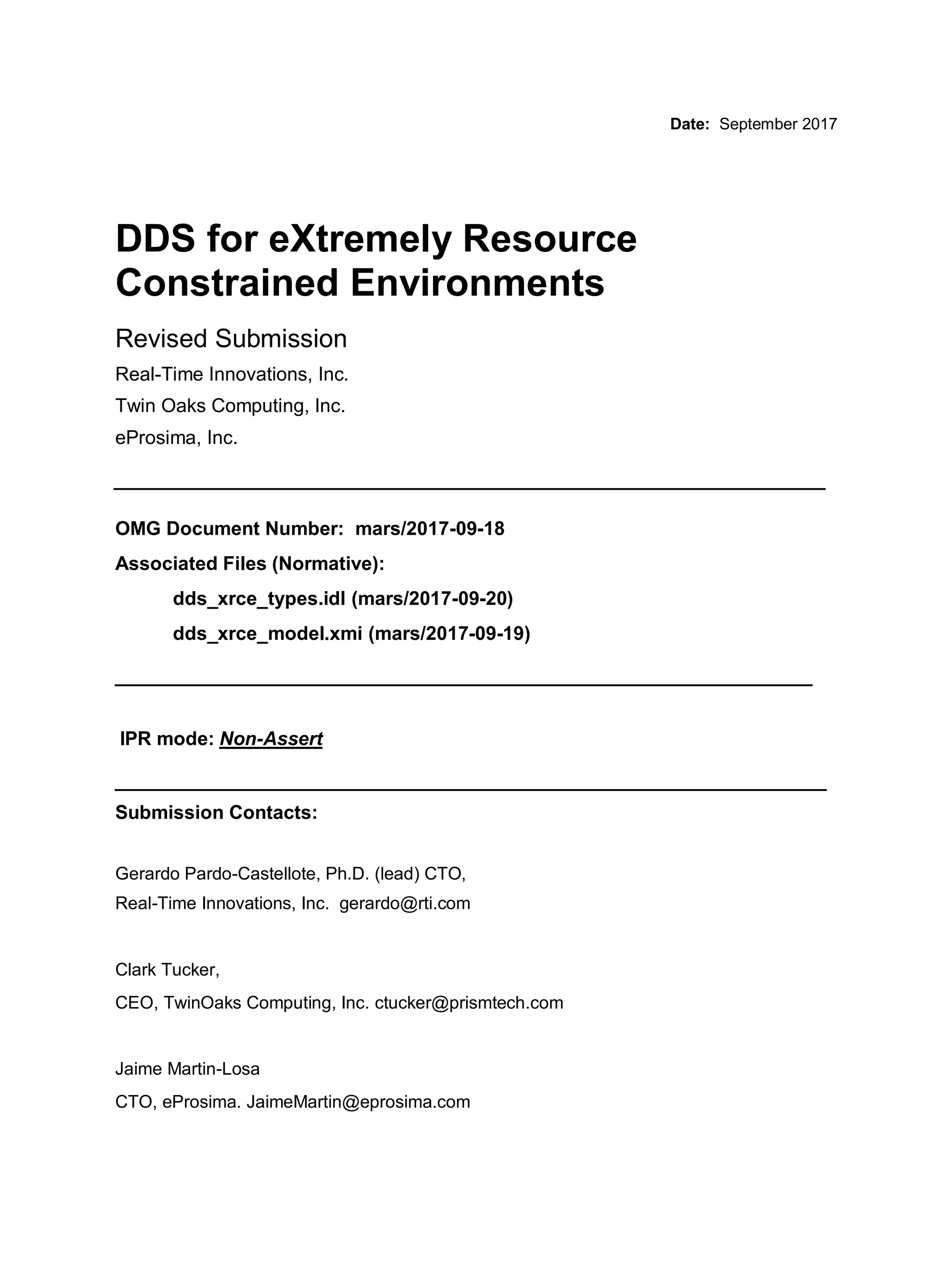
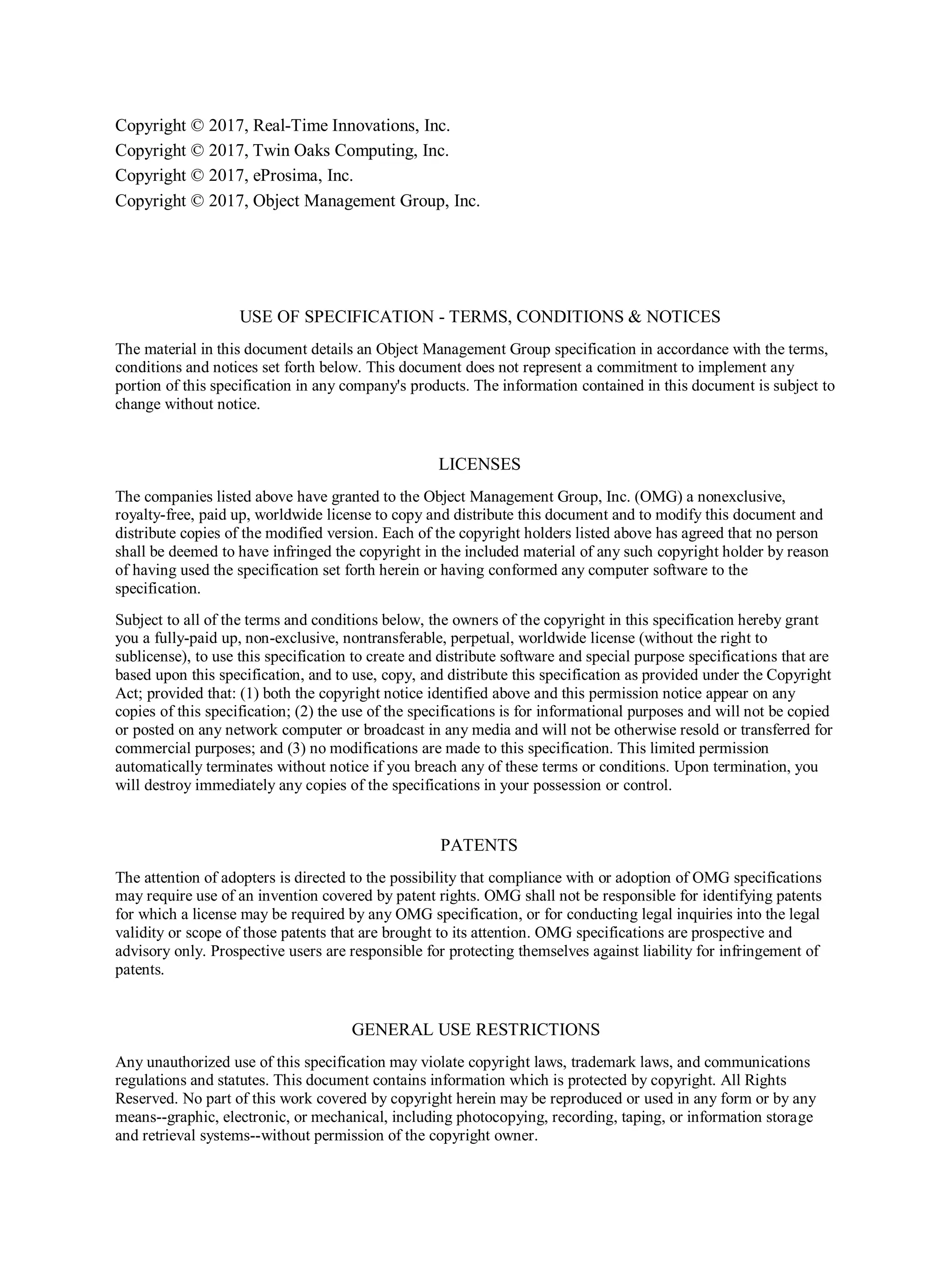
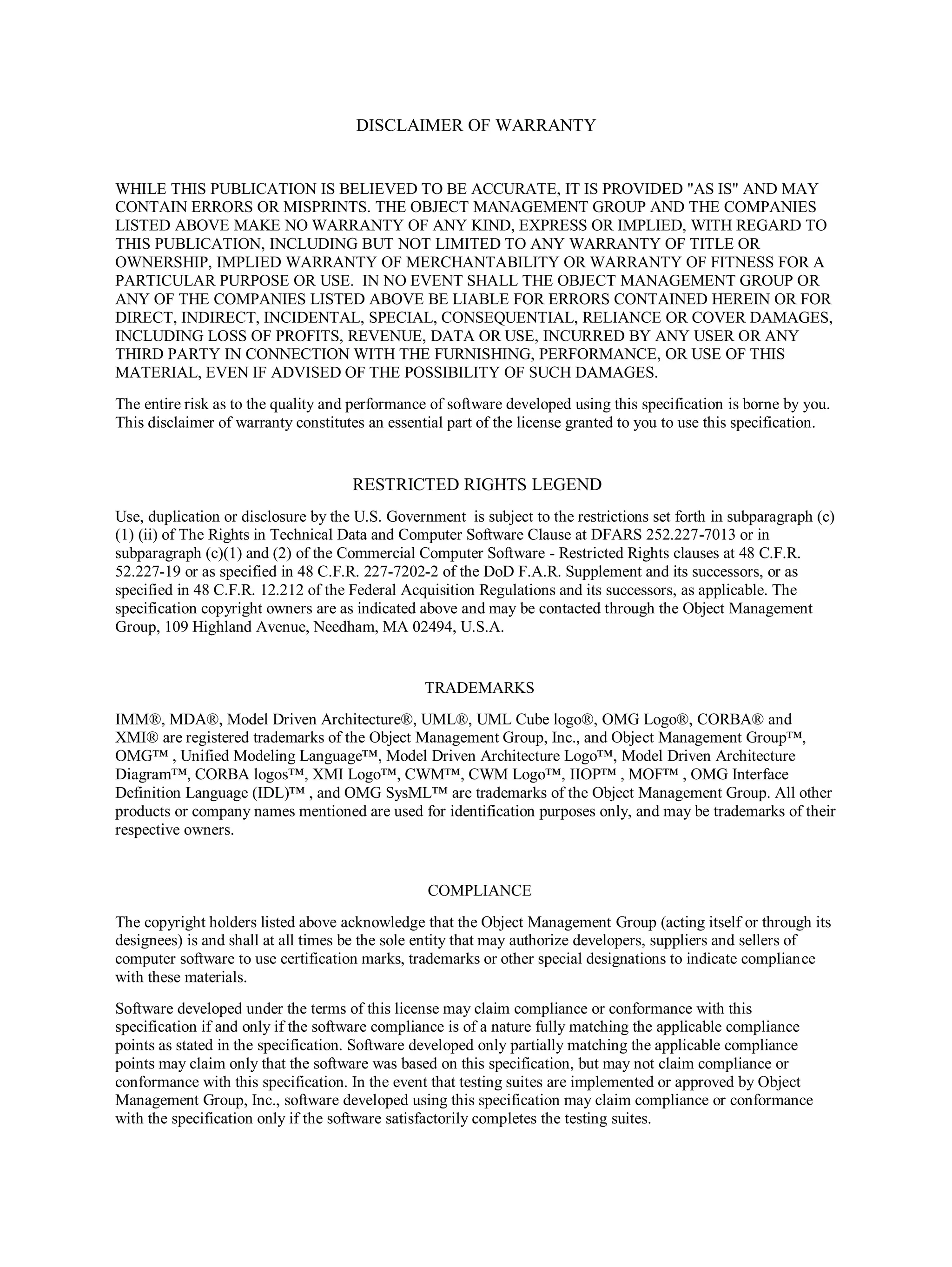



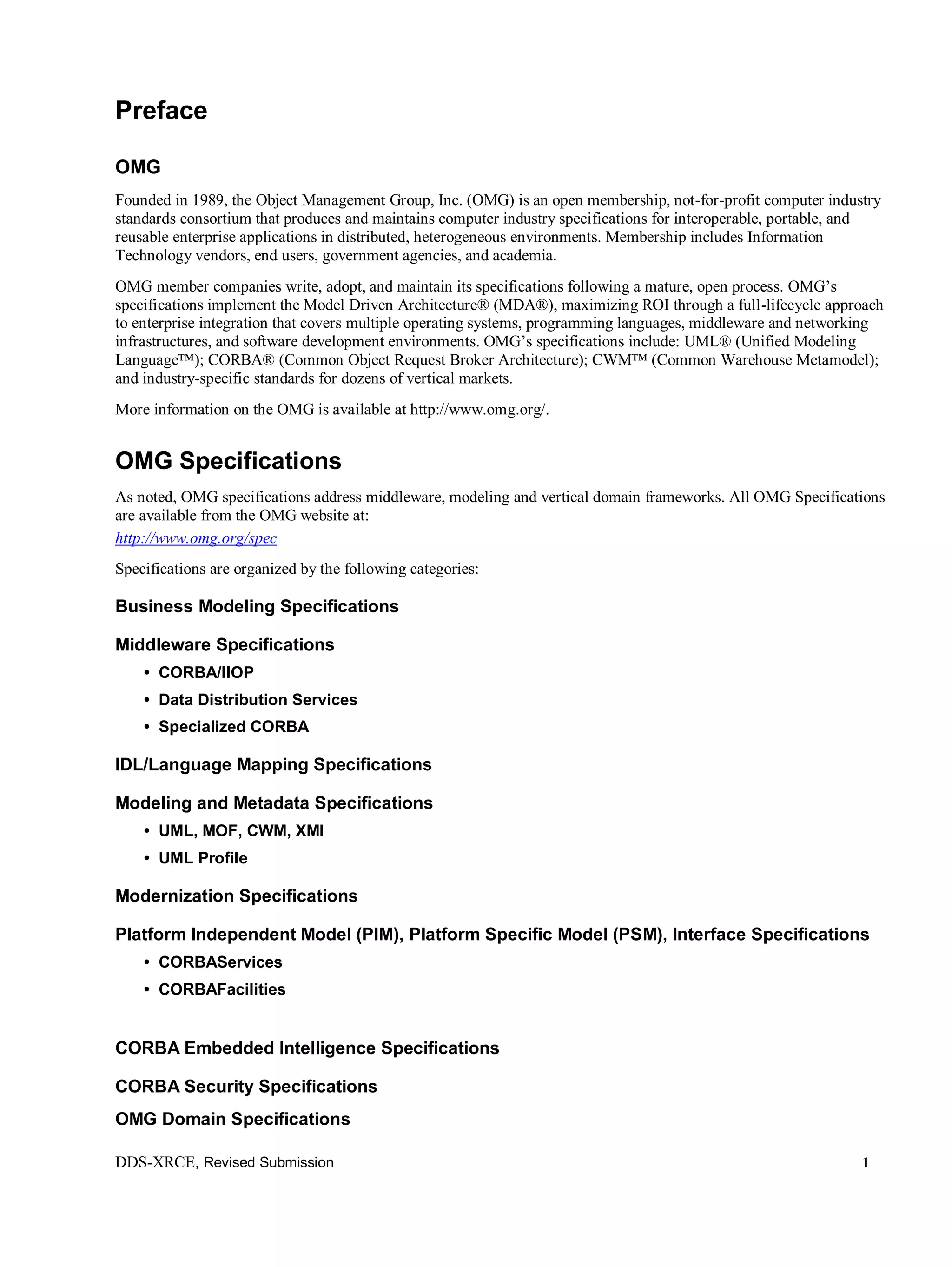
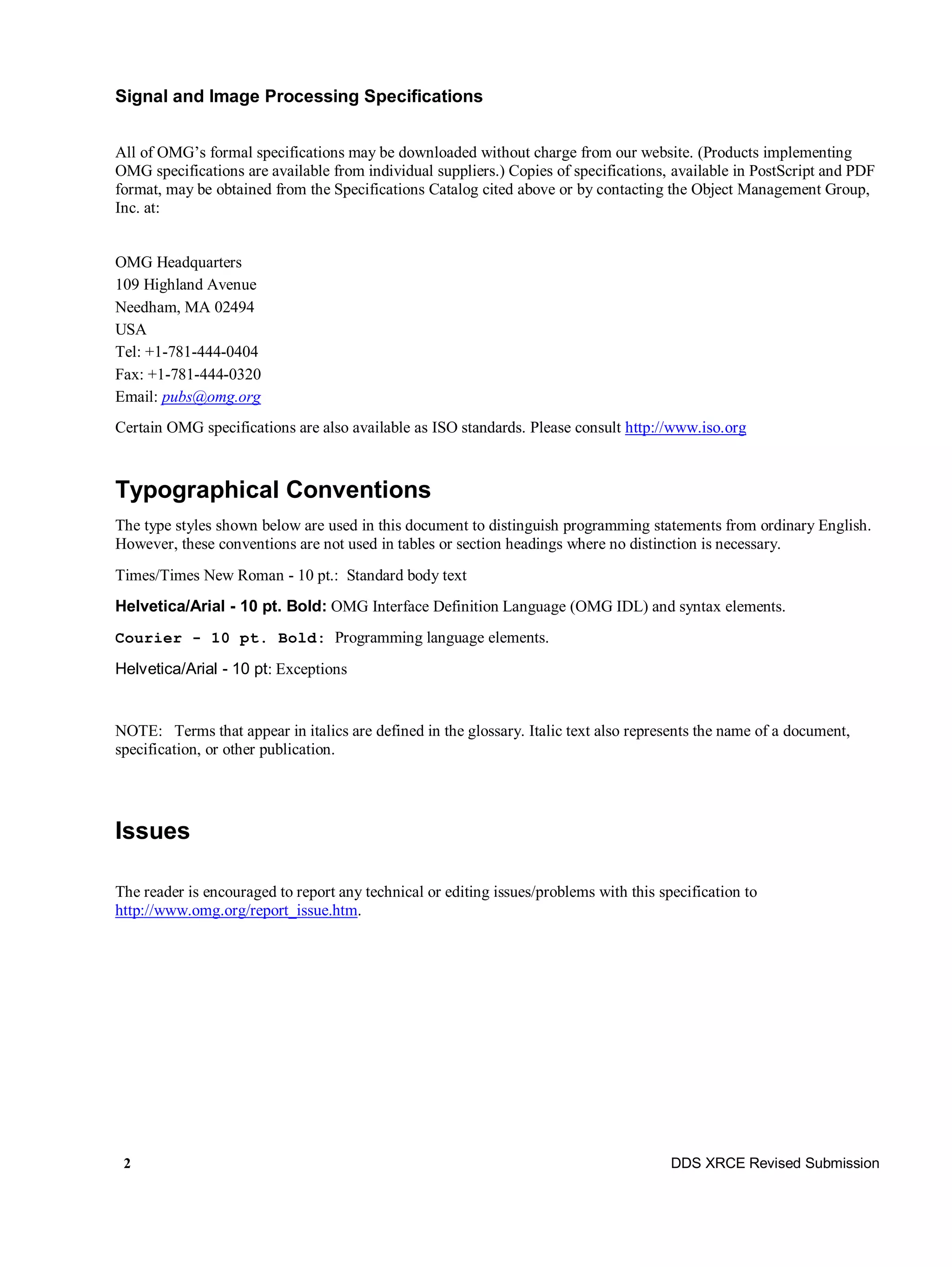
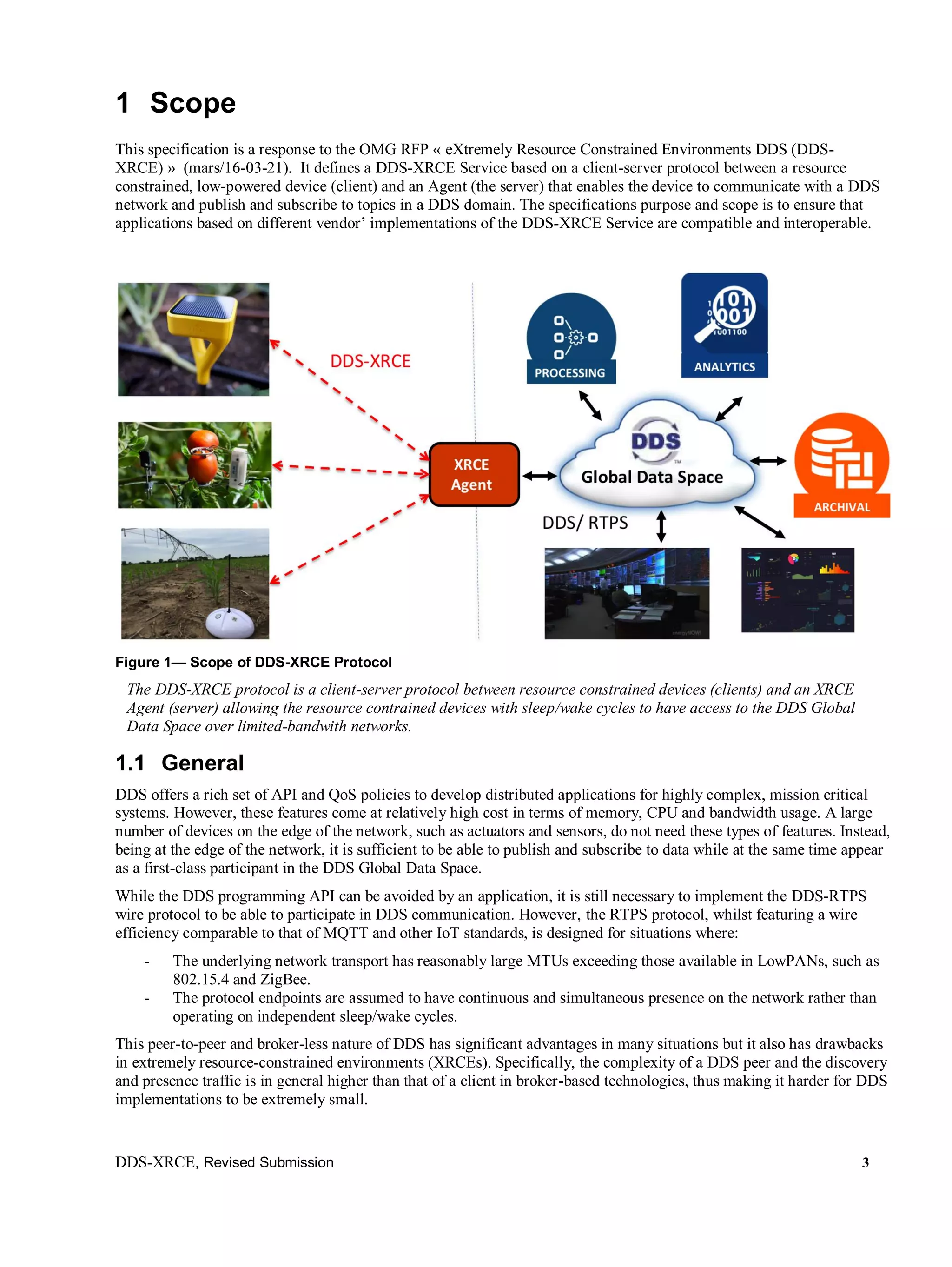
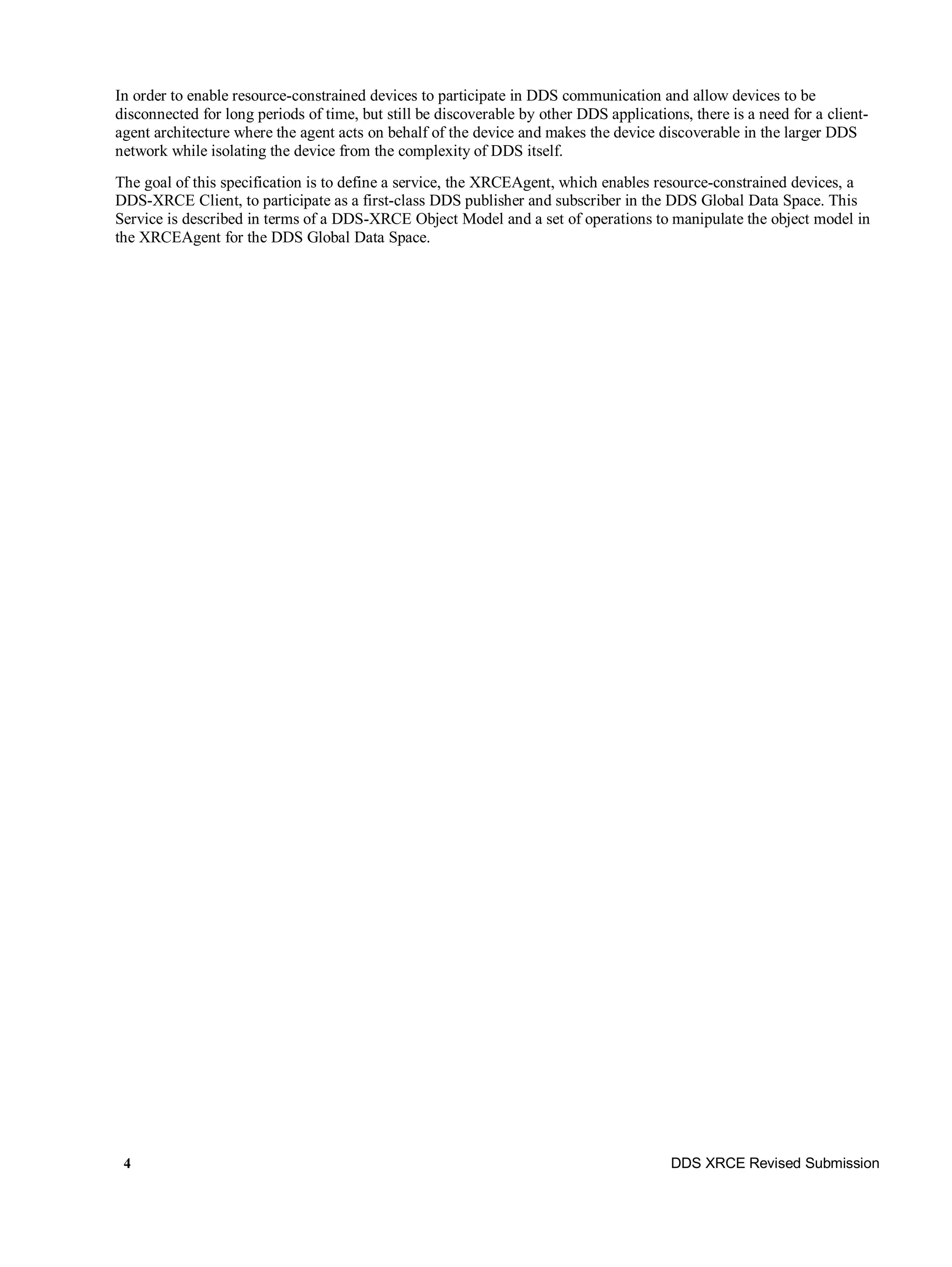

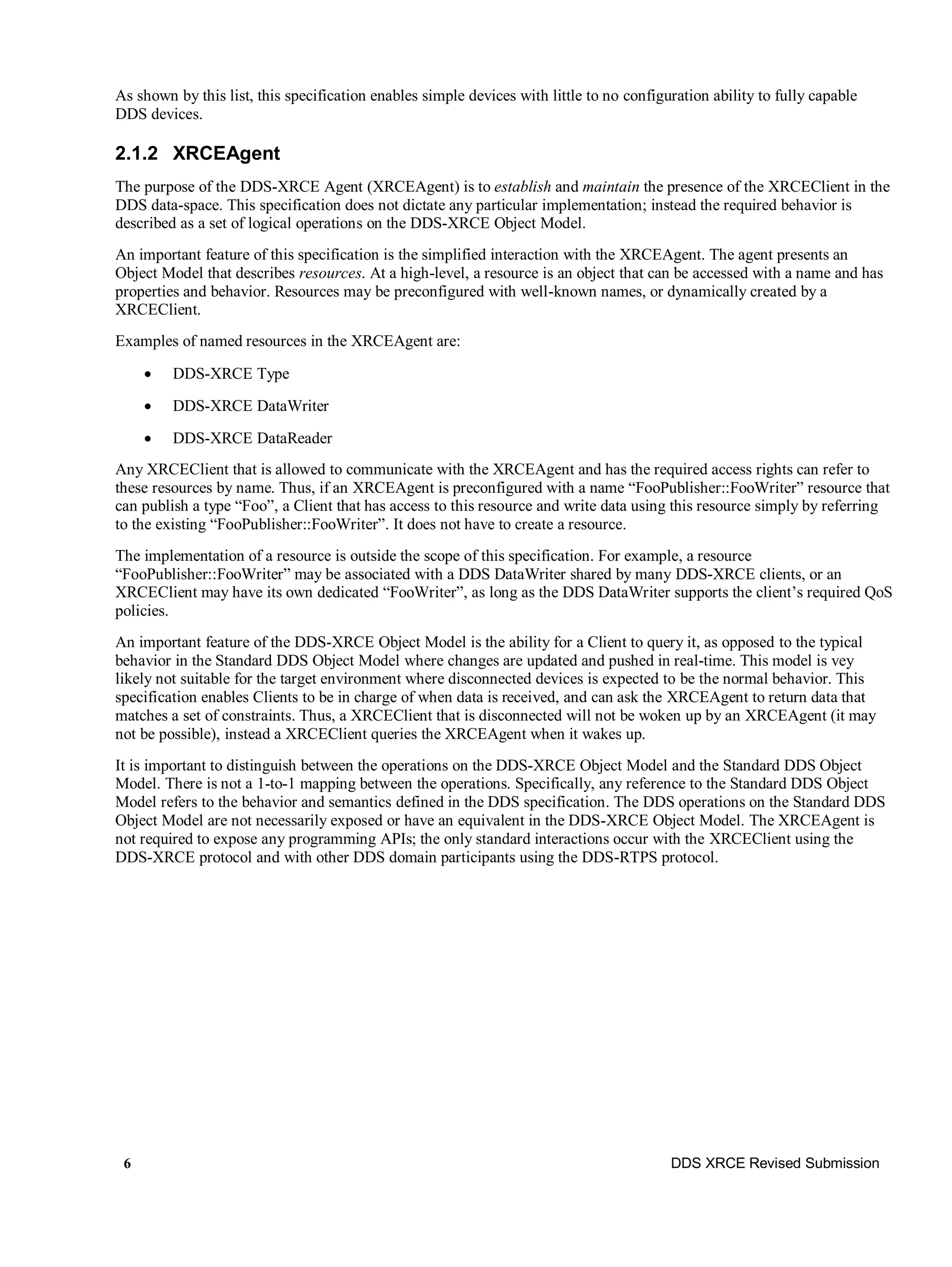
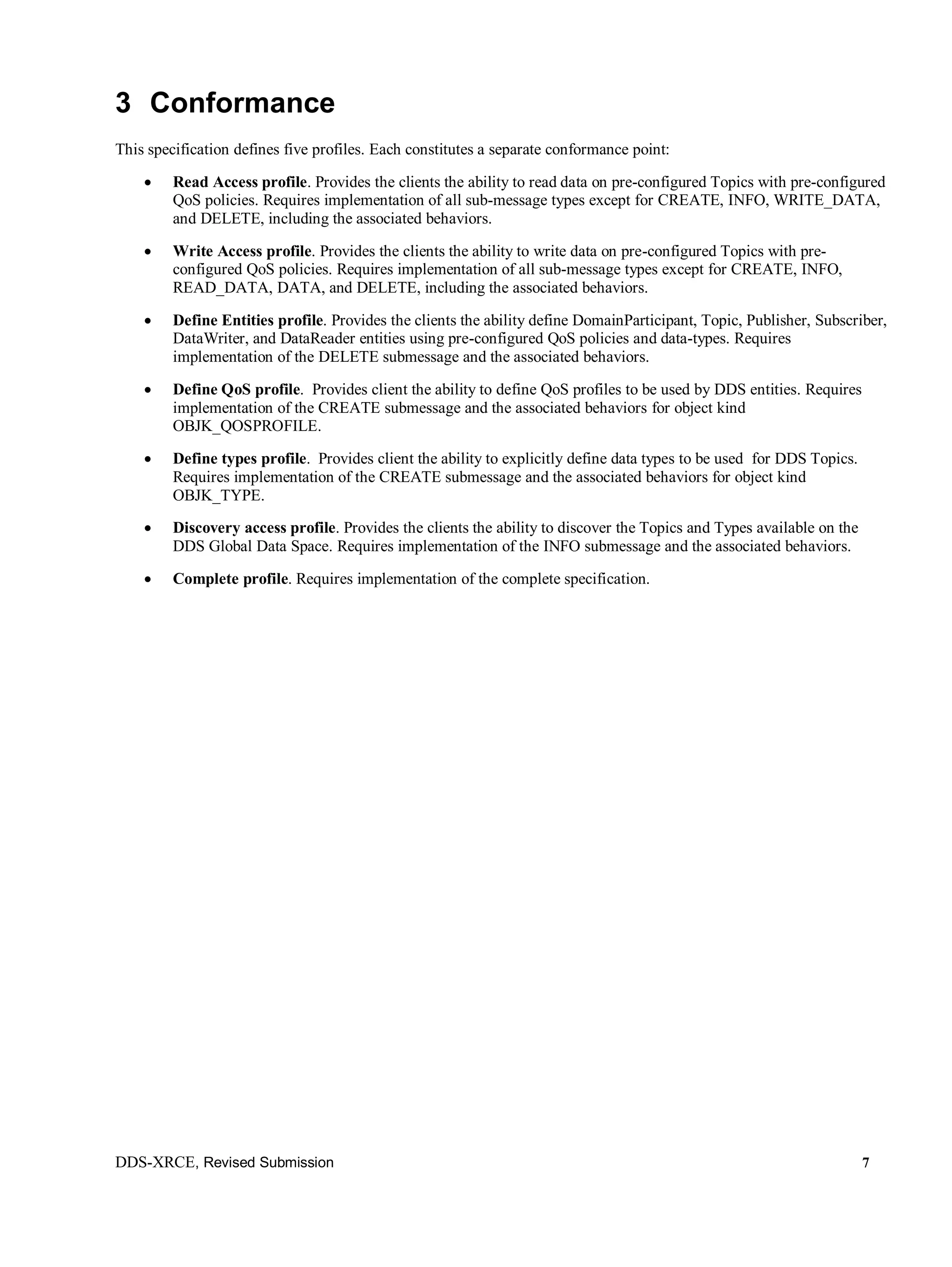
![8 DDS XRCE Revised Submission
4 References
4.1 Normative References
The following normative documents contain provisions that, through reference in this text, constitute provisions of this
specification. For dated references, subsequent amendments to, or revisions of, any of these publications do not apply.
[IETF RFC-1982] Serial Number Arithmetic. https://tools.ietf.org/html/rfc1982
[IDL] Interface Definition Language (IDL), version 4.1, http://www.omg.org/spec/IDL/4.1/
[DDS] Data Distribution Service for Real-Time Systems Specification, version 1.2
http://www.omg.org/spec/DDS/1.2
[DDS-XML] DDS Consolidated XML Syntax, version 1.0, http://www.omg.org/spec/DDS-XML/1.0/
[DDS-XTYPES] Extensible And Dynamic Topic Types for DDS, version 1.2, http://www.omg.org/spec/DDS-
XTypes/1.2/
[UML] Unified Modeling Language, version 2.5, http://www.omg.org/spec/UML/2.5
4.2 Non-normative References](https://image.slidesharecdn.com/ddsxrcemars-17-09-18-171006013244/75/DDS-for-eXtremely-Resource-Constrained-Environments-14-2048.jpg)
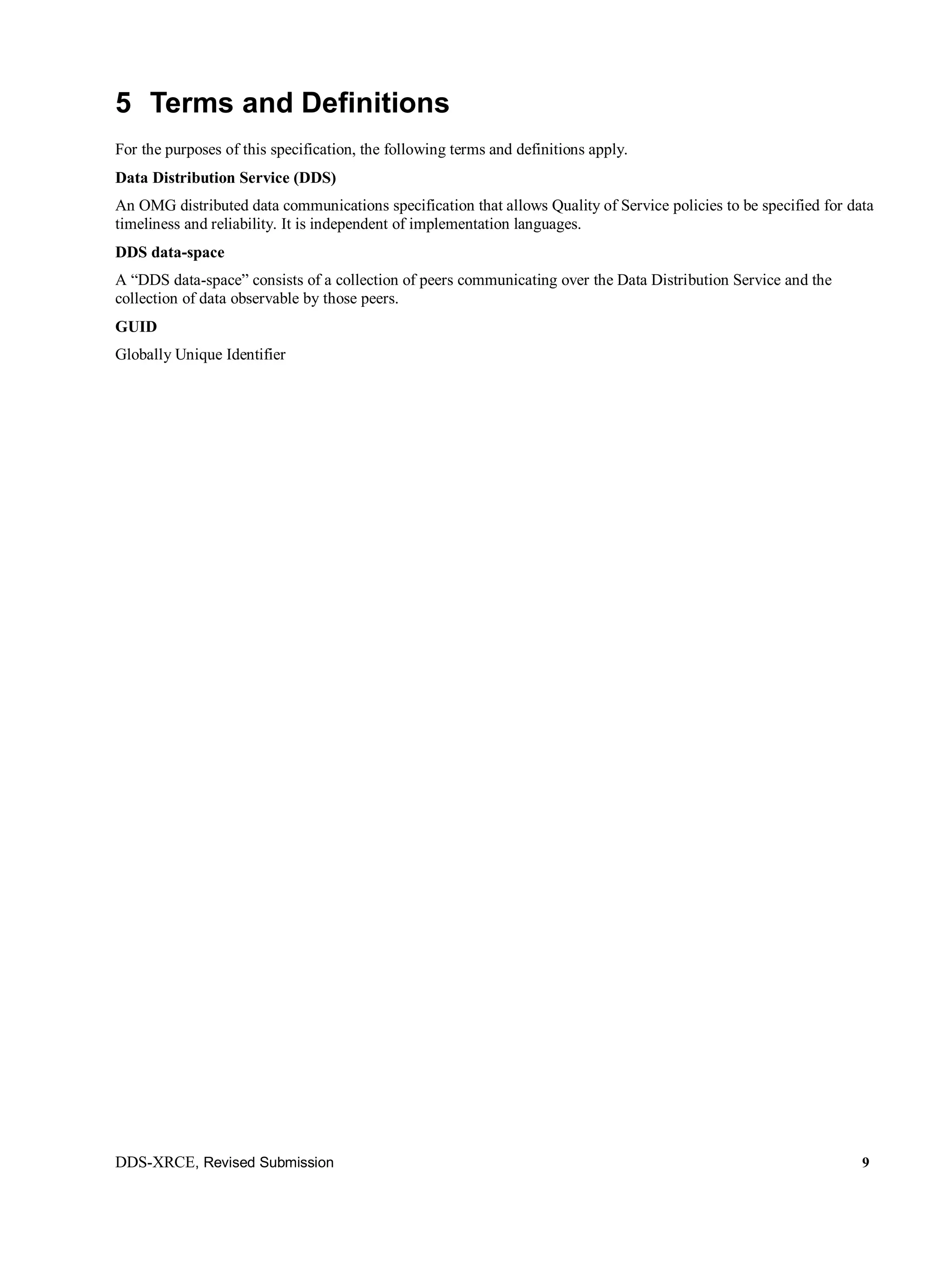
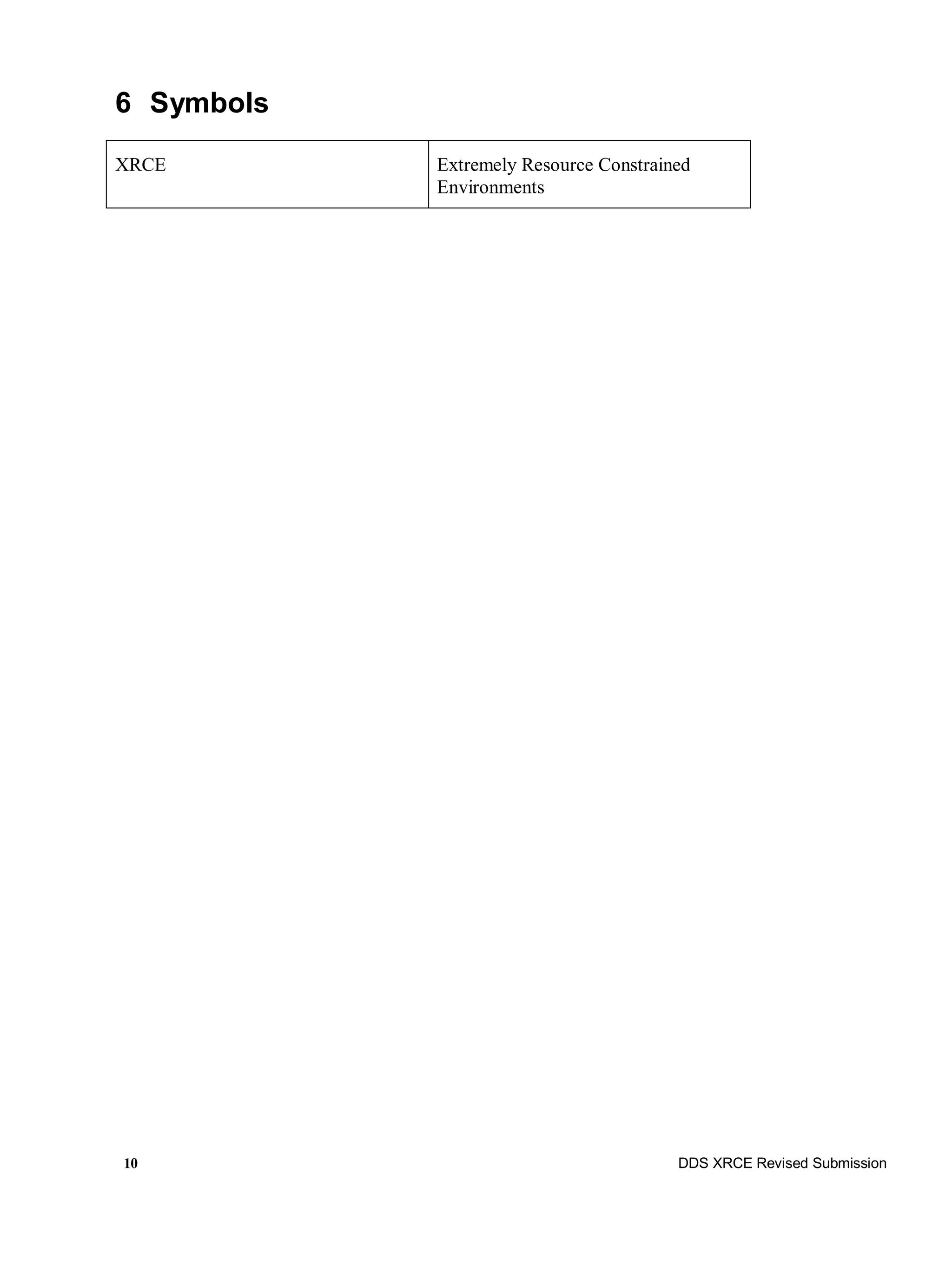
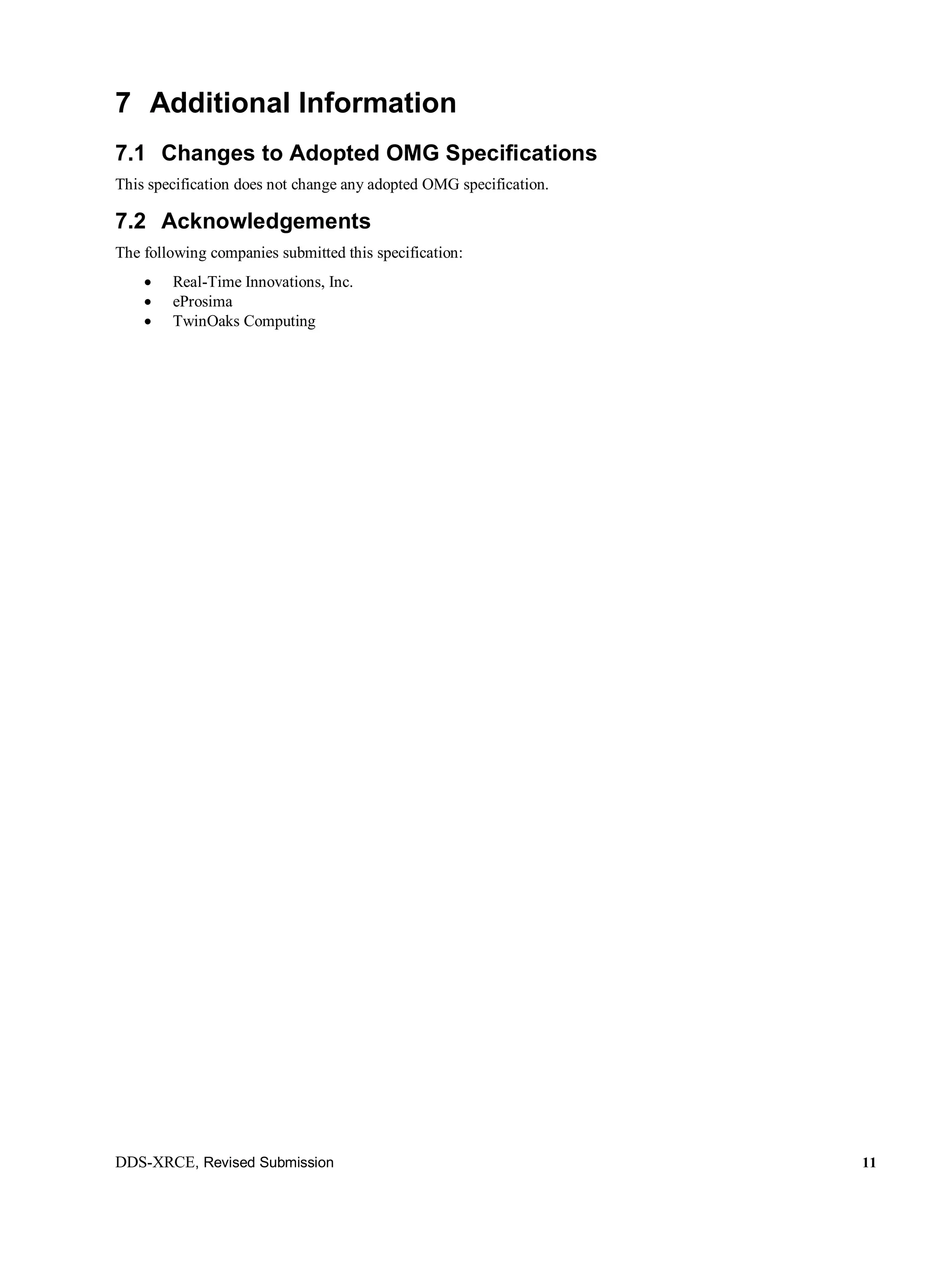
![12 DDS XRCE Revised Submission
8 DDS-XRCE Object Model
8.1 General
This specification defines a wire protocol, the DDS-XRCE protocol, to be used between an XRCE Client and an XRCE
Agent. The XRCE Agent is a DDS Participant in the DDS Global Data Space. The DDS-XRCE protocol allows the
client to use the XRCE Agent as a proxy in order to produce and consume data in the DDS Global Data Space.
To model the interaction between the XRCE Client and the XRCEAgent this specification defines a UML model for the
XRCEAgent. This model, called the DDS-XRCE Object Model, defines the objects, interfaces, and operations to be
implemented by the agent and how they relate to operations on the Standard DDS Object Model as defined in the OMG
Data-Distribution Service Specification [DDS].
The DDS-XRCE protocol is defined as a set of logical messages exchanged between the XRCE Client and the DDS-
XRCEAgent. These messages perform logical actions on the DDS-XRCE Object Model that result in corresponding
actions on the Standard DDS Object Model. The specification of these logical actions fully describes the observable
behavior of the XRCE Agent and its interactions both with the Client and the DDS Global Data Space.
The DDS-XRCE Object Model both extends and simplifies the Standard DDS Object Model. It extends it to provide an
access control model and application management model that support disconnected clients. It simplifies it to reduce the
number of objects and operations and make it more suitable for resource constrained, low-power clients. Despite this
DDS-XRCE offers complete access to the DDS Global Data space. Any DDS Topic may be published or subscribed on
any DDS with any QoS. This is illustrated in Figure 2.
Figure 2— DDS-XRCE Object Model Overview
pkg PIM Overview
XRCEClient
DDSXRCE
+AccessController
+Application
+DataReader
+DataWriter
+DomainParticipant
+EntityName
+ProxyClient
+Publisher
+Qos
+QosLibrary
+QosProfile
+RegisteredType
+ReturnStatus
+Root
+SessionId
+Status
+Submessage
+Subscriber
+Topic
+Type
+Entity
+Submessages
DDS
+Condition
+ContentFilteredTopic
+DataReader
+DataReaderListener
+DataWriter
+DataWriterListener
+DomainEntity
+DomainParticipant
+DomainParticipantFactory
+DomainParticipantListener
+Entity
+GuardCondition
+Listener
+Publisher
+PublisherListener
+QosPolicy
+QueryCondition
+ReadCondition
+SampleInfo
+Status
+StatusCondition
+Subscriber
+SubscriberListener
+Topic
+TopicDescription
+TopicListener
+TypeSupport
+WaitSet
+Qos
Qos
+DataReaderQos
+DataWriterQos
+DomainParticipantQos
+PublisherQos
+SubscriberQos
+TopicQos
(from DDS)
«use»
«use»
«use»](https://image.slidesharecdn.com/ddsxrcemars-17-09-18-171006013244/75/DDS-for-eXtremely-Resource-Constrained-Environments-18-2048.jpg)
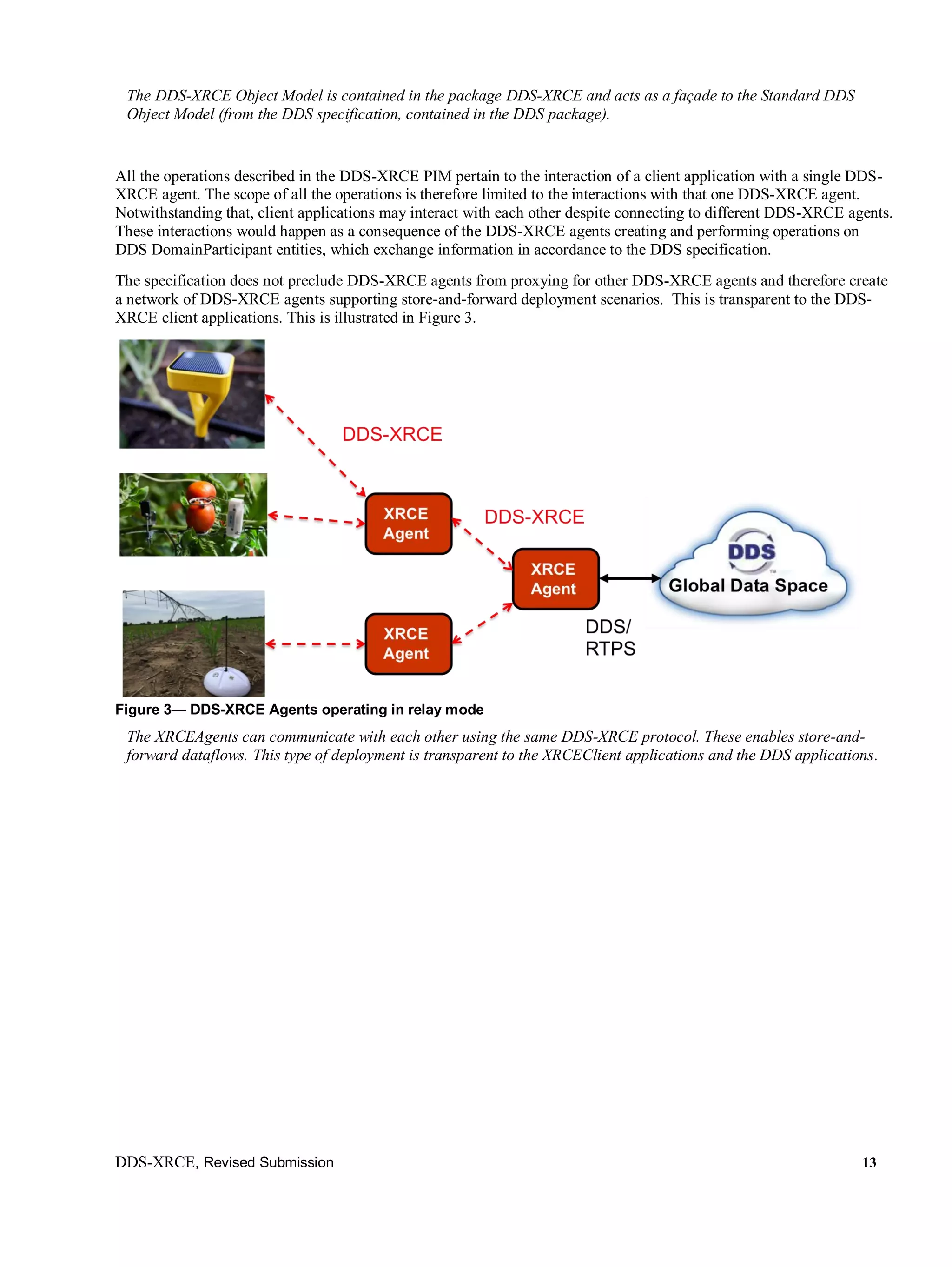

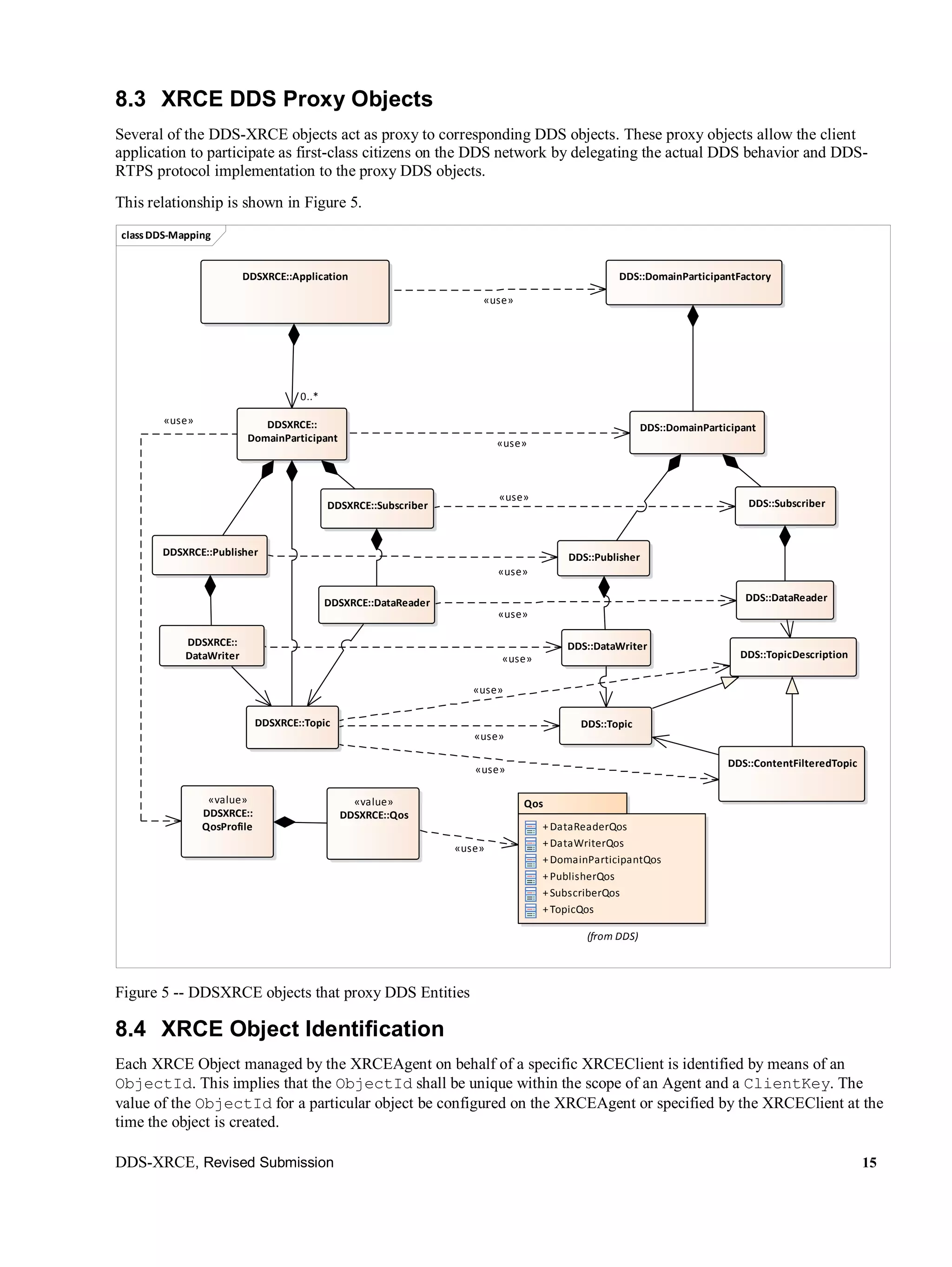
![16 DDS XRCE Revised Submission
There are two reserved values for ObjectId. The value {0x00, 0x00} is referred as OBJECTID_INVALID and
represents an invalid object. The value {0xFF, 0xFF} is referred as OBJECTID_CLIENT and represents the
DDSXRCE::ProxyClient object.
Alternatively, objects may also be identified by a string resourceName. The format of this name depends on the resource
and provides a way to refer to a resource configured on the agent using a configuration file or similar means.
8.5 Data types used to model operations on XRCE Objects
The operations on the XRCE objects accept parameters. The format of these parameters is described as a set of IDL data
types. These IDL descriptions are used both in the description of the XRCE Object operations as well as to define the
wire representation of the messages exchanged between the Client and the Agent.
The IDL definitions for the data types shall be as specified in Annex A IDL Types.
The following sub clauses provide explanations for some of the key data types specified in Annex A IDL Types.
8.5.1 Data and Samples
When the XRCEAgent sends data to the XRCEClient it may use one of four possible formats. The difference is whether
the data is sent by itself, or accompanied with meta-data such as timestamp and sequence numbers. Another difference is
whether the message contains a single sample or a sequence of those.
While it would be possible to combine all these representations into a single type (e.g. a union) this would introduce
additional bytes in the serialization which is undesirable in extremely resource-constrained environments.
The five possible representation are: SampleData, Sample, SampleDataSeq, SampleSeq, and
SamplePackedData. They respectively correspond to the DataFormat values FORMAT_DATA,
FORMAT_DATA_SEQ, FORMAT_SAMPLE, FORMAT_SAMPLE_SEQ, and FORMAT_PACKED. Their IDL
definition shall be as specified in Annex A IDL Types.
All these representations serialize the data XCDR representation defined in [DDS-XTYPES]. For example, the definition
of the SampleData is given by the IDL:
@extensibility(FINAL)
struct SampleData {
XCDRSerializedBuffer serialized_data;
};
In this structure the XCDRSerializedBuffer represents the bytes resulting from serializing the specific application
data type being sent using the XCDR rules defined in clause 7.4 of [DDS-XTYPES].
Other representations end up including a SampleData to hold the serialized application data. For example Sample is
defined as:
@extensibility(FINAL)
struct Sample {
SampleInfo info;
SampleData data;
};
8.5.2 DataRepresentation
The DataRepresentation type is used to hold values of data samples as well as additional sample information such](https://image.slidesharecdn.com/ddsxrcemars-17-09-18-171006013244/75/DDS-for-eXtremely-Resource-Constrained-Environments-22-2048.jpg)
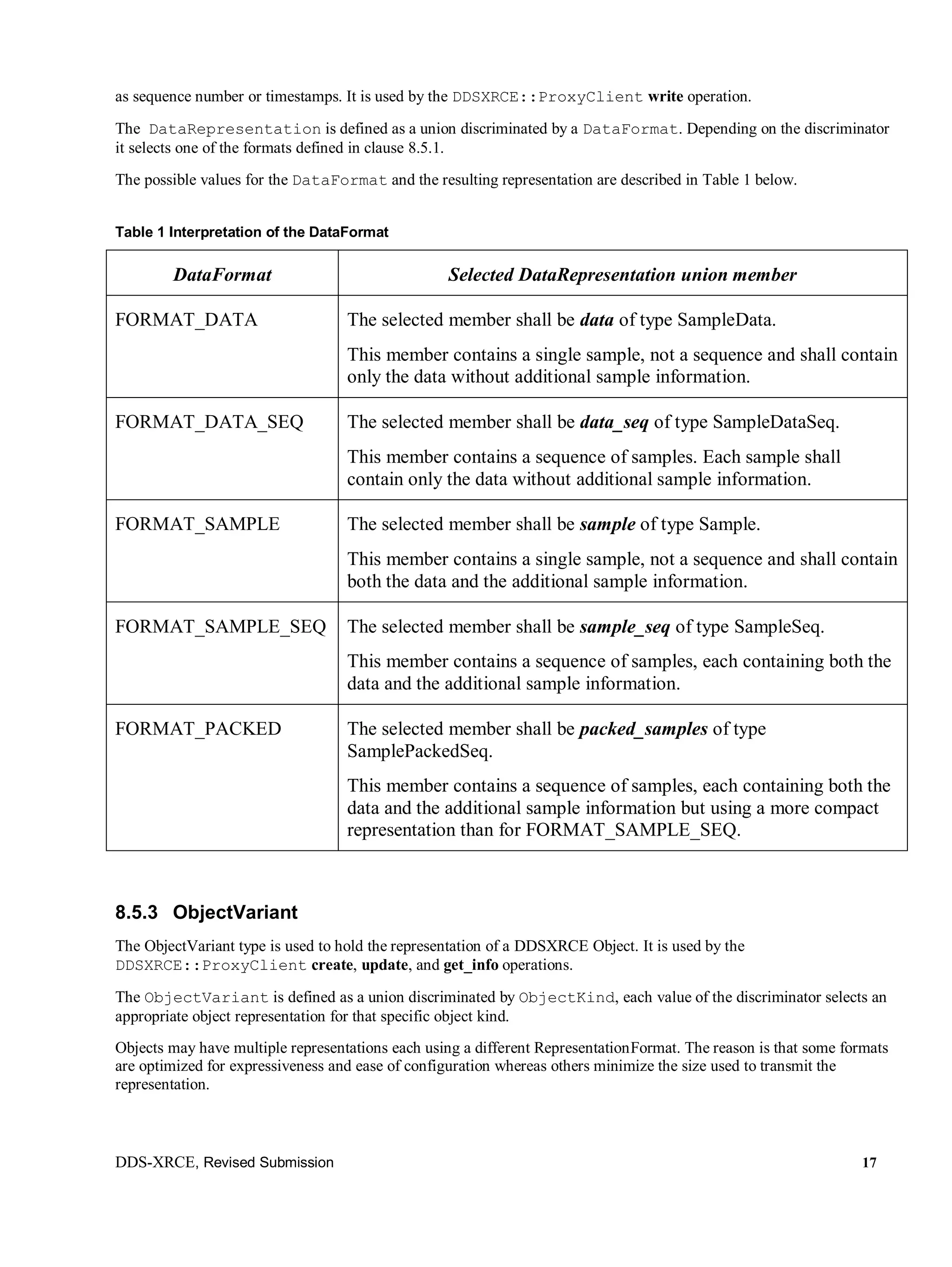
![18 DDS XRCE Revised Submission
There are three supported RepresentationFormat values: REPRESENTATION_BY_REFERENCE,
REPRESENTATION_AS_XML_STRING, and REPRESENTATION_IN_BINARY.
The REPRESENTATION_BY_REFERENCE uses a string_reference. This string refers by name to a
description already known to the XRCEAgent. This can be used to represent any object in an extremely
compact manner. But requires pre-configuration of the XRCEAgent. The rules for referring to objects
preconfigured in the XRCEAgent follow the for object references in the [DDS-XML] specification.
The REPRESENTATION_AS_XML_STRING represents the object using XML. This can be used to
dynamically represent any object at the expense of the verbosity introduced by the XML format. The XML
format follows the standard defined in [DDS-XML].
The REPRESENTATION_IN_BINARY represents objects using a binary representation obtained by serializing
using XCDR an IDL-defined data-structure that depends on the kind of object. This representation is very
compact but it can only be used to represent a subset of the objects. For example not all DDS QoS can be
expressed using the binary representation.
The following subsections provide details of the ObjectVariant representation for each kind of object.
8.5.3.1 DDSXRCE::QosProfile
The OBJK_QOSPROFILE_Representation supports only the REPRESENTATION_BY_REFERENCE and
REPRESENTATION_AS_XML_STRING.
When using the REPRESENTATION_BY_REFERENCE the object_reference field shall contain the name of a
QosProfile known to the XRCEAgent.
When using the REPRESENTATION_AS_XML_STRING the string_representation field shall contain the XML
representation of a QosProfile as defined in [DDS-XML].
The REPRESENTATION_BY_REFERENCE XML representation may reference other QoS profiles already known to
the Agent. This includes profiles were pre-configured or pre-loaded to the Agent. This feature allows a compact
representation of a QosProfile that simply references an existing one as in:
<qos_profile base_name=”MyQosLib:MyQosProfile”/>
This feature also allows a compact way to represent a QosProfile that differs slightly from an existing one:
<qos_profile base_name=”MyQosLib:MyQosProfile”>
<data_reader_qos>
<reliability><kind>RELIABLE_RELIABILITY_QOS</kind><reliability>
<data_reader_qos>
</qos_profile>
8.5.3.2 DDSXRCE::Type
The OBJK_TYPE_Representation supports the three representations: REPRESENTATION_BY_REFERENCE,
REPRESENTATION_AS_XML_STRING, and REPRESENTATION_IN_BINARY.
When using the REPRESENTATION_BY_REFERENCE the object_reference field shall contain the name of a
DDSXRCE::Type known to the XRCEAgent.
When using the REPRESENTATION_AS_XML_STRING the string_representation field shall contain the XML
representation of the DDS Type as defined in [DDS-XML] and [DDS-XTYPES].](https://image.slidesharecdn.com/ddsxrcemars-17-09-18-171006013244/75/DDS-for-eXtremely-Resource-Constrained-Environments-24-2048.jpg)
![DDS-XRCE, Revised Submission 19
When using the REPRESENTATION_IN_BINARY the binary_representation shall contain the XCDR serialization of
the structure OBJK_Type_Binary defined in Annex A IDL Types. This representation uses the TypeIdentifier defined in
and [DDS-XTYPES] to uniquely identify the type. However it does not describe the structure of the type.
Independent of the representation format, the additional members in OBJK_TYPE_Representation shall be interpreted as
specified below.
The participant_id contains the ObjectId of a DDSXRCE DomainParticipant object that proxies for the DDS
DomainParticipant used to register the DDS data-type with DDS.
The registered_type_name contains the name passed to the DDS TypeSupport register_type operation.
8.5.3.3 DDSXRCE::Application
The OBJK_APPLICATION_Representation supports only the REPRESENTATION_BY_REFERENCE and
REPRESENTATION_AS_XML_STRING.
When using the REPRESENTATION_BY_REFERENCE the object_reference field shall contain the name of a
DDSXRCE Application definition known to the Agent.
When using the REPRESENTATION_AS_XML_STRING the string_representation shall contain the XML
representation of an Application as defined in [DDS-XML].
8.5.3.4 DDSXRCE::DomainParticipant
The OBJK_PARTICIPANT_Representation supports only the REPRESENTATION_BY_REFERENCE and
REPRESENTATION_AS_XML_STRING.
The OBJK_PARTICIPANT_Representation contains s string field named as_string.
When using the REPRESENTATION_BY_REFERENCE the object_reference field shall contain the name of a
DDSXRCE DomainParticipant definition known to the Agent.
When using the REPRESENTATION_AS_XML_STRING the string_representation field shall contain the XML
representation of a DomainParticipant as defined by [DDS-XML].
8.5.3.5 DDSXRCE::Topic
The OBJK_TOPIC_Representation supports the three representations: REPRESENTATION_BY_REFERENCE,
REPRESENTATION_AS_XML_STRING, and REPRESENTATION_IN_BINARY.
When using the REPRESENTATION_BY_REFERENCE the object_reference field shall contain the name of a
DDSXRCE Topic definition known to the Agent.
When using the REPRESENTATION_AS_XML_STRING the string_representation field shall contain the XML
representation of a Topic as defined by [DDS-XML]
When using the REPRESENTATION_IN_BINARY the binary_representation shall contain the XCDR serialization of
the structure OBJK_Topic_Binary defined in Annex A IDL Types.
Independent of the representation format, the additional members in OBJK_TYPE_Representation shall be interpreted as
specified below.
The participant_id shall contain the ObjectId of a DDSXRCE DomainParticipant object that proxies for the
DDS DomainParticipant used to create the DDS Topic.
8.5.3.6 DDSXRCE::Publisher
The OBJK_PUB_Representation supports the three representations: REPRESENTATION_BY_REFERENCE,
REPRESENTATION_AS_XML_STRING, and REPRESENTATION_IN_BINARY.](https://image.slidesharecdn.com/ddsxrcemars-17-09-18-171006013244/75/DDS-for-eXtremely-Resource-Constrained-Environments-25-2048.jpg)
![20 DDS XRCE Revised Submission
When using the REPRESENTATION_BY_REFERENCE the object_reference field shall contain the name of a
DDSXRCE Publisher definition known to the Agent.
When using the REPRESENTATION_AS_XML_STRING the string_representation field shall contain the XML
representation of a Publisher as defined by [DDS-XML].
When using the REPRESENTATION_IN_BINARY the binary_representation shall contain the XCDR serialization of
the structure OBJK_Publisher_Binary defined in Annex A IDL Types.
Independent of the representation format, the additional members in OBJK_PUB_Representation shall be interpreted as
specified below.
The participant_id shall contain the ObjectId of a DDSXRCE DomainParticipant object that proxies for the
DDS DomainParticipant used to create the DDS Publisher.
8.5.3.7 DDSXRCE::Subscriber
The OBJK_SUB_Representation supports the three representations: REPRESENTATION_BY_REFERENCE,
REPRESENTATION_AS_XML_STRING, and REPRESENTATION_IN_BINARY.
When using the REPRESENTATION_BY_REFERENCE the object_reference field shall contain the name of a
DDSXRCE Subscriber definition known to the Agent.
When using the REPRESENTATION_AS_XML_STRING the string_representation field shall contain the XML
representation of a Subscriber as defined by [DDS-XML].
When using the REPRESENTATION_IN_BINARY the binary_representation shall contain the XCDR serialization of
the structure OBJK_Subscriber_Binary defined in Annex A IDL Types.
Independent of the representation format, the additional members in OBJK_SUB_Representation shall be interpreted as
specified below.
The participant_id shall contain the ObjectId of a DDSXRCE DomainParticipant object that proxies for the
DDS DomainParticipant used to create the DDS Subscriber.
8.5.3.8 DDSXRCE::DataWriter
The OBJK_DW_Representation supports the three representations: REPRESENTATION_BY_REFERENCE,
REPRESENTATION_AS_XML_STRING, and REPRESENTATION_IN_BINARY.
When using the REPRESENTATION_BY_REFERENCE the object_reference field shall contain the name of a
DDSXRCE DataWriter definition known to the Agent.
When using the REPRESENTATION_AS_XML_STRING the string_representation field shall contain the XML
representation of a DataWriter as defined by [DDS-XML].
When using the REPRESENTATION_IN_BINARY the binary_representation shall contain the XCDR serialization of
the structure OBJK_DataWriter_Binary defined in Annex A IDL Types.
Independent of the representation format, the additional members in OBJK_DW_Representation shall be interpreted as
specified below.
The publisher_id shall contain the ObjectId of a DDSXRCE Publisher object that proxies for the DDS
Publisher used to create the DDS DataWriter.
The participant_id shall contain the ObjectId of a DDSXRCE DomainParticipant object that proxies for the
DDS DomainParticipant to whom the aforementioned DDS Publisher belongs.](https://image.slidesharecdn.com/ddsxrcemars-17-09-18-171006013244/75/DDS-for-eXtremely-Resource-Constrained-Environments-26-2048.jpg)
![DDS-XRCE, Revised Submission 21
8.5.3.9 DDSXRCE::DataReader
The OBJK_DR_Representation supports the three representations: REPRESENTATION_BY_REFERENCE,
REPRESENTATION_AS_XML_STRING, and REPRESENTATION_IN_BINARY.
When using the REPRESENTATION_BY_REFERENCE the object_reference field shall contain the name of a
DDSXRCE DataReader definition known to the Agent.
When using the REPRESENTATION_AS_XML_STRING the string_representation field shall contain the XML
representation of a DataReader as defined by [DDS-XML].
When using the REPRESENTATION_IN_BINARY the binary_representation shall contain the XCDR serialization of
the structure OBJK_DataReader_Binary defined in Annex A IDL Types.
Independent of the representation format, the additional members in OBJK_DR_Representation shall be interpreted as
specified below.
The subscriber_id shall contain the ObjectId of a DDSXRCE Subscriber object that proxies for the DDS
Subscriber used to create the DDS DataReader.
The participant_id shall contain the ObjectId of a DDSXRCE DomainParticipant object that proxies for the
DDS DomainParticipant to whom the aforementioned DDS Subscriber belongs.
8.6 XRCE Object operations
8.6.1 Use of the ClientKey
All operations are performed within the context of a ClientKey with is used both to authenticate and identify the
client:
The ClientKey is assigned to each client. The ClientKey uniquely identifies the client to a particular
agent. The ClientKey is associated with a set of permissions for the client within the agent.
The ClientKey shall be considered secret. It needs to be configured both on the Client and in the Agent. The
creation and configuration is outside the scope of this specification.
The ClientKey shall not be interpreted.
With the exception of the operation DDSXRCE::Root create_client all other operations expect that the ClientKey
references an already exiting DDSXRCE::ProxyClient. If this is not the case the operation shall fail.
To avoid information leakage that could compromise security, the failure to locate a ClientKey may in some cases
result in a returnValue having STATUS_ERR_NOCLIENT while in others it may silently drop the connection to the
client.
The Agent shall maintain a counter on the number of times the STATUS_ERR_NOCLIENT was sent on an established
connection and once a certain threshold is crossed it shall close the connection. The agent may subsequently refuse or
throttle new connections originating from the same client transport endpoint that was previously closed. The specific
details of this behavior are implementation specific and left outside the scope of this specification.
8.6.2 DDSXRCE::Root
The DDSXRCE::Root object represents the Agent. An DDSXRCE::Agent is a singleton object that all agents shall have.
The DDSXRCE::Root is responsible for authenticating client applications and creating the DDSXRCE::ProxyClient
object associated with each client.
The logical operations on the DDSXRCE::Root are shown in Table 2.](https://image.slidesharecdn.com/ddsxrcemars-17-09-18-171006013244/75/DDS-for-eXtremely-Resource-Constrained-Environments-27-2048.jpg)
![22 DDS XRCE Revised Submission
Table 2-- DDSXRCE::Root operations
create_client ResultStatus
object_representation OBJK_CLIENT_Representation
delete_client ResultStatus
8.6.2.1 Operation create_client
Inputs
object_representation (OBJK_CLIENT_Representation) a representation of the Client.
Outputs
returnValue (ResultStatus): Indicates whether the operation succeeded and the current status of the object. The
object_id in the returnValue shall be set to match the object_id input parameter.
The object_representation shall contain an OBJK_CLIENT_Representation which is used to initialize the
DDSXRCE::ProxyClient. The XRCEAgent shall perform the following checks and actions based on the information
found within the The object_representation:
Check the xrce_cookie to ensure it matches the predefined XRCE_COOKIE constant. If it does not match the
creation shall fail and set the returnValue to{STATUS_LAST_OP_CREATE,
STATUS_ERR_INVALID_DATA}.
Check that the major version (xrce_version[0]) matches the XRCE_VERSION_MAJOR. If it does not match,
the creation shall fail and set the returnValue to {STATUS_LAST_OP_CREATE,
STATUS_ERR_INCOMPATIBLE}.
Check the client_key is authorized to connect to the XRCEAgent. If this check fails the operation shall fail and
set the returnValue to {STATUS_LAST_OP_CREATE, STATUS_ERR_DENIED}.
Check if there is an existing DDSXRCE::ProxyClient object associated with the same ClientKey and if
so compare the session_id of the existing ProxyClient with the one in the object_representation:
o If a ProxyClient exists and has the same session_id then the operation shall not perform any action
and shall set the returnValue to {STATUS_LAST_OP_CREATE,STATUS_OK}.
o If a ProxyClient exist and has a different session_id then the operation shall delete the existing
DDSXRCE::ProxyClient object and shall proceed as if the ProxyClient did not exist.
Check there are sufficient internal resources to complete the create operation. If there are not, then the operation
shall fail and set the returnValue to {STATUS_LAST_OP_CREATE, STATUS_ERR_RESOURCES}.
All communication state between a client and an Agent is managed by the associated ProxyClient. Therefore
deletion of an existing ProxyClient resets any prior communication state between the client and the agent. Any
messages that were cached pending acknowledgments shall be discarded.
The Agent shall create a ProxyClient object and shall:
Initialize its state to have the specified session_id.
Initialize the builtin streams with sequence number 0.
Set the returnValue to {STATUS_LAST_OP_CREATE, STATUS_OK}.
The Agent may use the client’s_timestamp to detect time-synchronization differences between the XRCEClient and the
XRCEAgent. The use of this information is left outside the scope of this specification.](https://image.slidesharecdn.com/ddsxrcemars-17-09-18-171006013244/75/DDS-for-eXtremely-Resource-Constrained-Environments-28-2048.jpg)

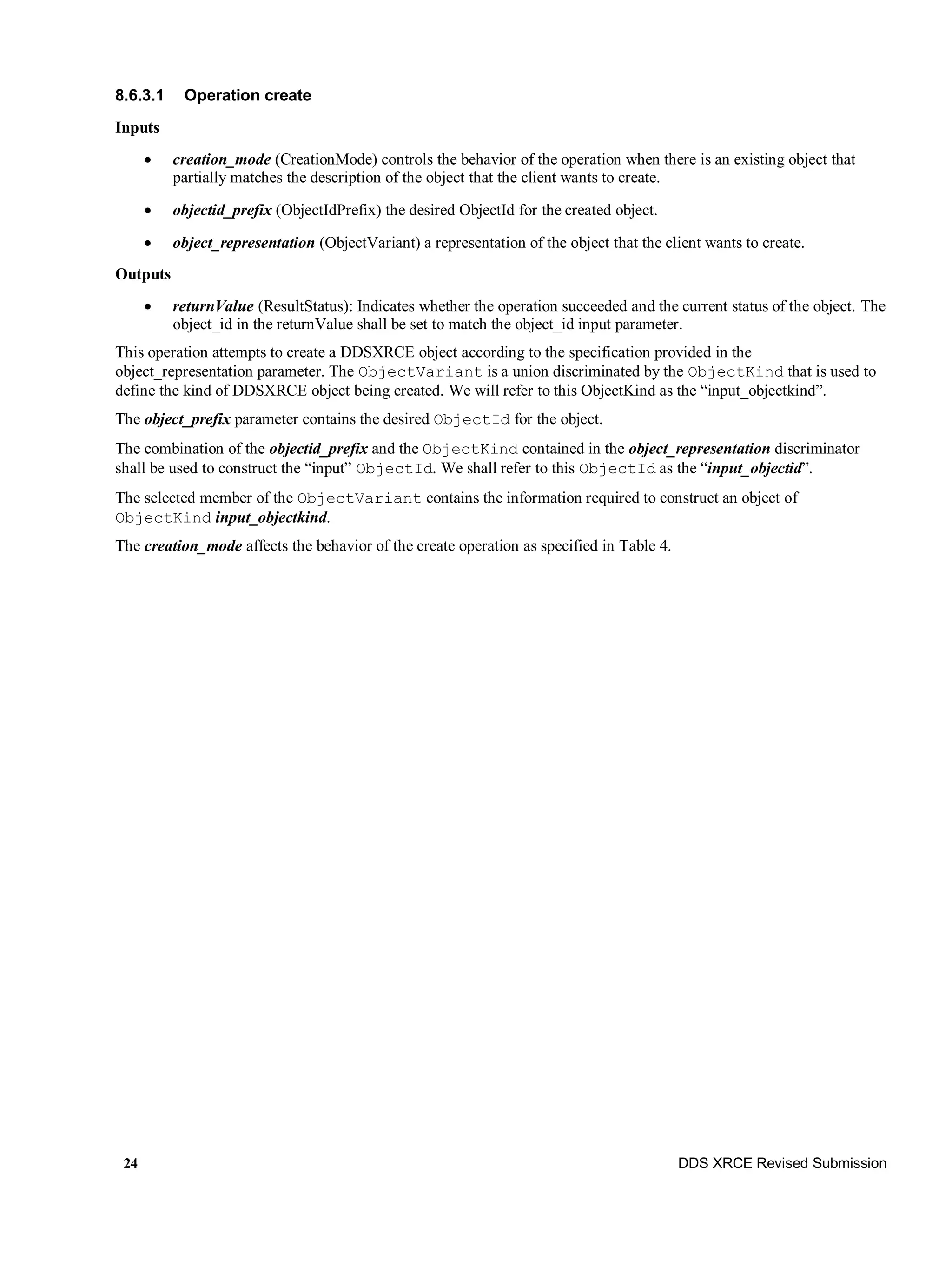
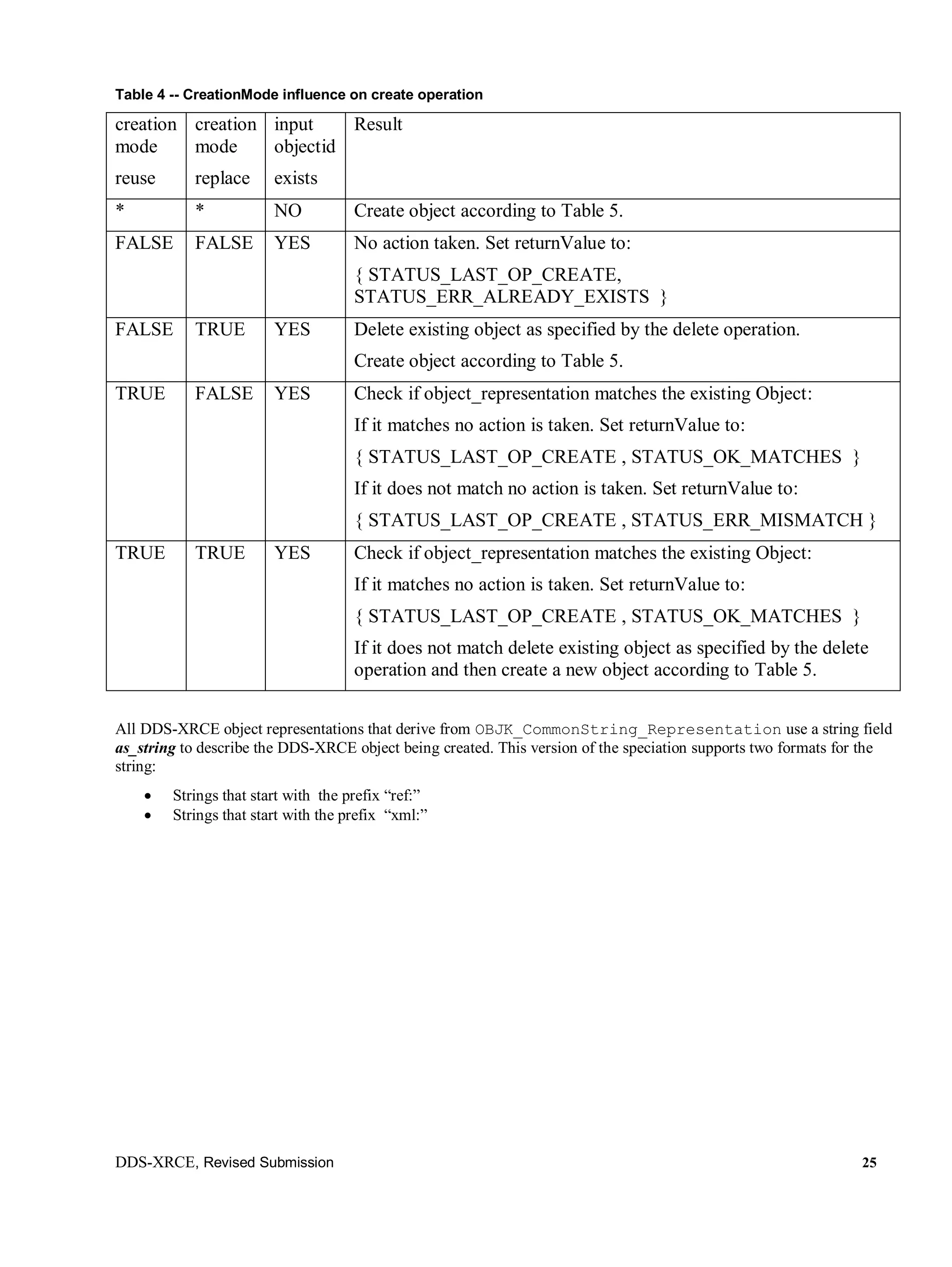

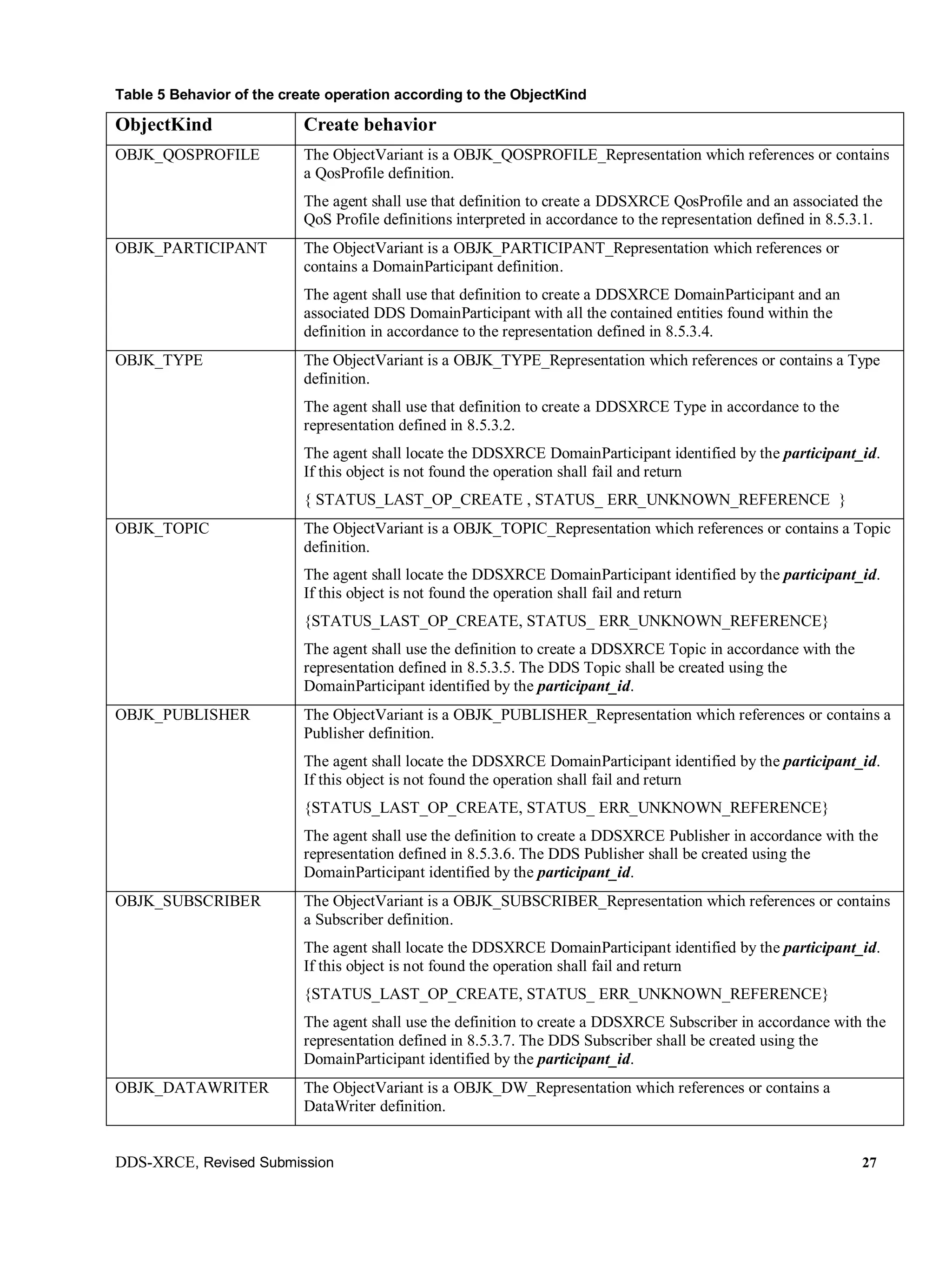
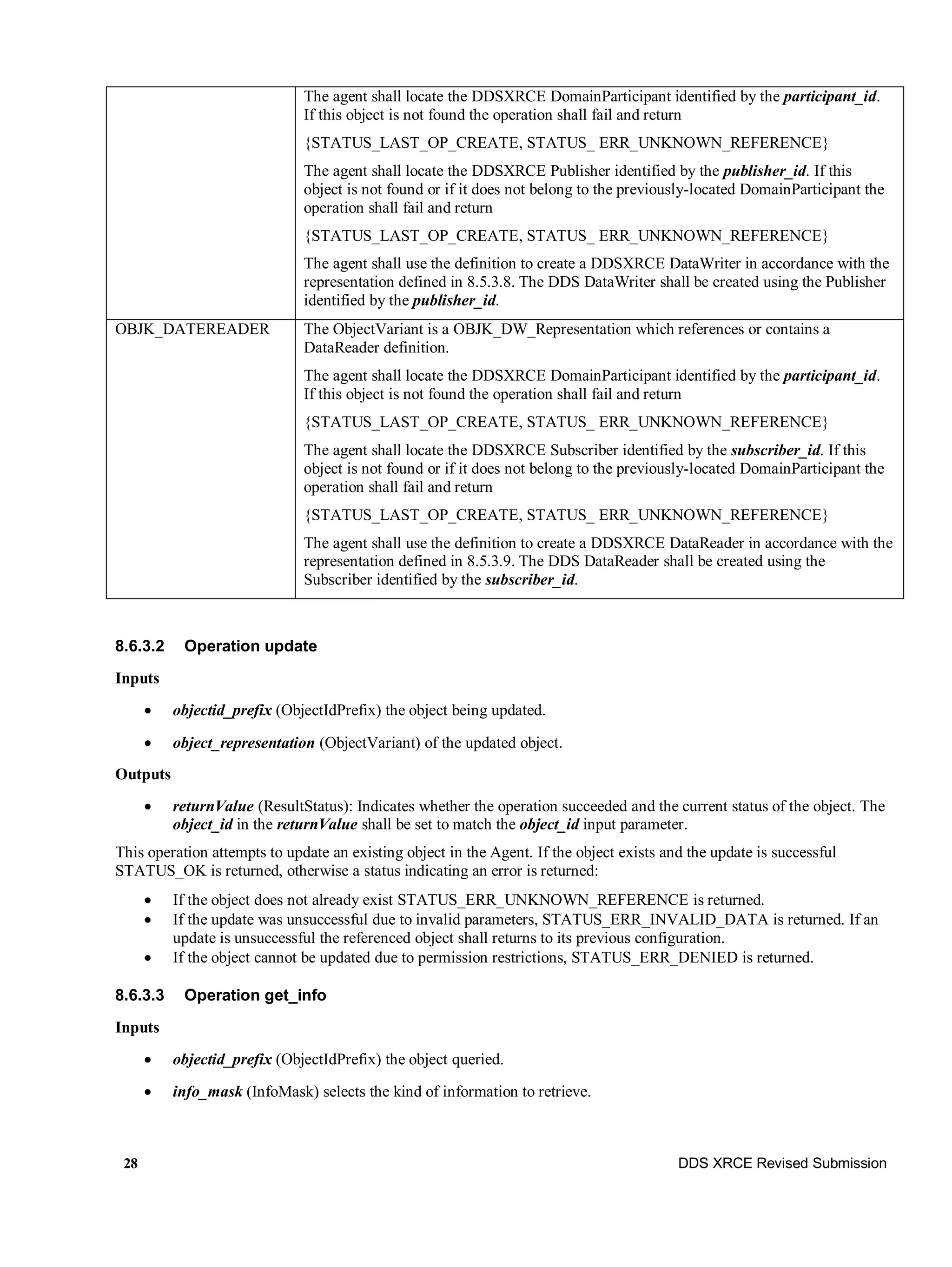
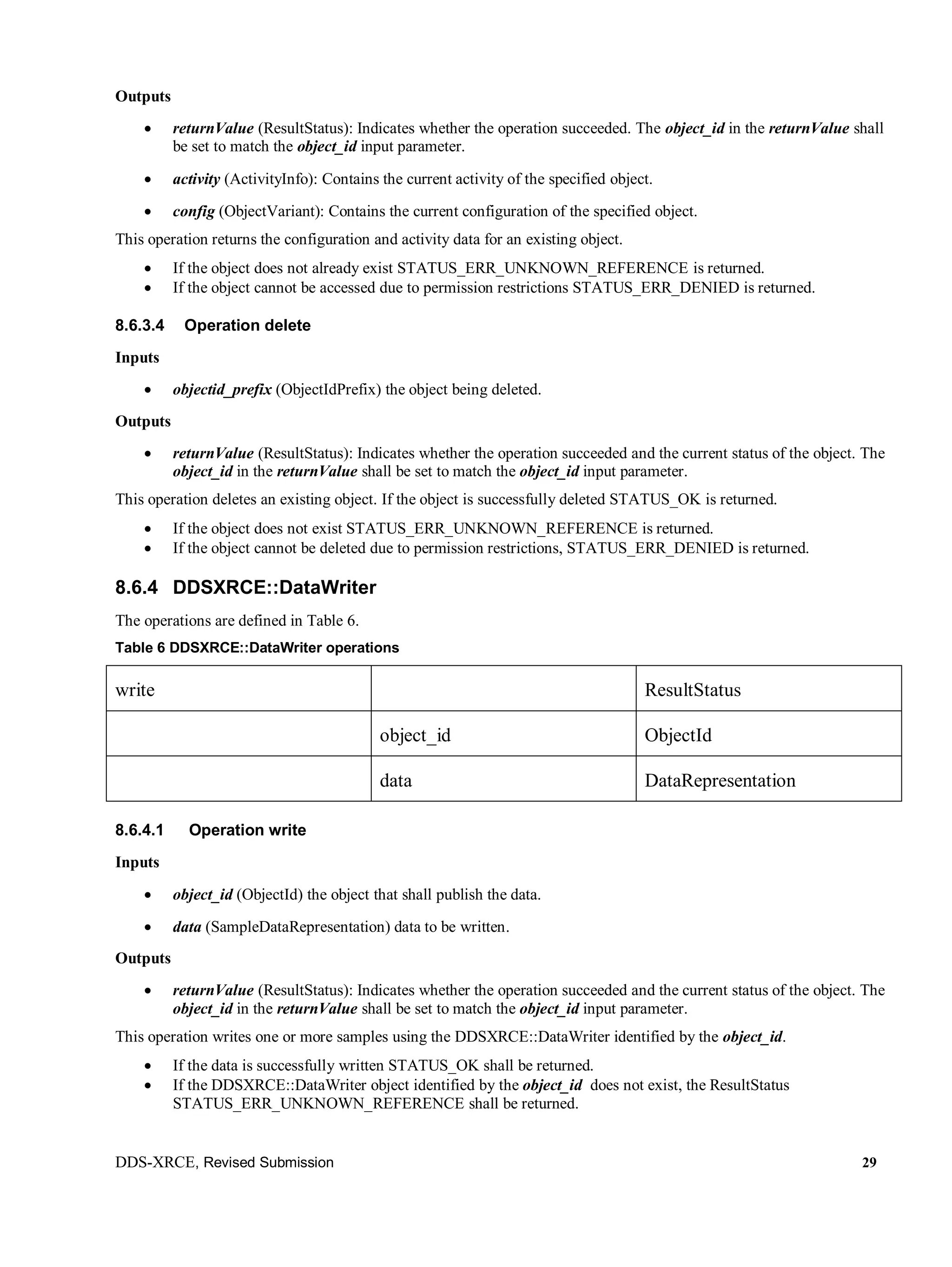

![DDS-XRCE, Revised Submission 31
max_rate long Maximum rate in bytes per second at which the data may
be returned to the read operation.
content_filter_expression string A content filter expression selecting which data to read.
The syntax shall be as specified in Annex B (Syntax for
Queries and Filters) of the DDS specification [DDS].](https://image.slidesharecdn.com/ddsxrcemars-17-09-18-171006013244/75/DDS-for-eXtremely-Resource-Constrained-Environments-37-2048.jpg)
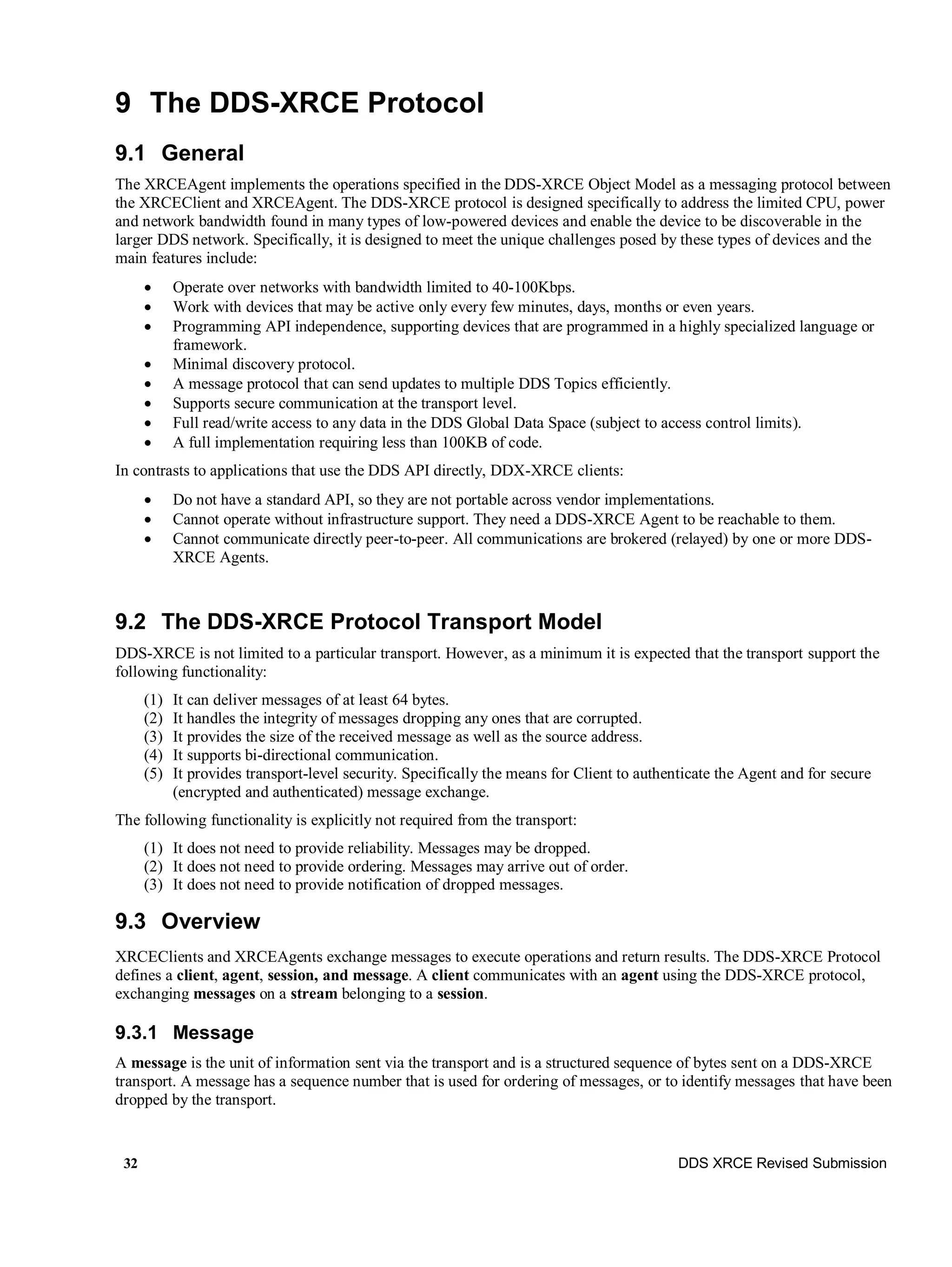

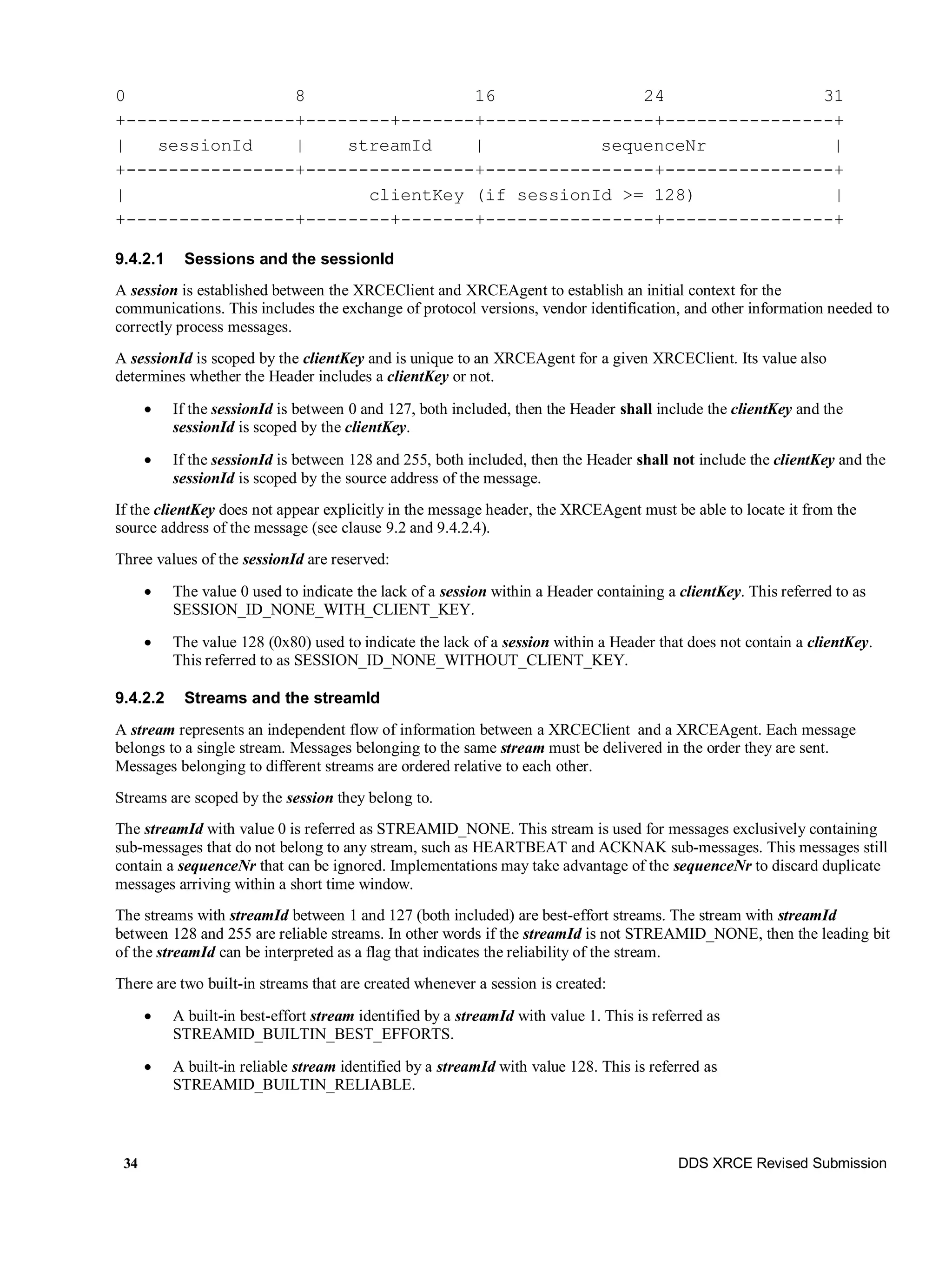
![DDS-XRCE, Revised Submission 35
9.4.2.3 sequenceNr
The sequenceNr is used to order messages within a stream and it is scoped by the stream. Messages belonging to
different streams are unordered relative to each other:
For the stream with streamId STREAMID_NONE value of the sequenceNr does not impose any order,
however it still may be used to discard duplicate messages.
For the stream with streamId different from STREAMID_NONE, the sequenceNr imposes an order. Messages
within a stream shall not be delivered out of order. In addition duplicate messages shall also be discarded.
Addition and comparison of sequence numbers shall use Serial Number Arithmetic as defined by [IETF RFC-1982] with
SERIAL_BITS set to 16. This implies that the maximum number of outstanding messages for a specific client session
stream is limited to 2^15, that is 32768.
The sequenceNr shall be encoded using little endian format.
9.4.2.4 clientKey
The clientKey uniquely identifies and authenticates an XRCEClient to the XRCEAgent.
The clientKey shall be present on the Header if the sessionId is between 0 and 127. See clause 9.4.2.1:
If the clientKey is present, it shall contain the ClientKey associated with the XRCEClient.
If the clientKey is not present, the XRCEAgent shall be able to derive the ClientKey associated with the
XRCEClient from the source address of the message (see clause 9.2). This means that the ClientKey has
either been pre-configured on the XRCEAgent for that particular source address, or else it has been exchanged
as part of the session establishment, see clause 8.6.2.1.
Any exchange if the clientKey is protected by the security mechanisms provided by the XRCE transport. These security
mechanisms are transport specific and may involve a pairing of each device with the agent or some initial handshake
used to establish a secure transport connection. The specific transport security mechanisms are outside the scope of this
specification.
9.4.3 Submessage Structure
Following the message header there shall be one or more Submessages. A Submessage shall be composed of a
submessage header and a payload.
0 4 8 16 24 31
+-------+-------+----------------+----------------+----------------+
| submessageHeader (4 Bytes) |
+---------------+----------------+----------------+----------------+
~ payload (up to to 32KB) ~
+---------------+----------------+----------------+----------------+
The ability to place multiple of Submessages within a single message reduces bandwidth by enabling multiple resources
to be operated on with a single message.
Submessages shall start at an offset that is a multiple of 4 relative to the beginning of the Message. This means that
additional padding may be added between the end of a submessage and the beginning of the next submessage.
9.4.4 Submessage Header
Every Submessage shall start with a Submessage header. The Submessage Header shall be structured as follows:](https://image.slidesharecdn.com/ddsxrcemars-17-09-18-171006013244/75/DDS-for-eXtremely-Resource-Constrained-Environments-41-2048.jpg)
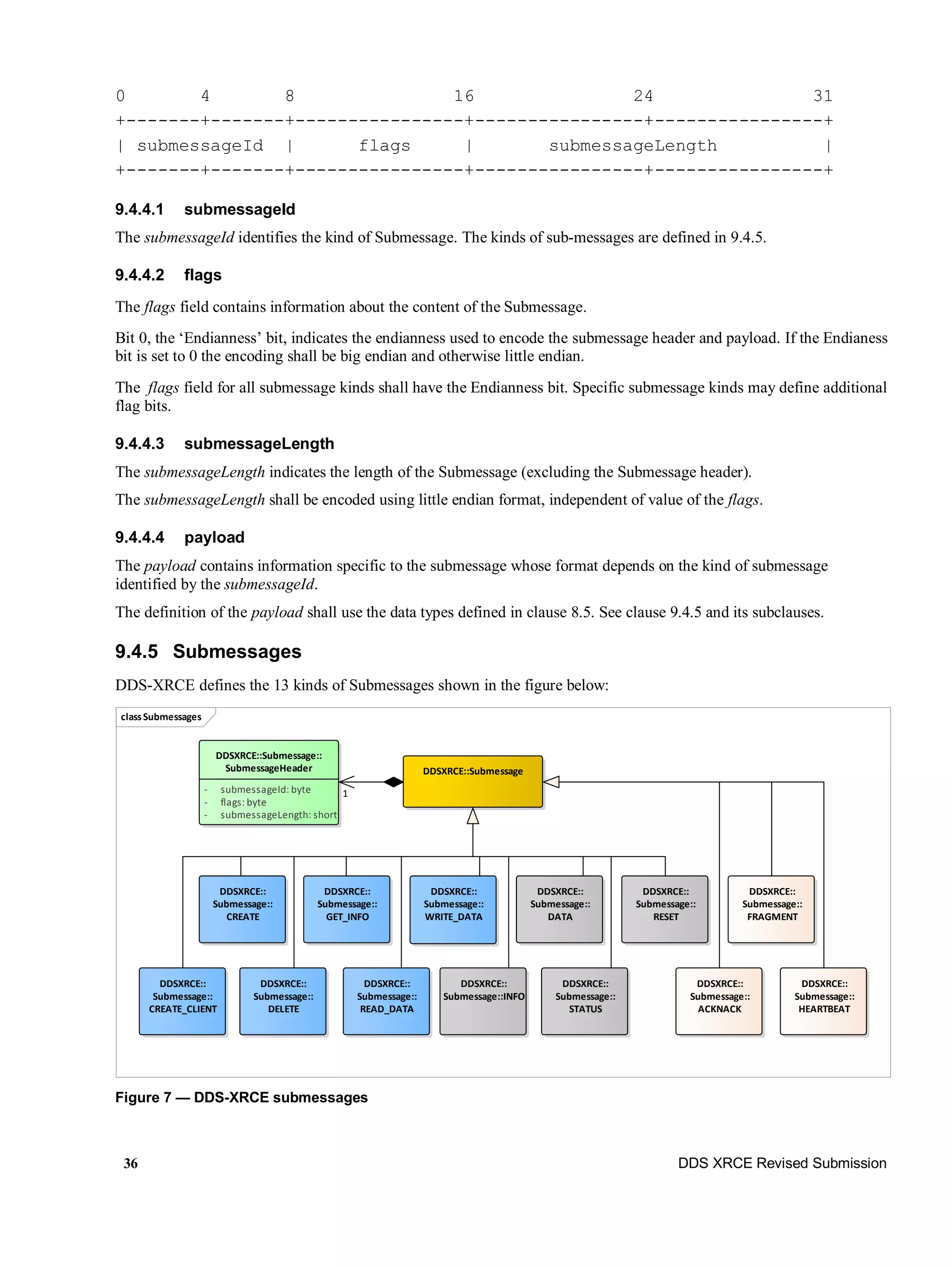
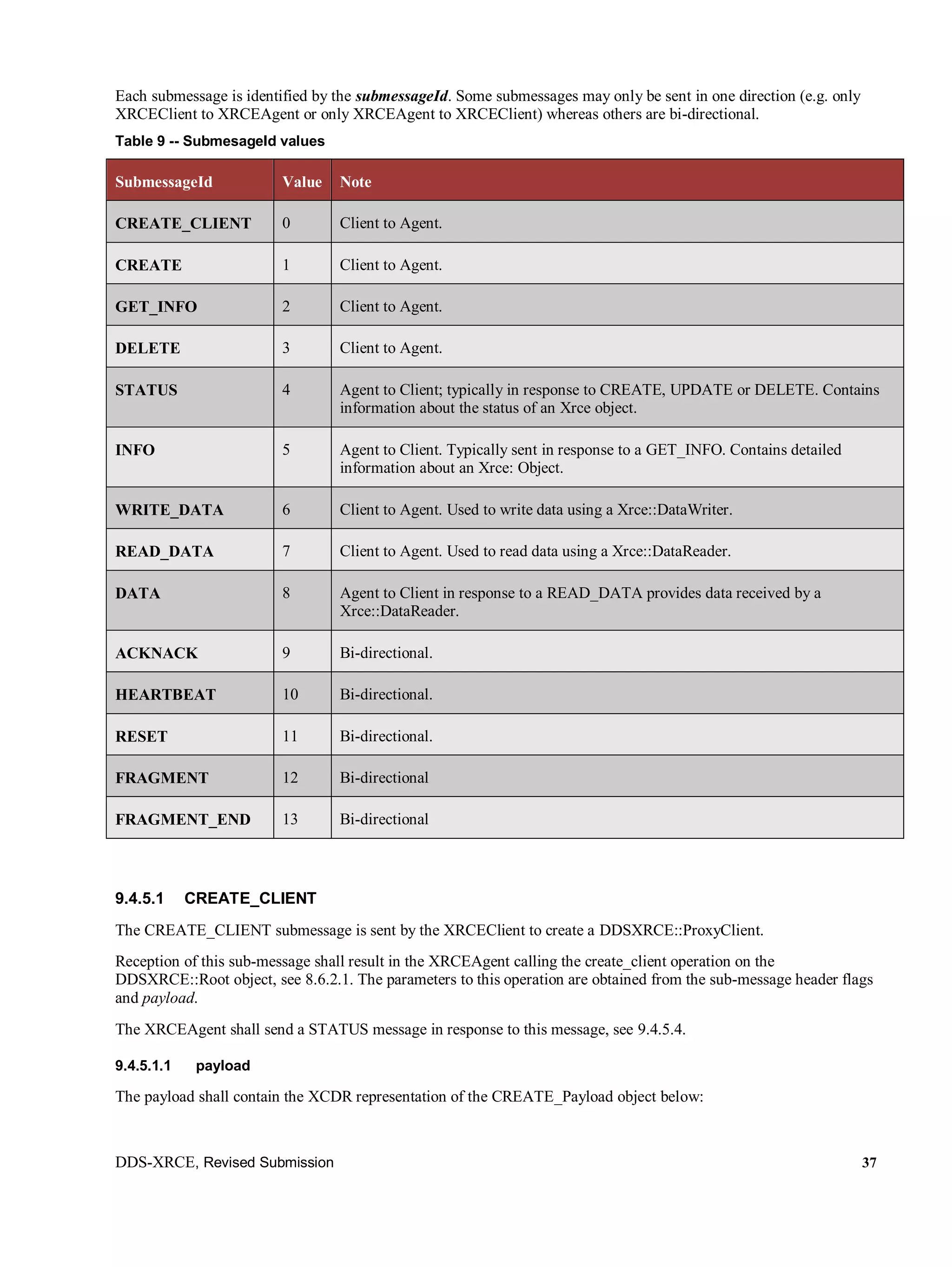
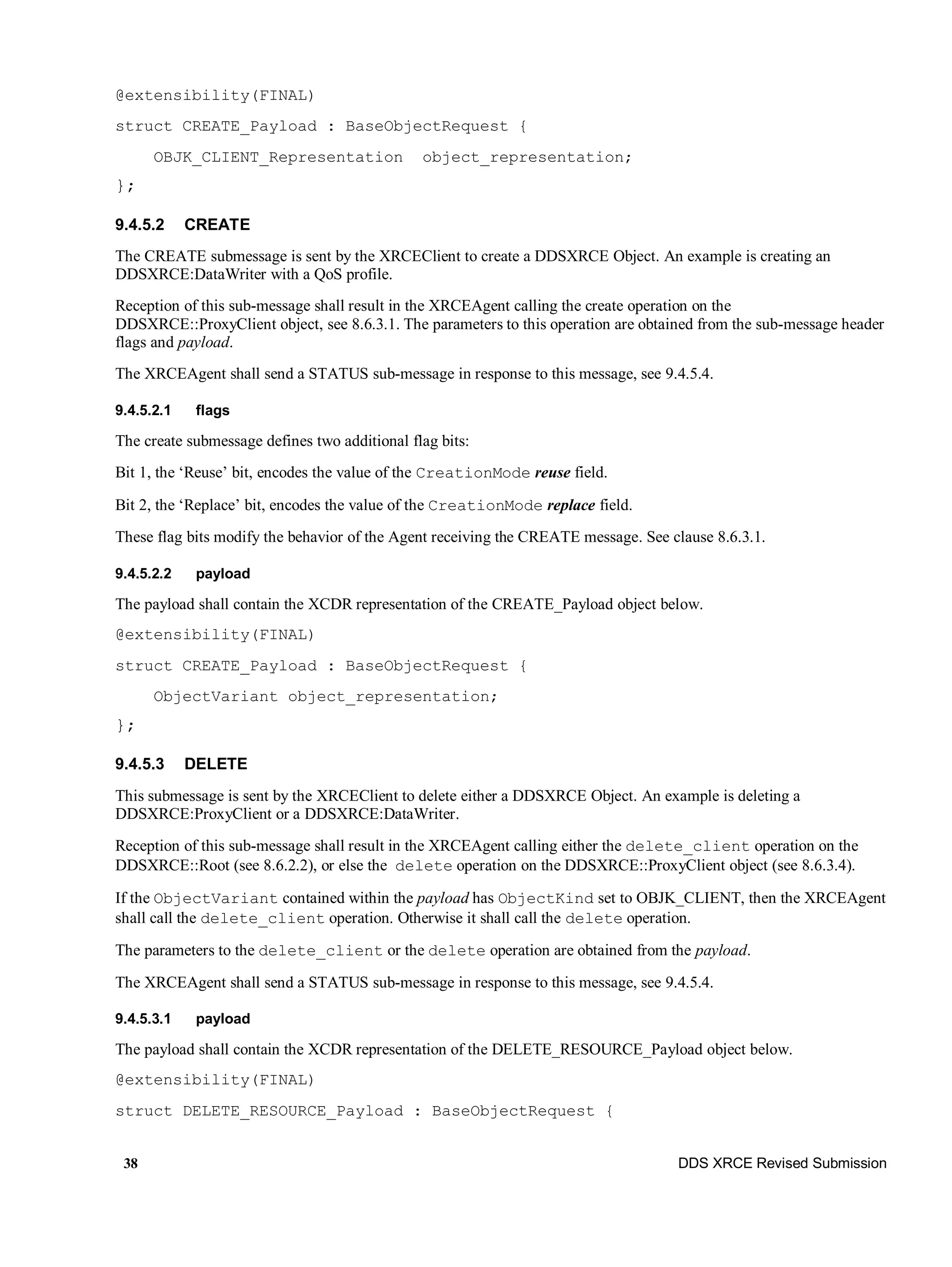
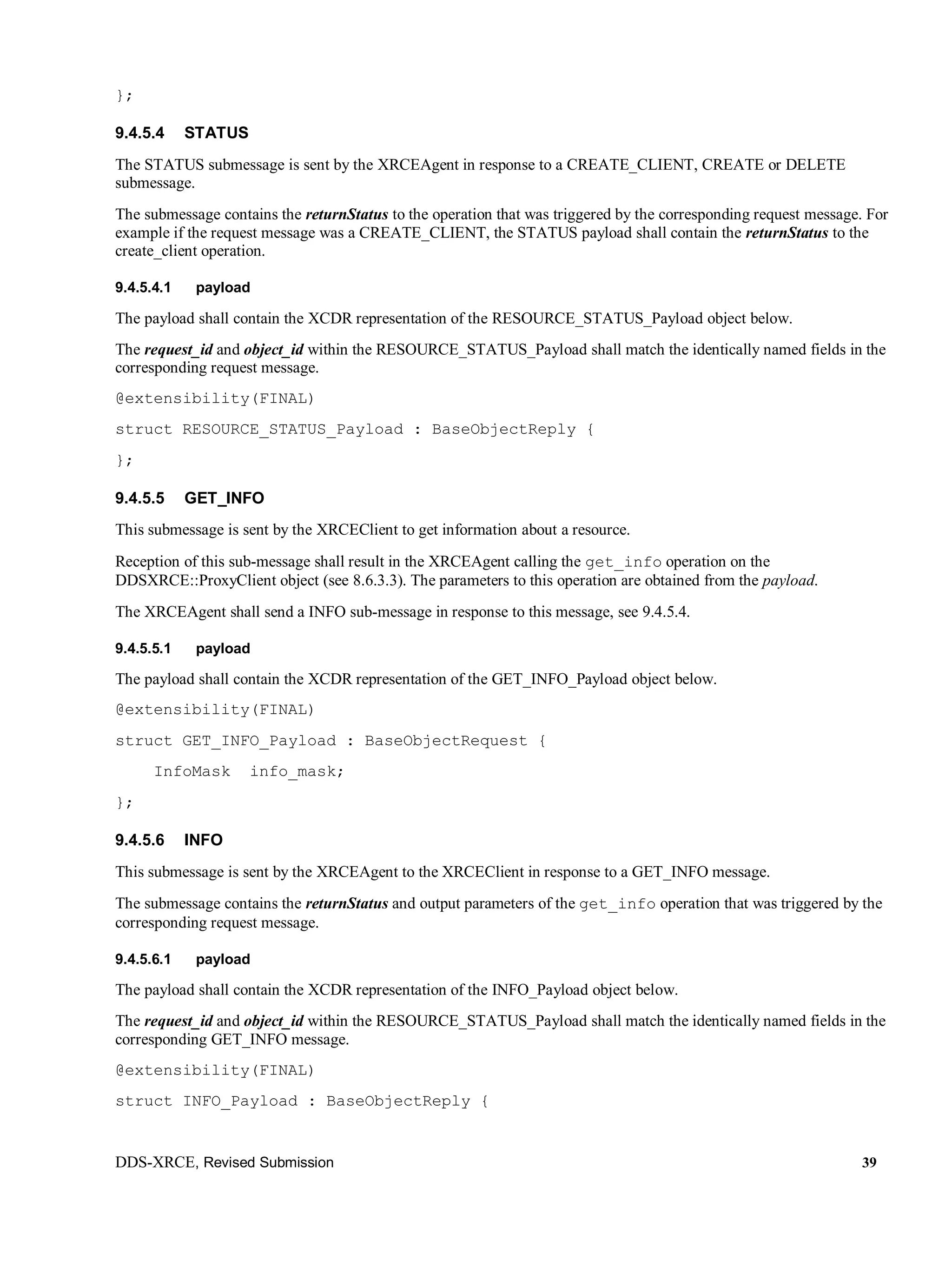

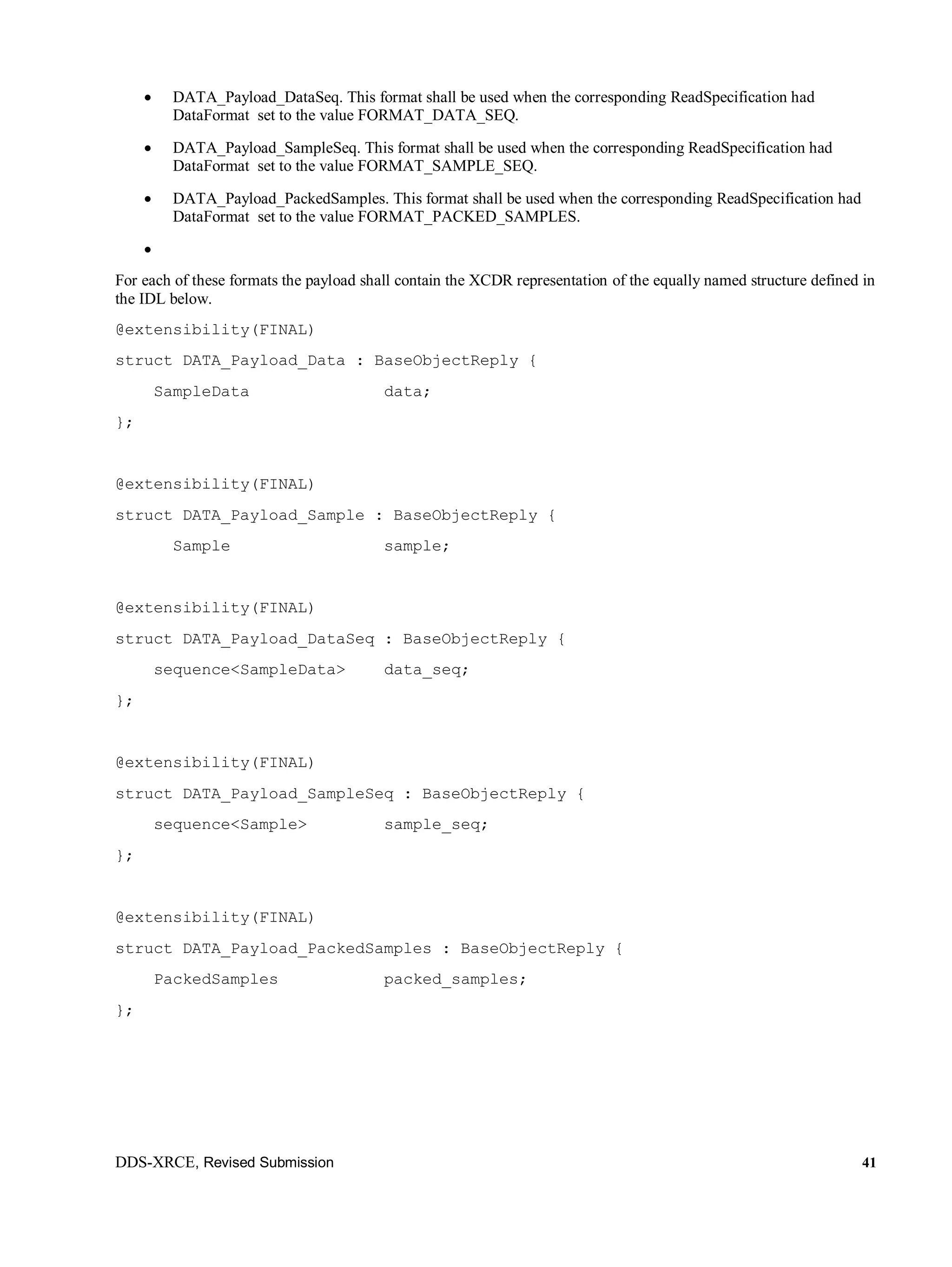
![42 DDS XRCE Revised Submission
All the DATA payload representation derive from BaseObjectReply. The XRCEClient may use the request_id and
object_id of in the BaseObjectReply to locate the corresponding READ_DATA message and determine the DataFormat
of the ReadSpecification specified in the request.
As specified in
9.4.5.9 WRITE_DATA
This submessage is used by the XRCEClient to write data using a DDSXRCE::DataWriter inside the XRCEAgent.
Reception of this sub-message shall result in the XRCEAgent calling the write operation on a DDSXRCE::DataWriter
object (see 8.6.4.1). The parameters to this operation are obtained from the payload.
The related DDSXRCE::DataWriter is identified by the object_id field in the payload.
9.4.5.9.1 payload
The payload shall contain the XCDR representation of the WRITE_DATA_Payload object below.
struct WRITE_DATA_Payload {
DataRepresentation data_to_write;
};
9.4.5.10 ACKNACK
This Submessage is used to enable a transport independent reliability protocol to be implemented.
This specification does not limit a session to use a particular type of transport. If a session transport is able to reliably
send messages in case of disconnection or a wakeup/sleep cycle then these messages may not be required.
If these Submessages are used, this specification does not dictate how reliable a session shall be. However, in general it
is expected that it is the Client that initiates any synchronization. This is because a Client may not be continually
available as it goes on sleep cycles.
The ACKNACK message is directed to the same session and stream indicated in the Message header. For this reason it
does not have a objectId.
9.4.5.10.1 payload
The ACKNACK submessage payload contains a information about the state of the session and stream.
struct ACKNACK_Payload {
short firstUnackedSeqNr;
octet[2] nackBitmap;
};
The firstUnackedSeqNr indicates that all sequence numbers up to but not including it has been received.
The nackBitmap indicates missing sequence numbers, starting from firstUnackedSequenceNr.](https://image.slidesharecdn.com/ddsxrcemars-17-09-18-171006013244/75/DDS-for-eXtremely-Resource-Constrained-Environments-48-2048.jpg)
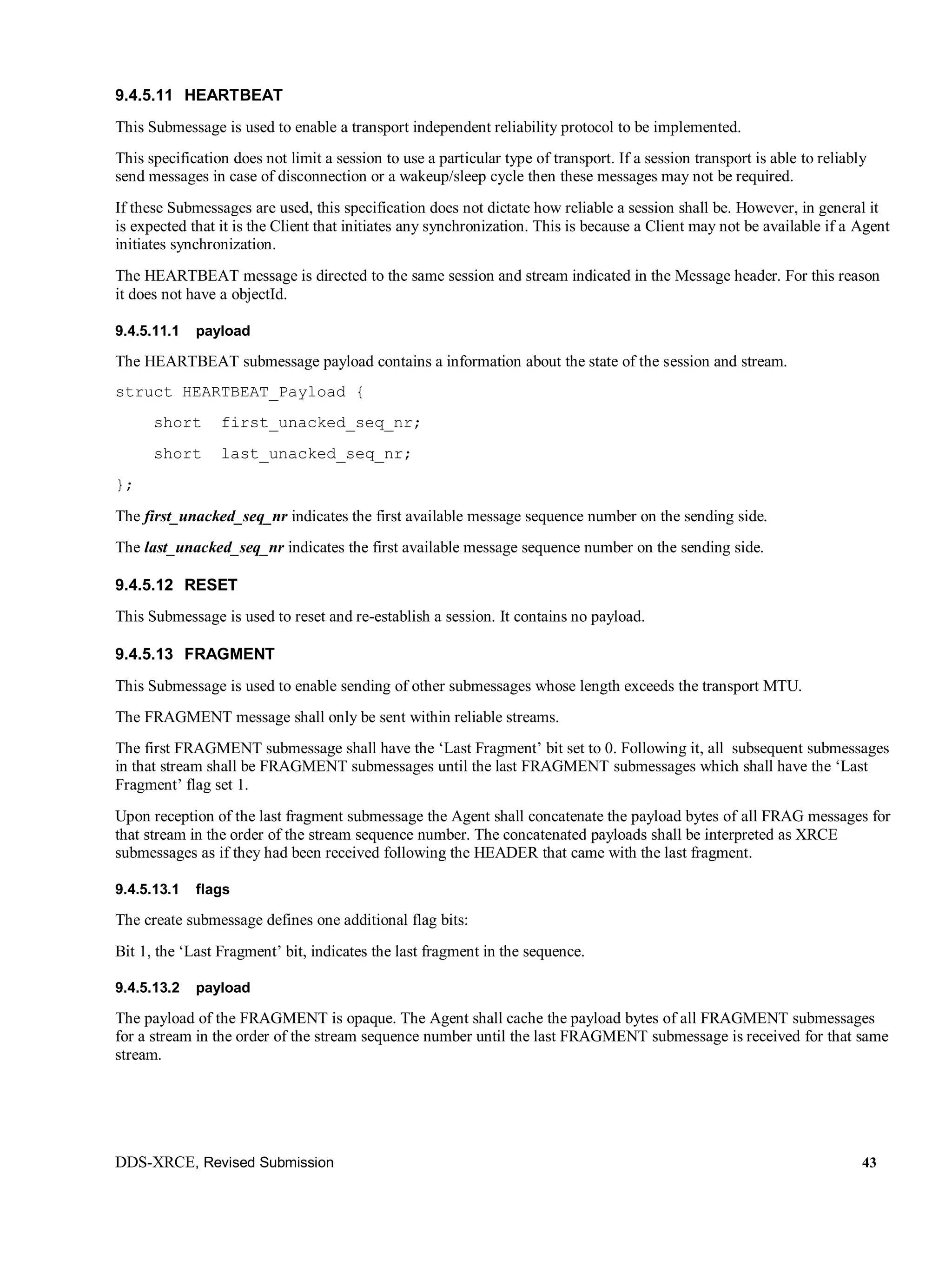
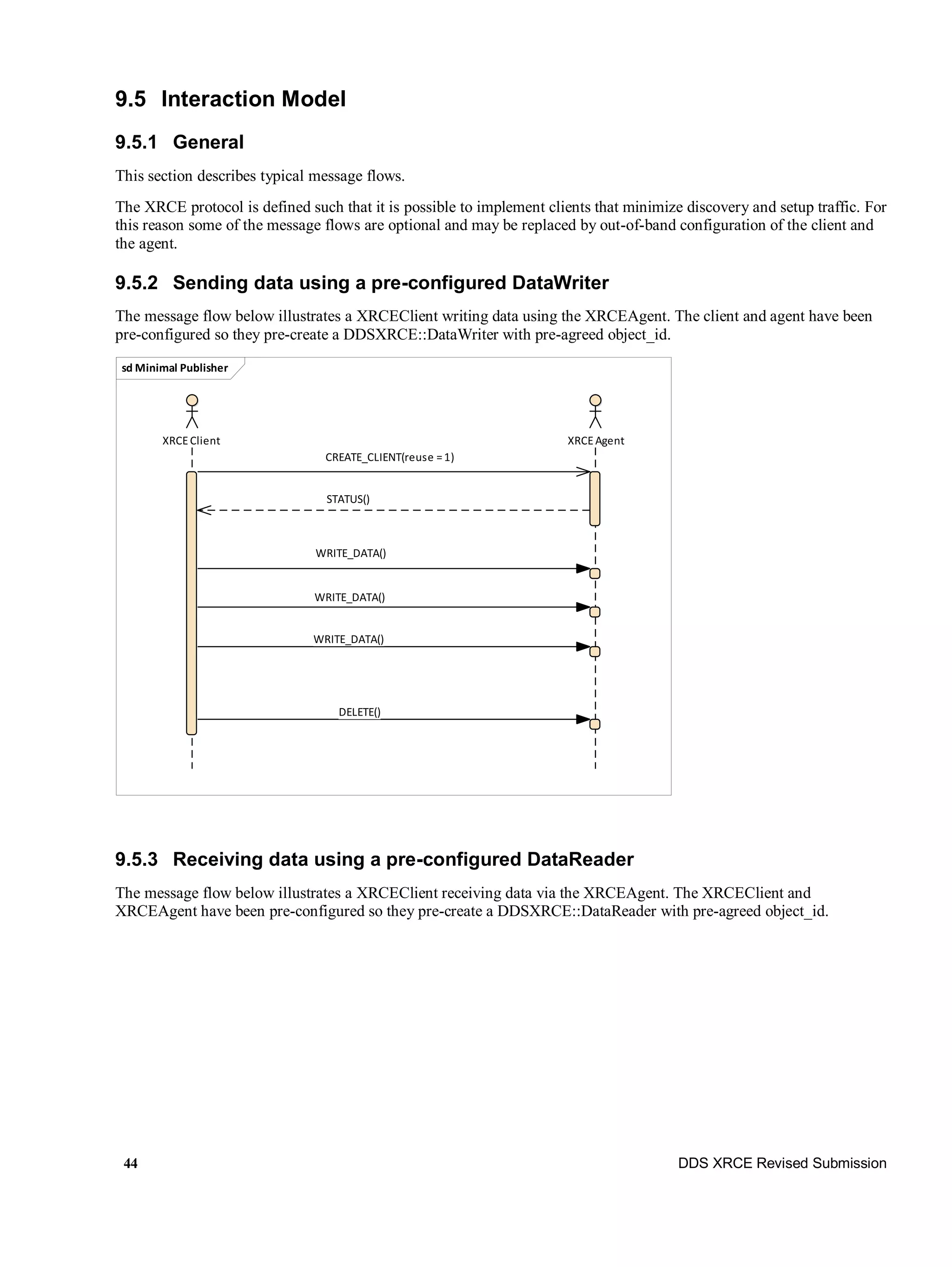
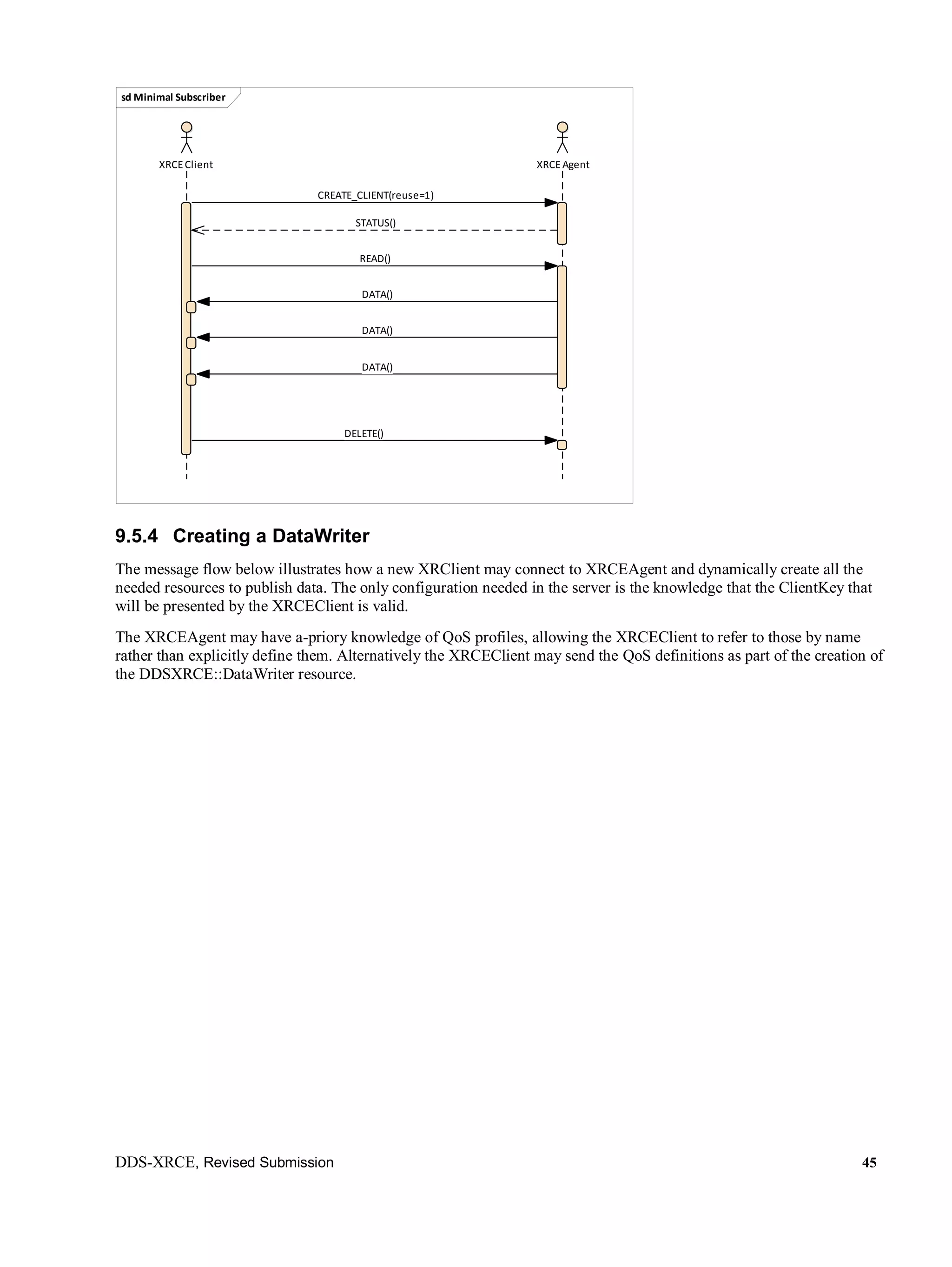
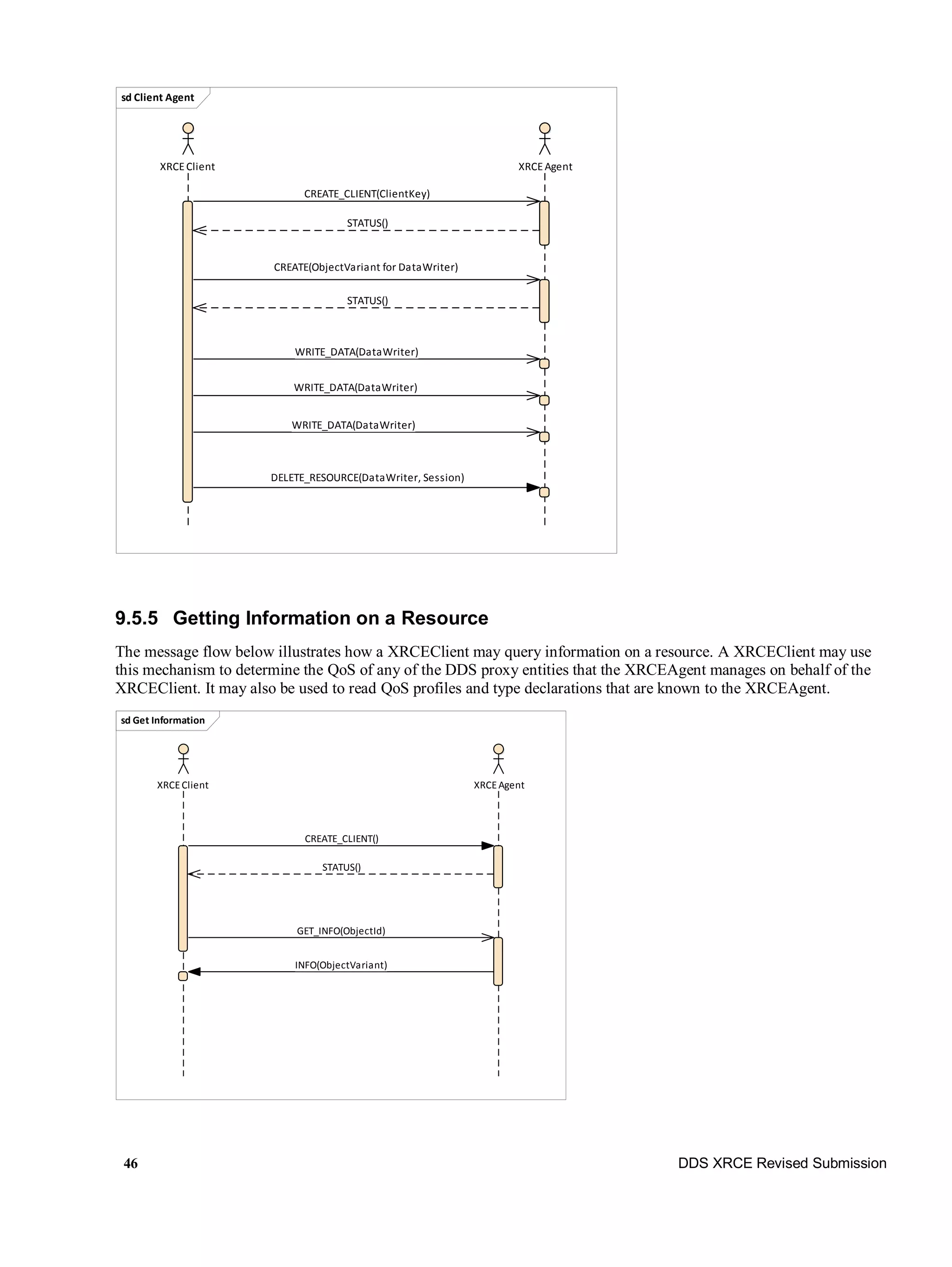
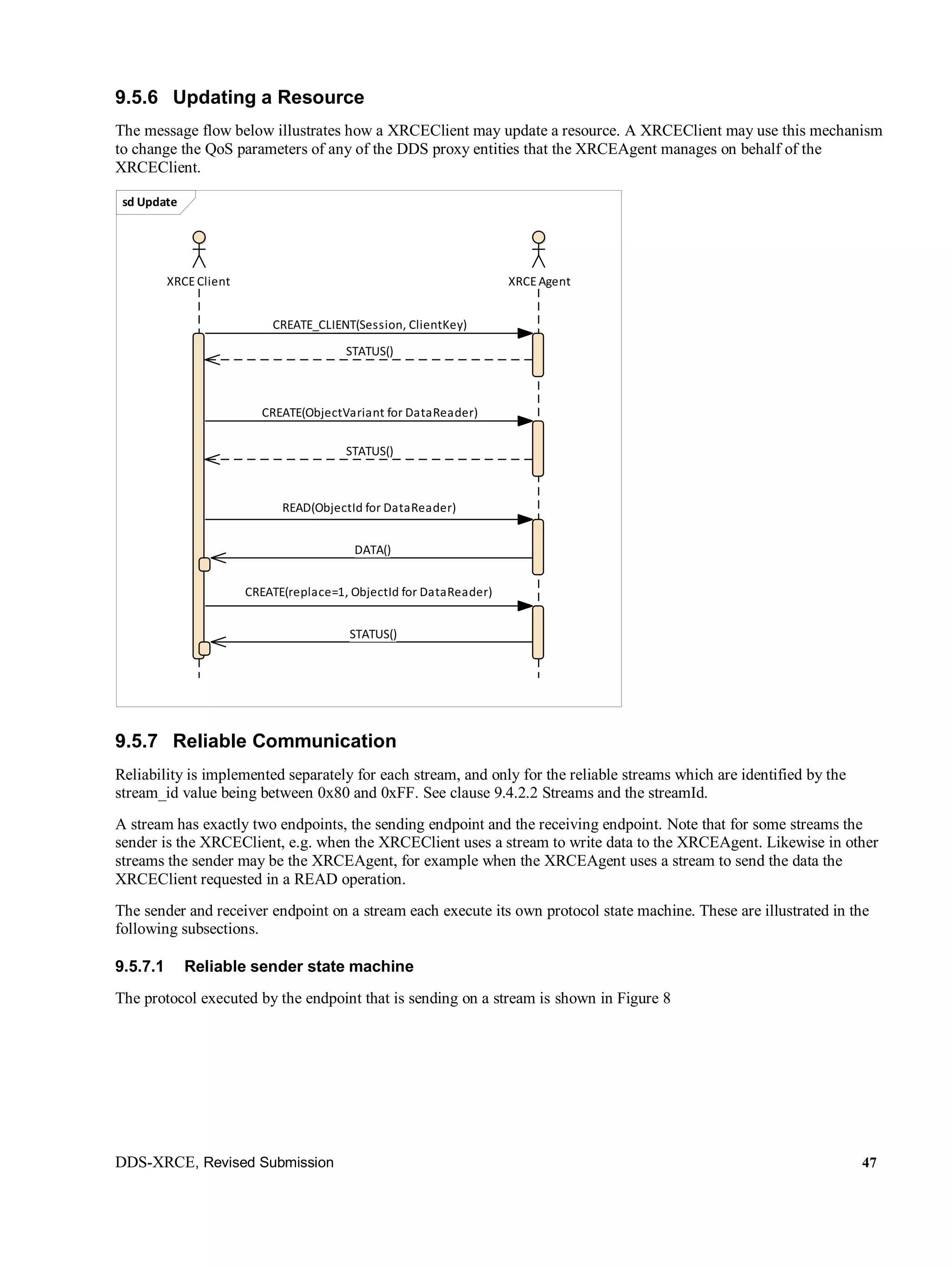
![48 DDS XRCE Revised Submission
Figure 8— Reliable protocol state-machine for the sender on a stream
The sender maintains two state variables associated with the stream. The HighestSentSequenecNumber and the
HighestAcknowledgedSequenceNumber.
Each time a message is sent the HighestSentSequenecNumber is increased. The reception of ACKNAK messages
updates the HiguestAcknowledgedSequenceNumber.
While the HighestAcknowledgedSequenceNumber is less than the HighestSentSequenecNumber the sender sends
HeartBeat messages that announce the HighestSentSequenecNumber to the receiver. These HeartBeat messages may be
periodic or optimized using on vendor specific mechanism. The requirement is that they are sent at some rate until
HighestAcknowledgedSequenceNumber matches the HighestSentSequenecNumber.
9.5.7.2 Reliable receiver state machine
The protocol executed by the endpoint that is receiving on a reliable stream is shown in Figure 9
Figure 9— Reliable protocol state-machine for the receiver on a stream
The receiver maintains two state variables associated with the stream. The HighestRceivedSequenecNumber and the
HighestAnnouncedSequenceNumber.
Each time a Message is received the HighestReceivedSequenecNumber may be updated (assuming all previous messages
have been received). The HighestAnnouncedSequenceNumber may also be adjusted.
Initial
AllMessagesAcknowledged MessagesNotFullyAcked
receive(ACKNACK)
/save
HigestAcknowledgedSeqNumber
repair SequenceNumber in NACK
write
/HighestSentSequenceNumber++
[HeartBeatPeriod]
/Send(HeartBeat, HighestSentSequenceNumber)
write
/HighestSentSequenceNumber++
[HiguestReceivedSeqNumber ==HiguestSentSequenceNumber]
Initial
ReceivedAllMessages
MissingMessageFromSender
Choice
[HiguestAnnouncedSequenceNumber >HiguestReceivedSequenceNumber]
[XRCEClient && NackPeriod]
/Send(ACKNACK)
[HiguestAnnouncedSequenceNumber <=HiguestReceivedSequenceNumber]
receive(HeartBeat, HigestAnnouncedSequenceNumber)
receive(HeartBeat, HigestAnnouncedSequenceNumber)
/ HiguestReceivedSequenceNumber :=0](https://image.slidesharecdn.com/ddsxrcemars-17-09-18-171006013244/75/DDS-for-eXtremely-Resource-Constrained-Environments-54-2048.jpg)
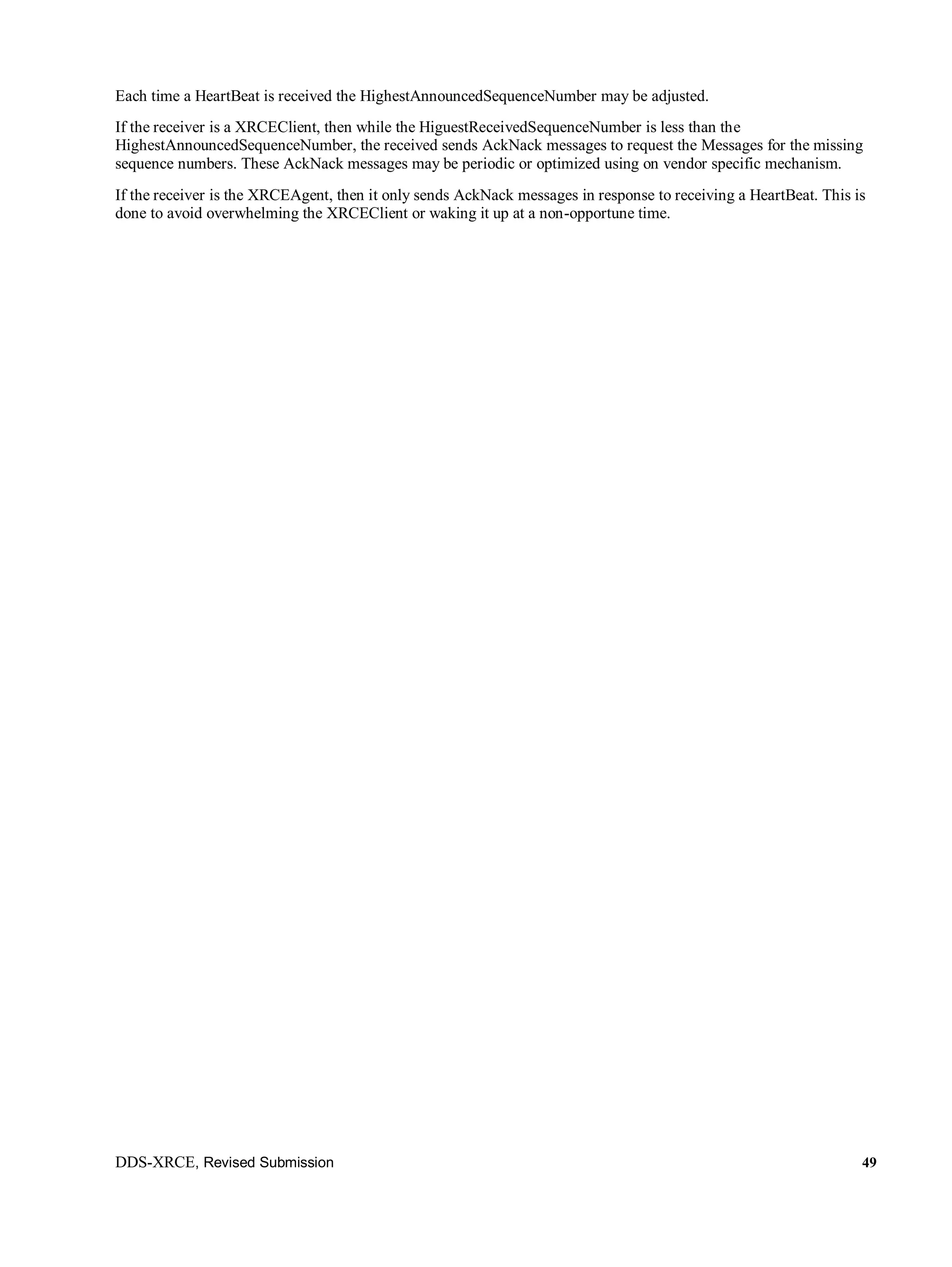

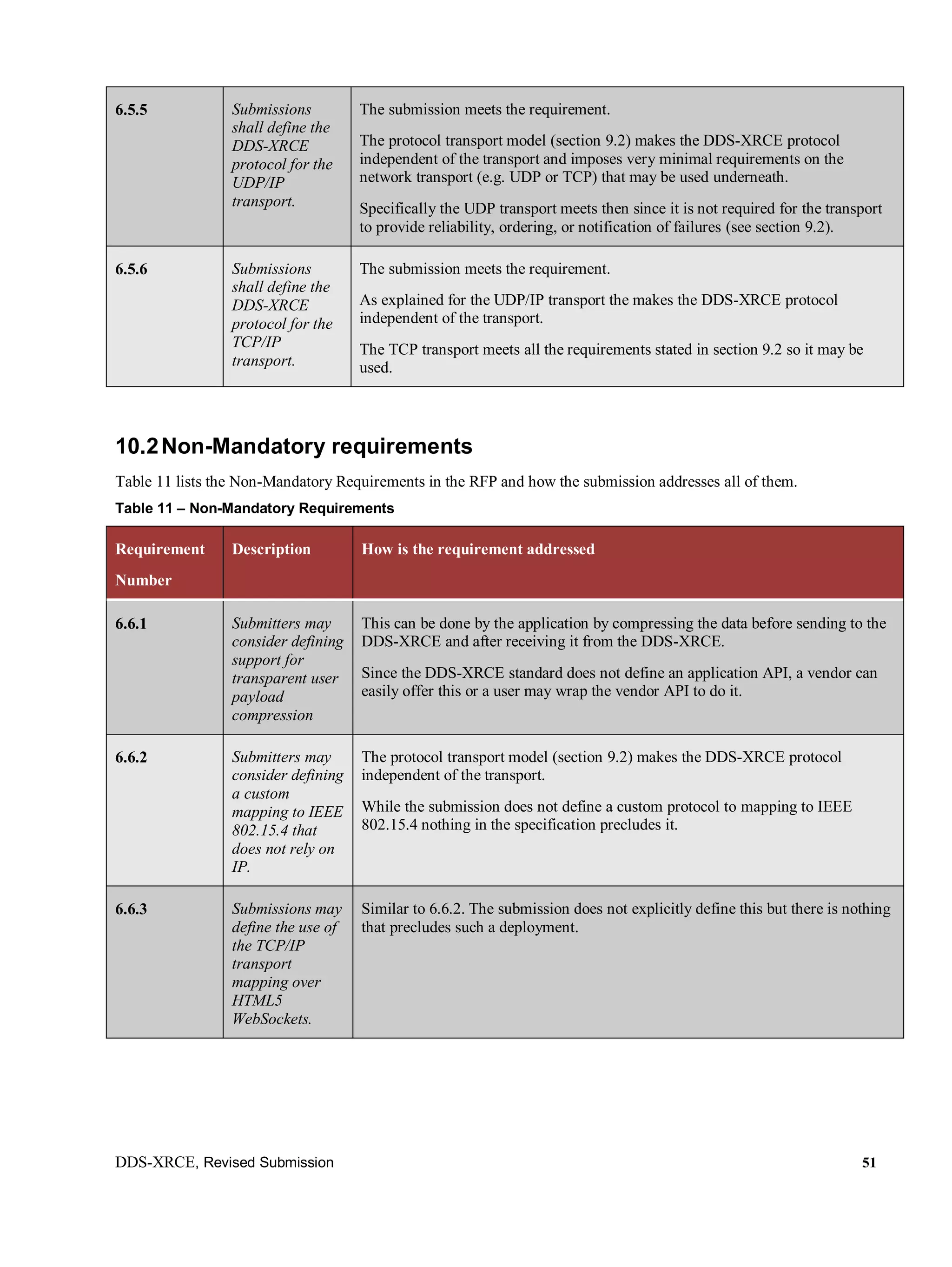
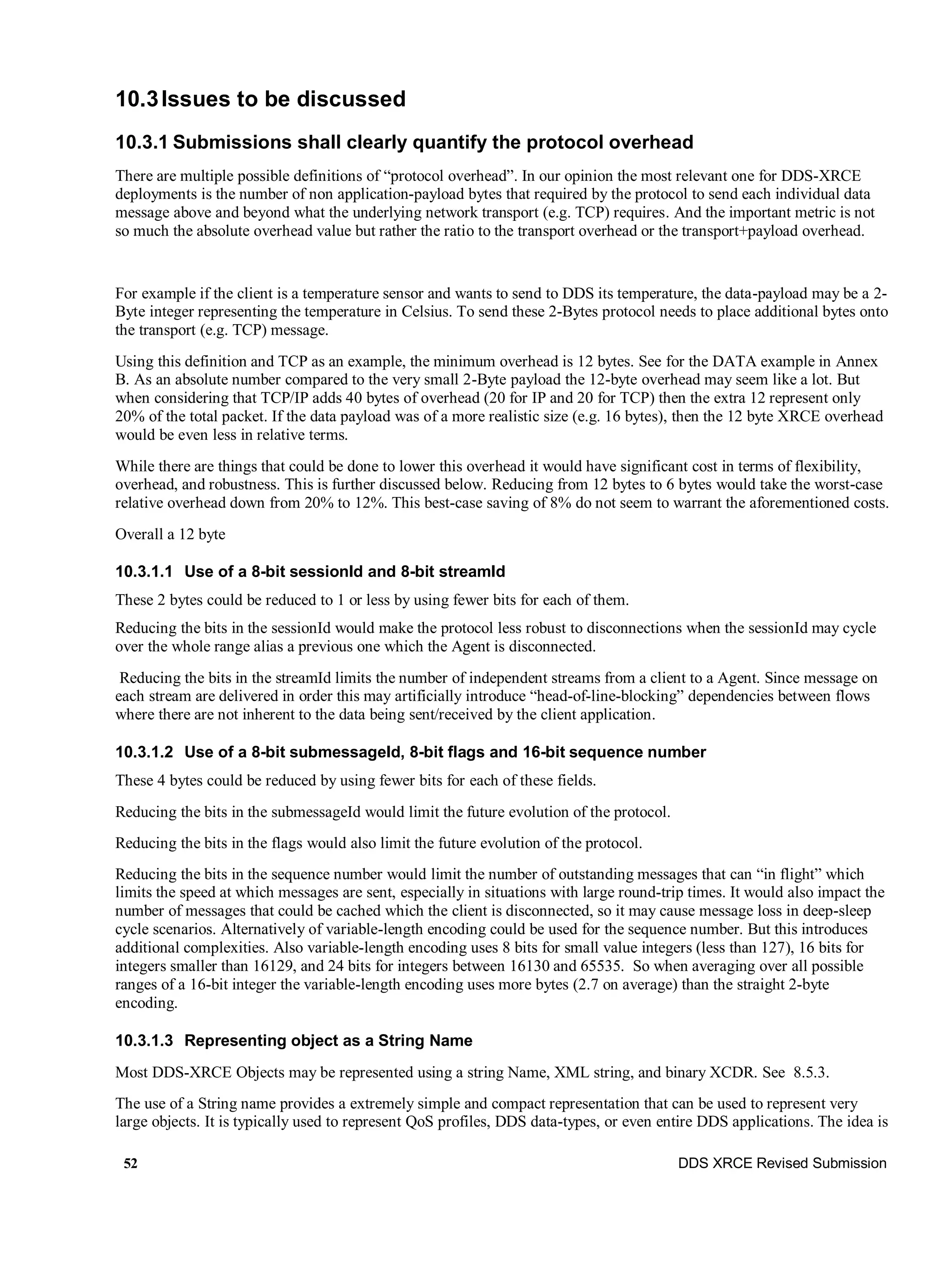
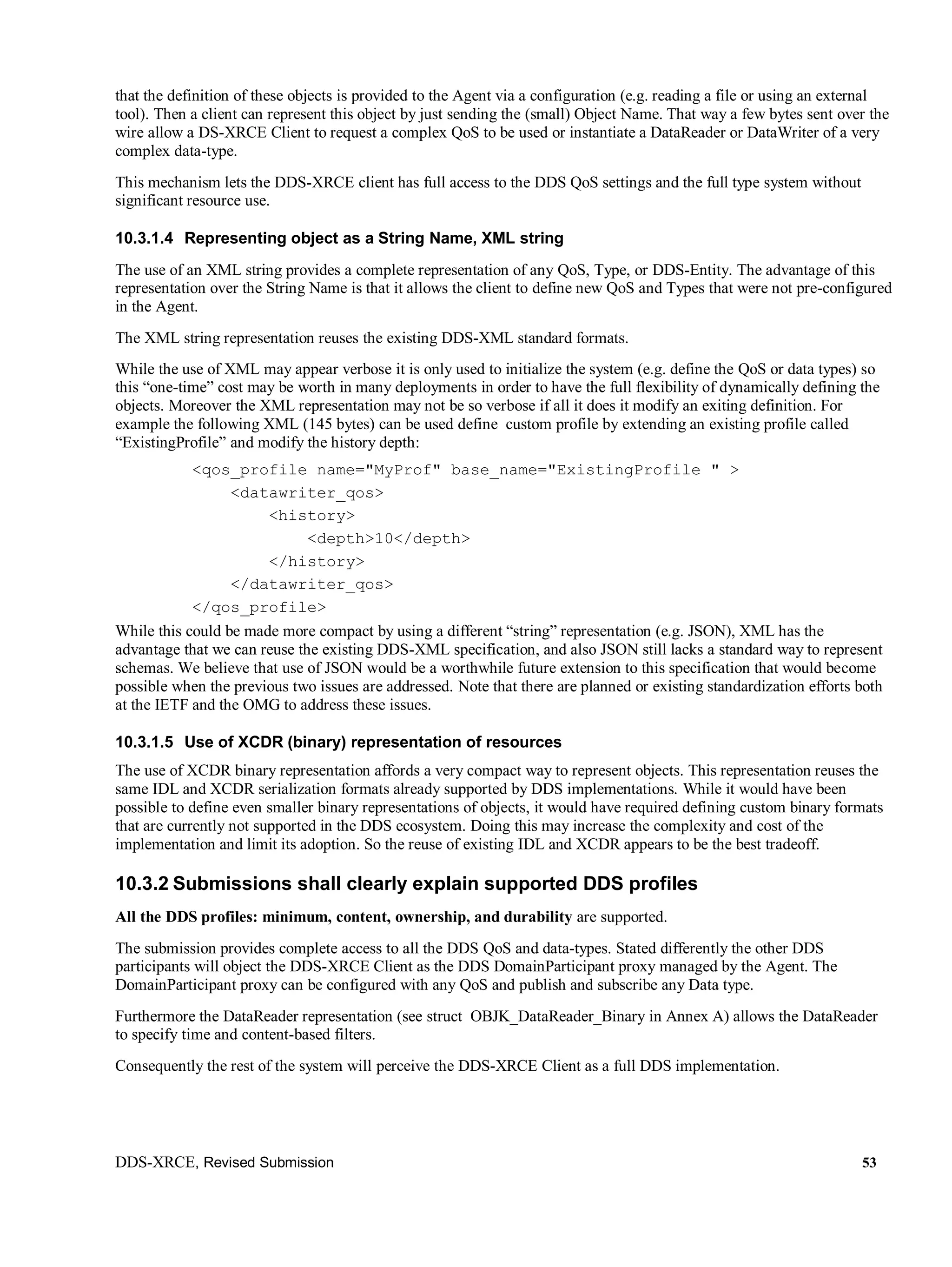
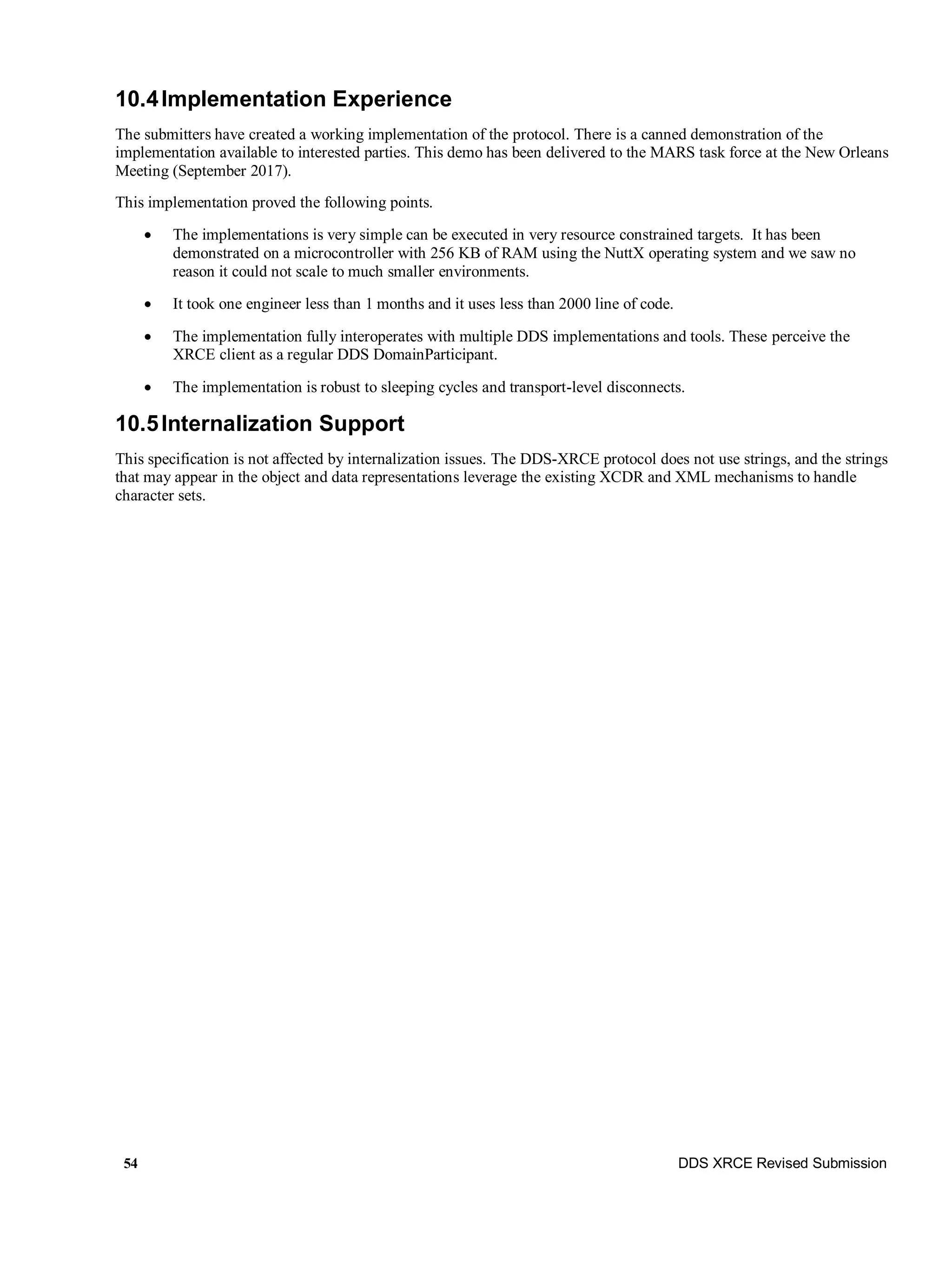
![DDS-XRCE, Revised Submission 55
Annex A. IDL Types
module dds { module xrce {
typedef octet ClientKey[4];
typedef octet ObjectKind;
const ObjectKind OBJK_INVALID = 0x0;
const ObjectKind OBJK_PARTICIPANT = 0x1; // Matches RTPS EntityKind
const ObjectKind OBJK_TOPIC = 0x4;
const ObjectKind OBJK_DATAWRITER = 0x3; // Matches RTPS EntityKind
const ObjectKind OBJK_DATAREADER = 0x7; // Matches RTPS EntityKind
const ObjectKind OBJK_SUBSCRIBER = 0x8;
const ObjectKind OBJK_PUBLISHER = 0x9;
const ObjectKind OBJK_TYPE = 0x10;
const ObjectKind OBJK_QOSPROFILE = 0x11;
const ObjectKind OBJK_APPLICATION = 0x20;
const ObjectKind OBJK_CLIENT = 0x21;
typedef octet ObjectId [2];
// There are three predefined values ObjectId
// IDL does not have a syntax to express array constants so we
// use #define with is legal in IDL
#define OBJECTID_INVALID {0xFF,0xFF}
#define OBJECTID_CLIENT {0xFF,0xF0}
#define OBJECTID_SESSION {0xFF,0xF1}
typedef octet XrceCookie[4];
// Spells ‘X’ ‘R’ ‘C’ ‘E’
#define XRCE_COOKIE { 0x58, 0x52, 0x43, 0x45 }](https://image.slidesharecdn.com/ddsxrcemars-17-09-18-171006013244/75/DDS-for-eXtremely-Resource-Constrained-Environments-61-2048.jpg)
![56 DDS XRCE Revised Submission
typedef octet XrceVersion[2];
#define XRCE_VERSION_MAJOR 0x01
#define XRCE_VERSION_MINOR 0x00
#define XRCE_VERSION { XRCE_VERSION_MAJOR, XRCE_VERSION_MINOR }
typedef octet XrceVendorId[2];
#define XRCE_VENDOR_INVALID1 0x00
#define XRCE_VENDOR_INVALID1 0x00
struct Time_t {
long seconds;
unsigned long nanoseconds;
};
typedef octet SessionId;
const SessionId SESSIONID_NONE_WITH_CLIENT_KEY = 0x00;
const SessionId SESSIONID_NONE_WITHOUT_CLIENT_KEY = 0x80;
typedef octet StreamId;
const SessionId STREAMID_NONE = 0x00;
const SessionId STREAMID_BUILTIN_BEST_EFFORTS = 0x01;
const SessionId STREAMID_BUILTIN_RELIABLE = 0x80;
@extensibility(FINAL)
struct OBJK_CLIENT_Representation {
XrceCookie xrce_cookie; // XRCE_COOKIE
XrceVersion xrce_version;
XrceVendorId xrce_vendor_id;
Time_t client_timestamp;
ClientKey client_key;
SessionId session_id;
};](https://image.slidesharecdn.com/ddsxrcemars-17-09-18-171006013244/75/DDS-for-eXtremely-Resource-Constrained-Environments-62-2048.jpg)
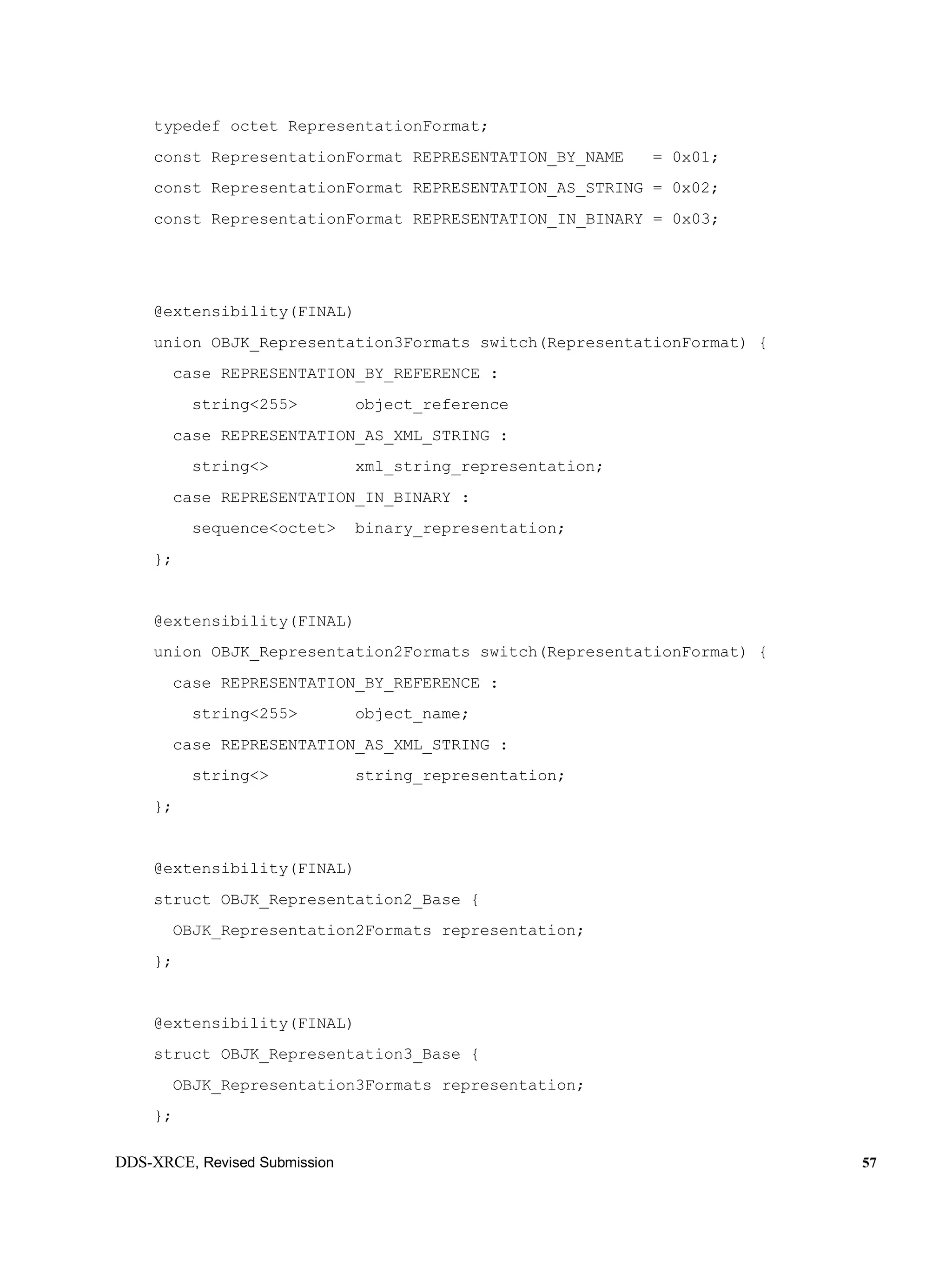
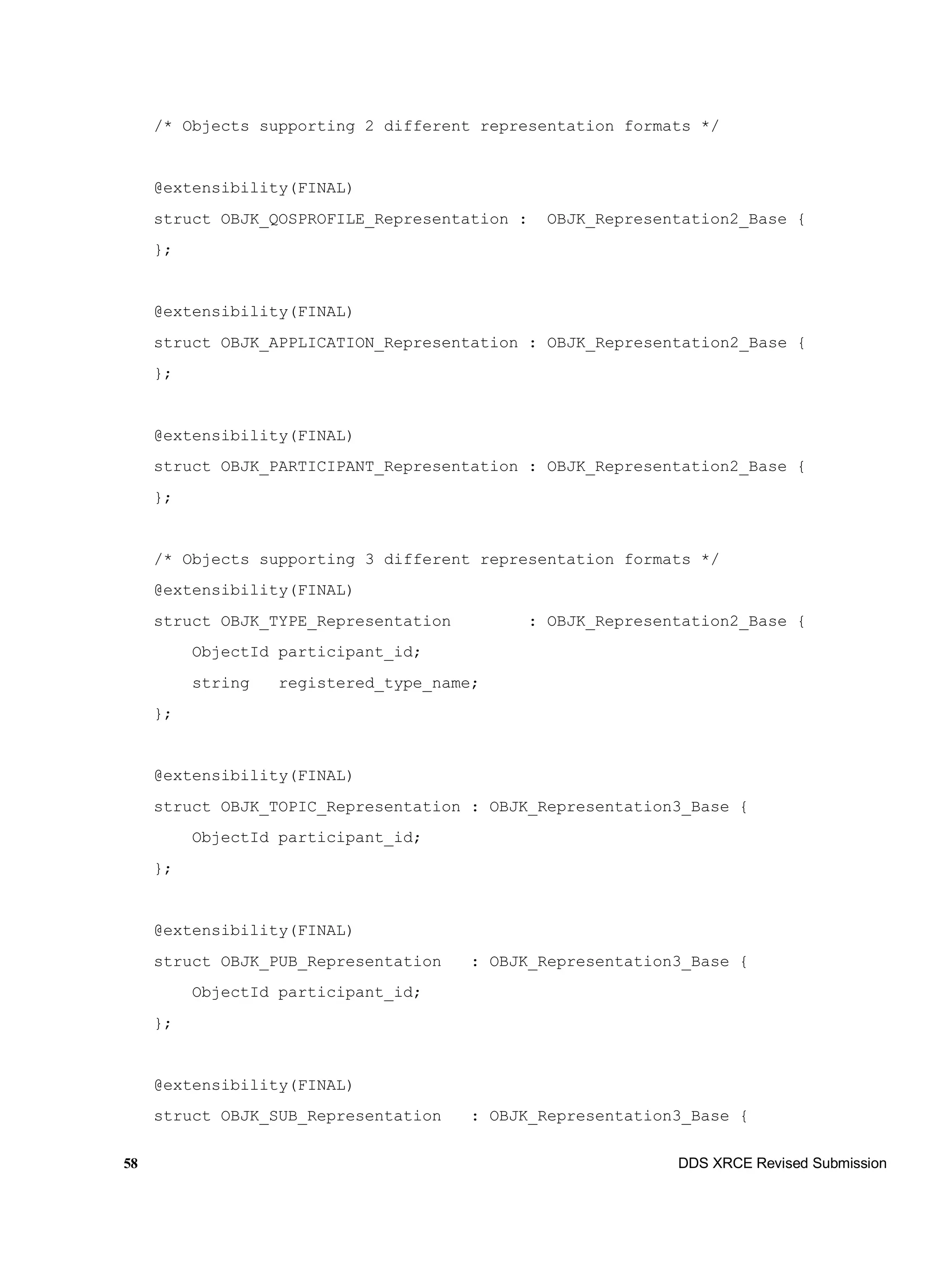

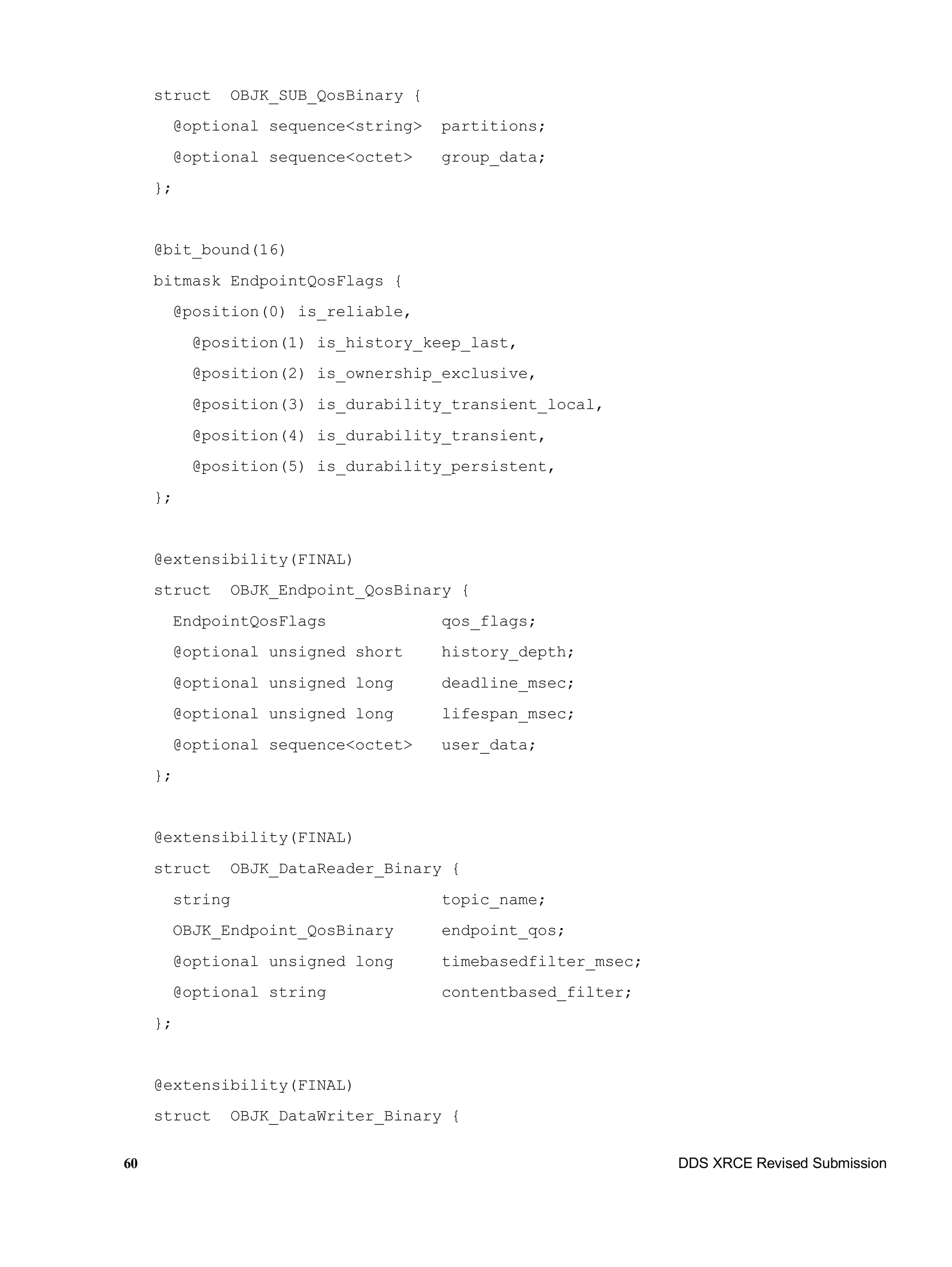

![62 DDS XRCE Revised Submission
typedef octet RequestId[2];
struct ResultStatus {
RequestId request_id;
octet status;
octet implementation_status;
};
const octet STATUS_OK = 0x00;
const octet STATUS_OK_MATCHED = 0x01;
const octet STATUS_ERR_DDS_ERROR = 0x80;
const octet STATUS_ERR_MISMATCH = 0x81;
const octet STATUS_ERR_ALREADY_EXISTS = 0x82;
const octet STATUS_ERR_DENIED = 0x83;
const octet STATUS_ERR_UNKNOWN_REFERENCE = 0x84;
const octet STATUS_ERR_INVALID_DATA = 0x85;
const octet STATUS_ERR_INCOMPATIBLE = 0x86;
const octet STATUS_ERR_RESOURCES = 0x87;
const octet STATUS_LAST_OP_NONE = 0;
const octet STATUS_LAST_OP_CREATE = 1;
const octet STATUS_LAST_OP_UPDATE = 2;
const octet STATUS_LAST_OP_DELETE = 3;
const octet STATUS_LAST_OP_LOOKUP = 4;
const octet STATUS_LAST_OP_READ = 5;
const octet STATUS_LAST_OP_WRITE = 6;
bitmask InfoMask {
@position(0) INFO_CONFIGURATION,
@position(1) INFO_ACTIVITY
};](https://image.slidesharecdn.com/ddsxrcemars-17-09-18-171006013244/75/DDS-for-eXtremely-Resource-Constrained-Environments-68-2048.jpg)

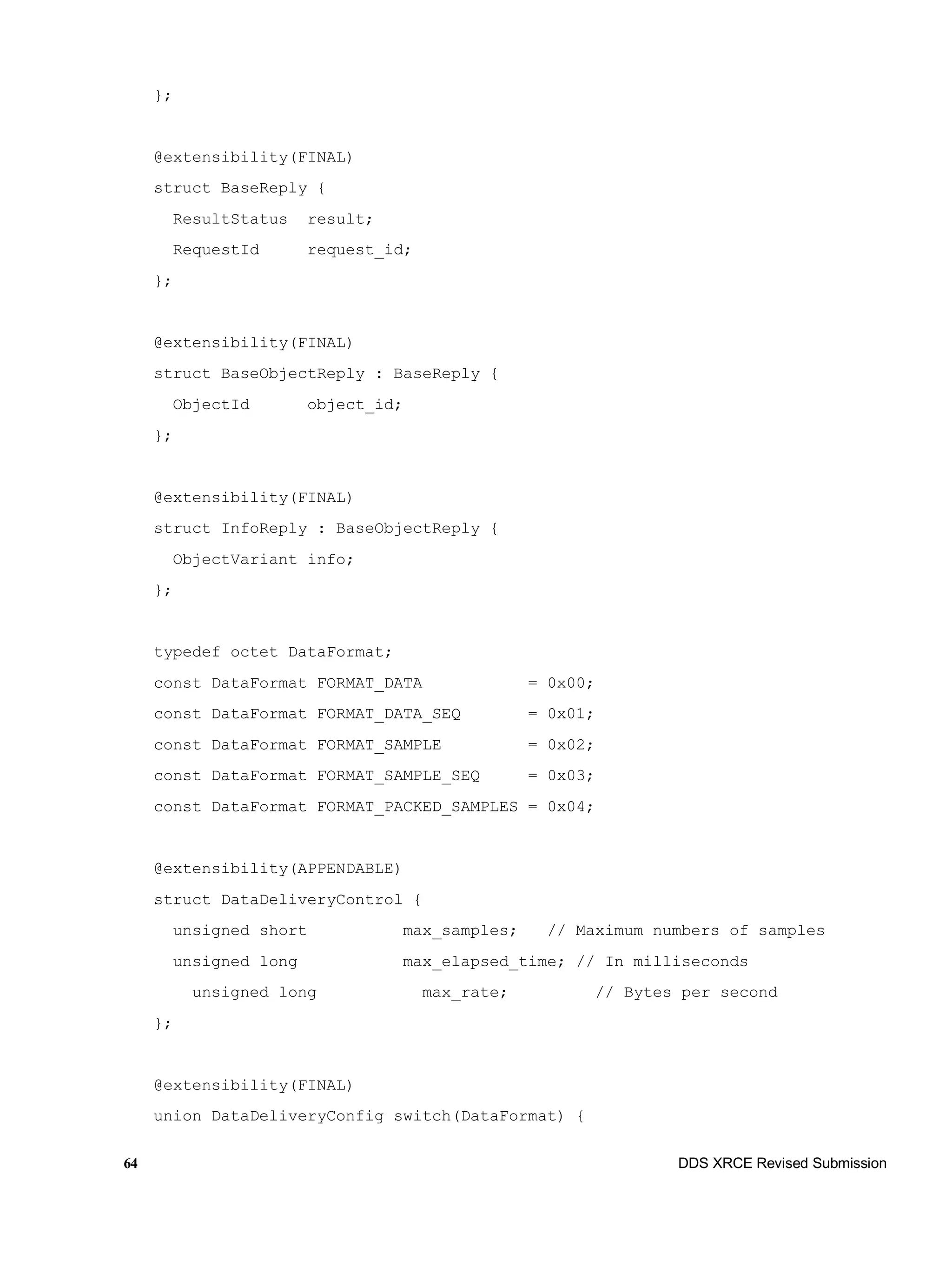
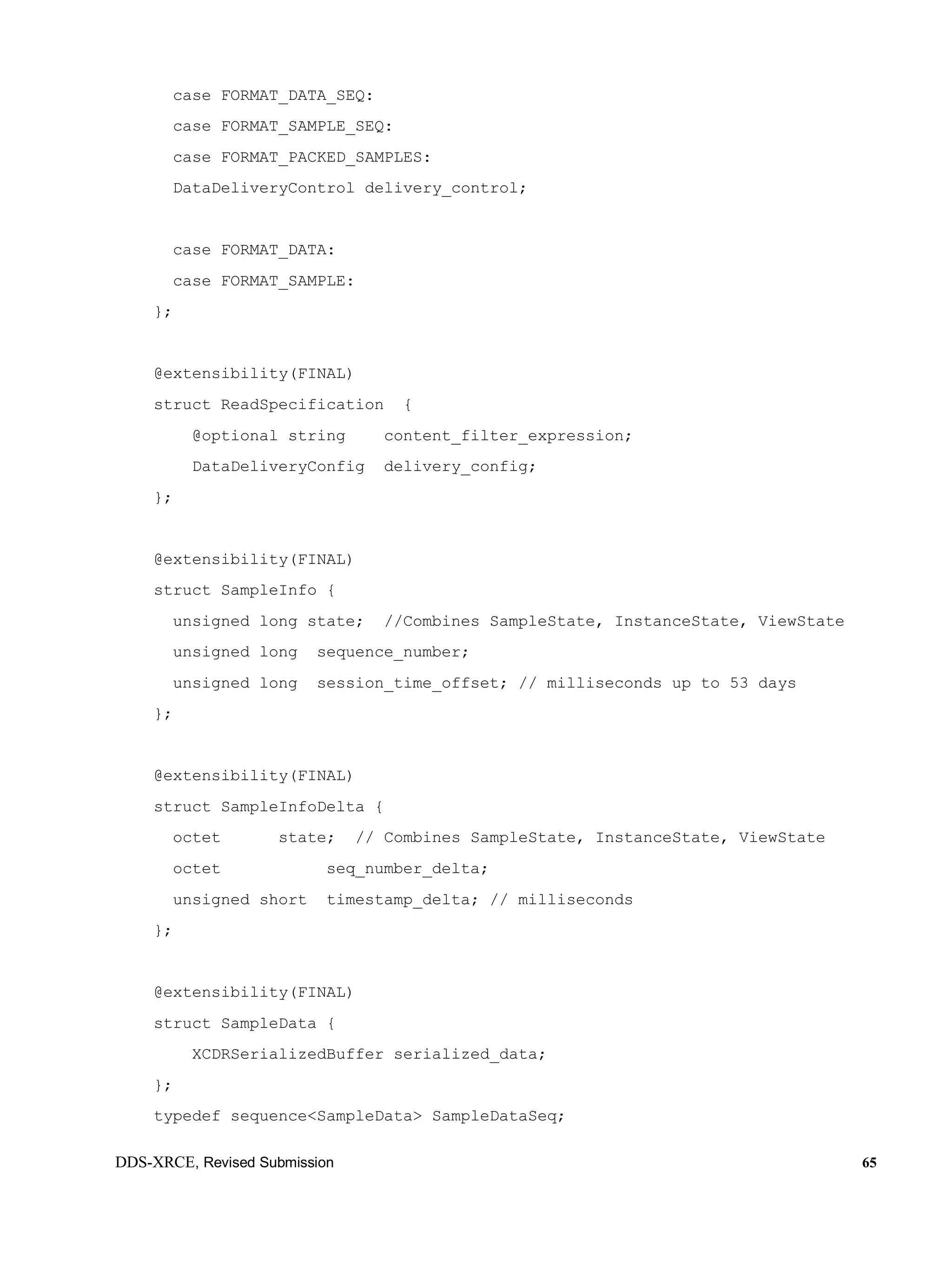
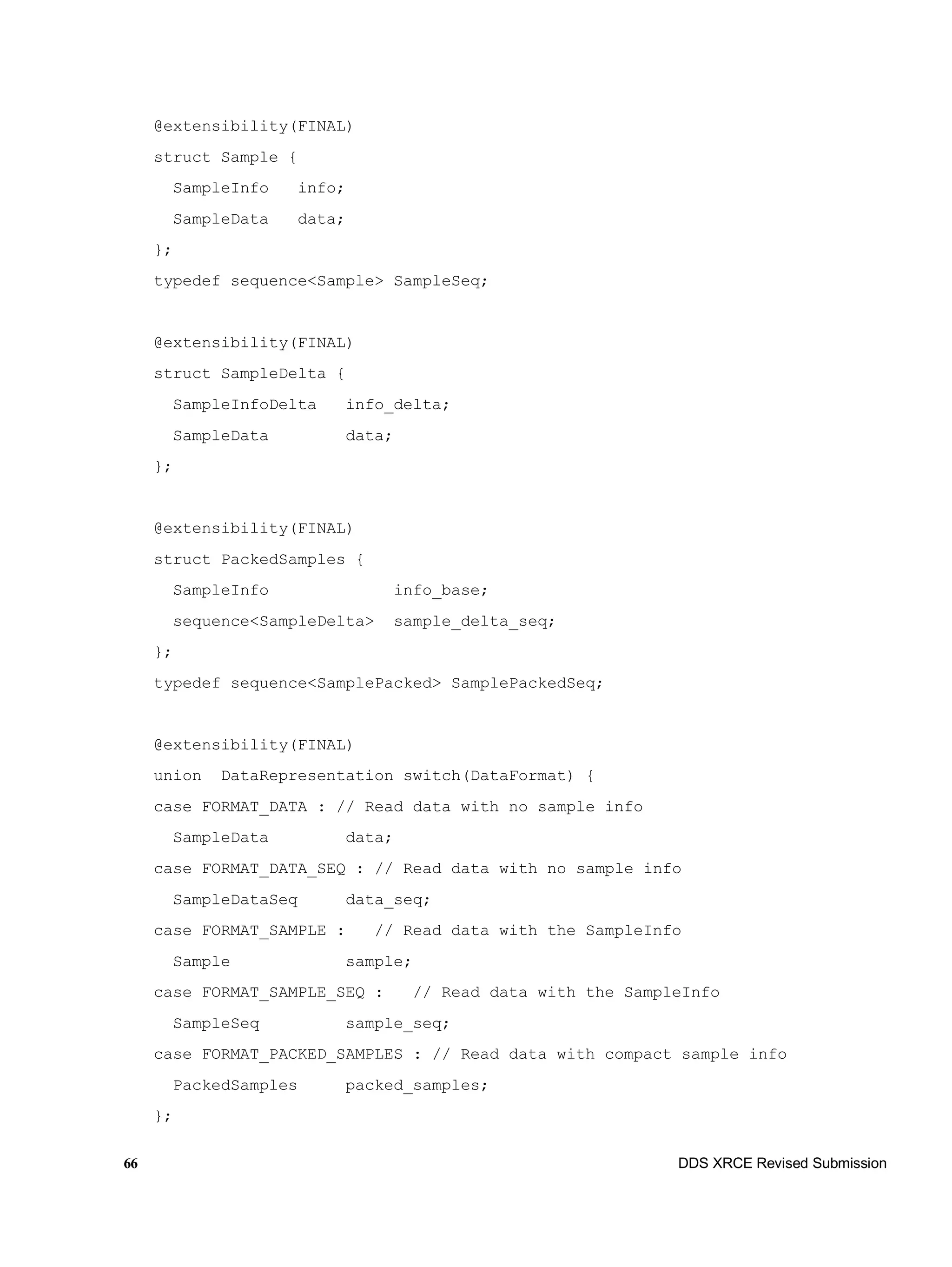
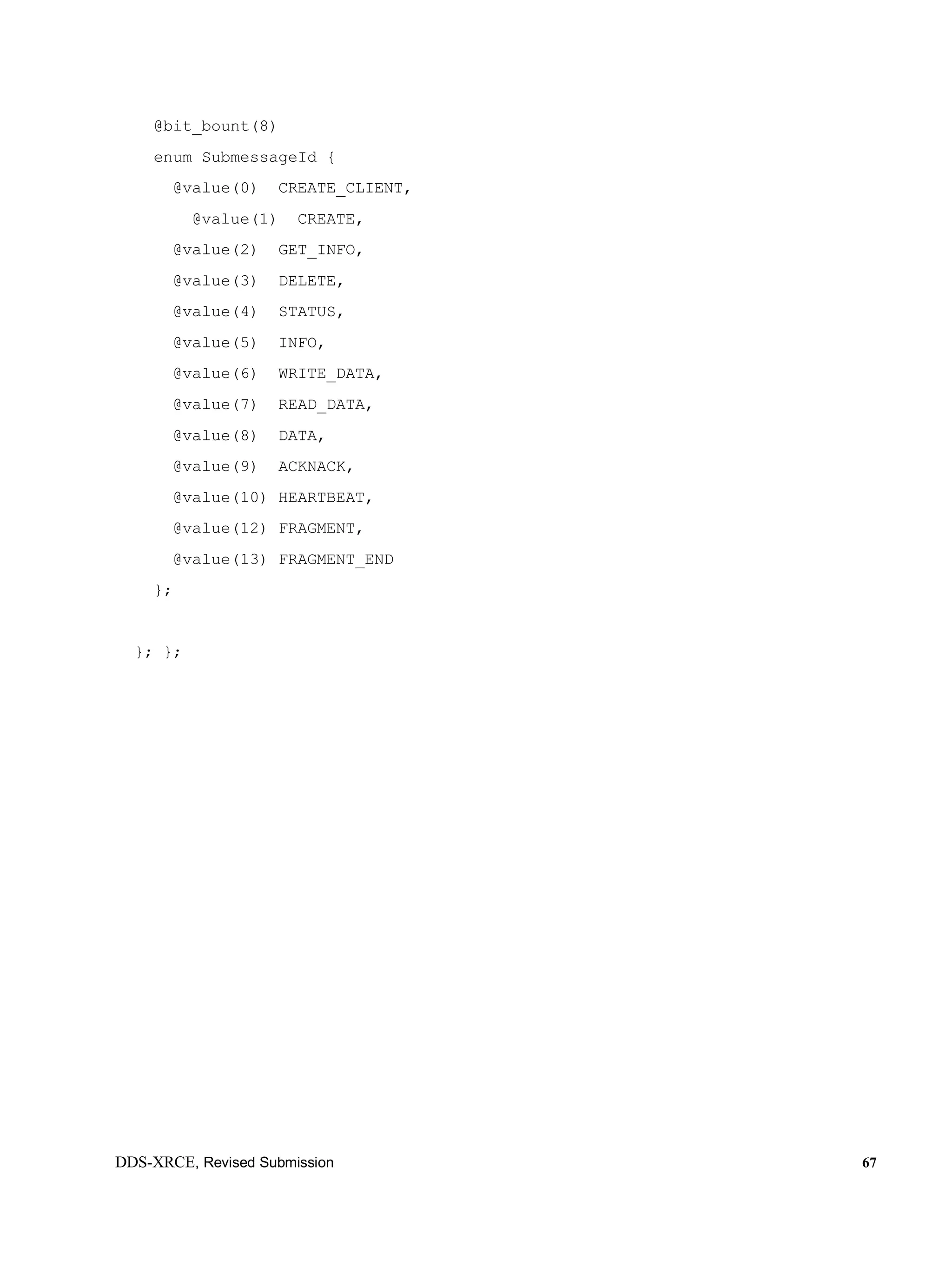
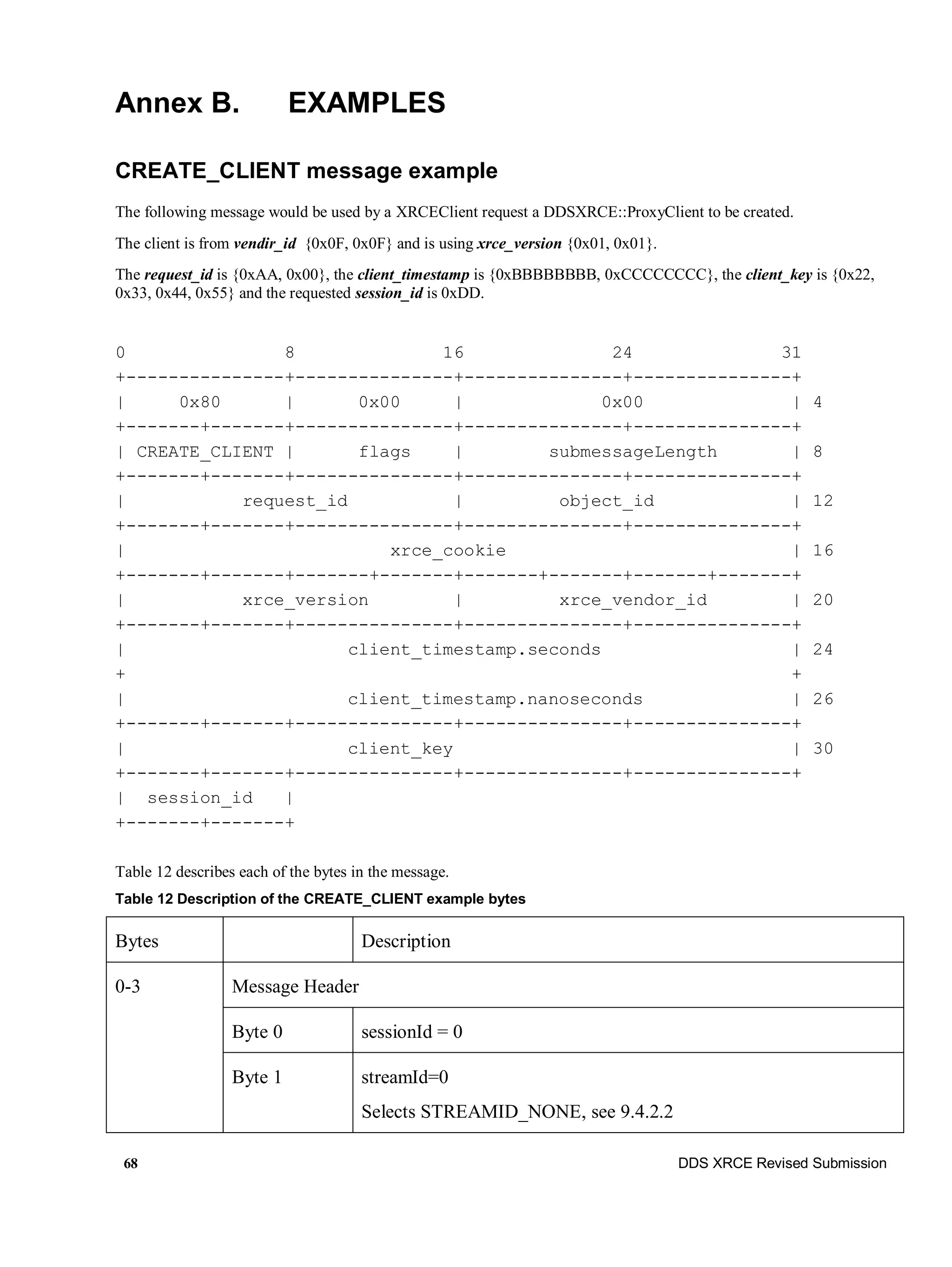
![DDS-XRCE, Revised Submission 69
Bytes 2-3 sequenceNr = 0
4-7 Submessage Header
Byte 4 submessageId = CREATE_CLIENT = 0x00
See 9.4.5
Byte 5 flags = 0x07 (reuse, replace, little endian)
Bytes 6-7 submessageLength = 25 = 0x0019
Represented in little endian as {0x19, 0x00}
8-25 OBJK_CLIENT_Representation
Bytes 8-9 request_id = {0xAA , 0x00}
Bytes 10-11 object_id = {0xFF, 0xFF}
Set to OBJECTID_CLIENT, see 8.4.
Bytes 12-15 xrce_cookie = { ‘X’, ‘R’, ‘C’, ‘E’ }
Bytes 16-17 xrce_version = {0x01, 0x00}
Bytes 18-19 xrce_vendor_id = {0x0F, 0x0F]
Bytes 20-25 client_timestamp
Since flags has the Endianess bit set to 1 the timestamp is
represented as little endian.
Bytes 26-29 client_key = {0x22, 0x33, 0x44, 0x55}
30 Byte 30 The requested session_id = 0xDD](https://image.slidesharecdn.com/ddsxrcemars-17-09-18-171006013244/75/DDS-for-eXtremely-Resource-Constrained-Environments-75-2048.jpg)
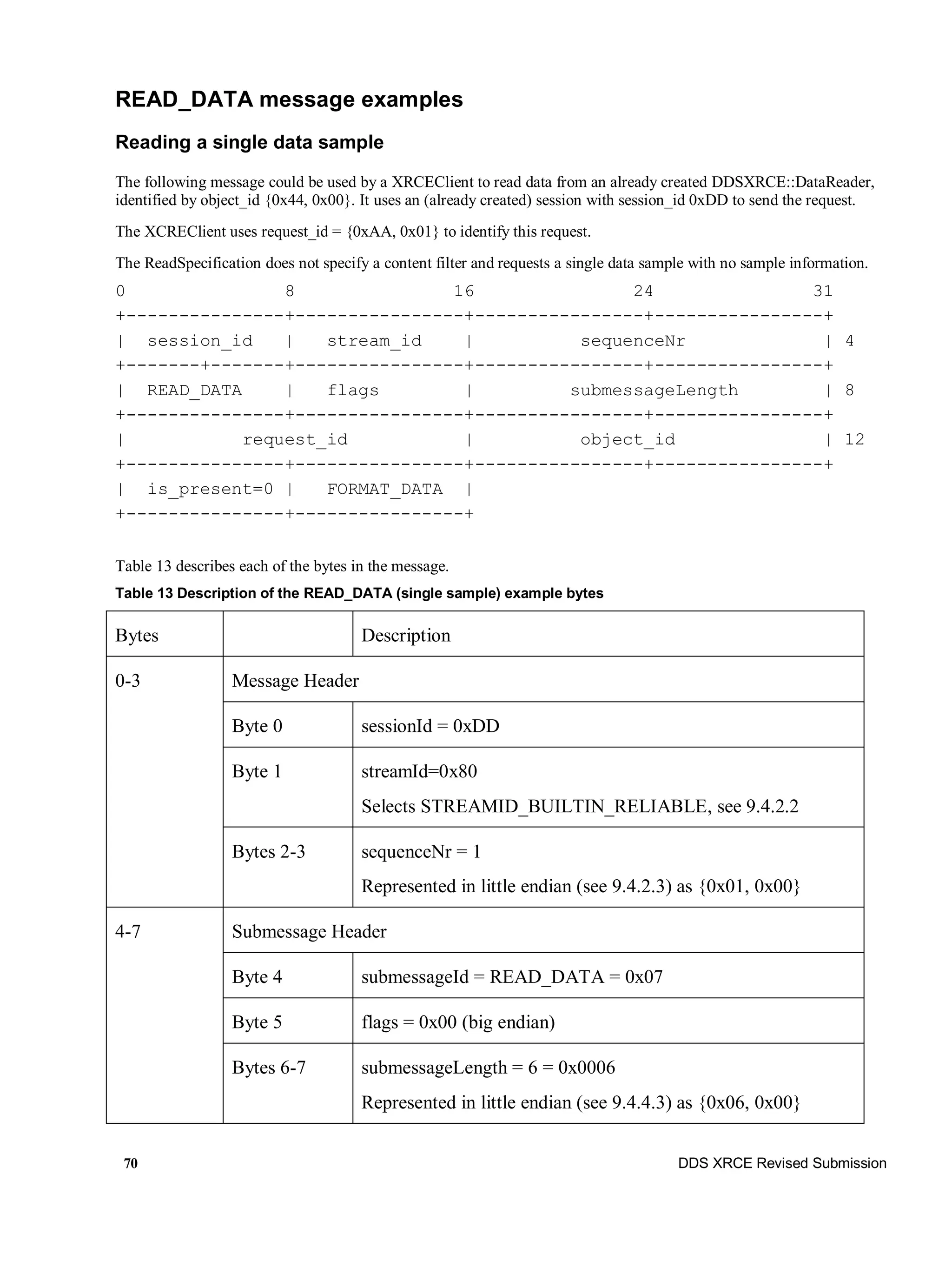


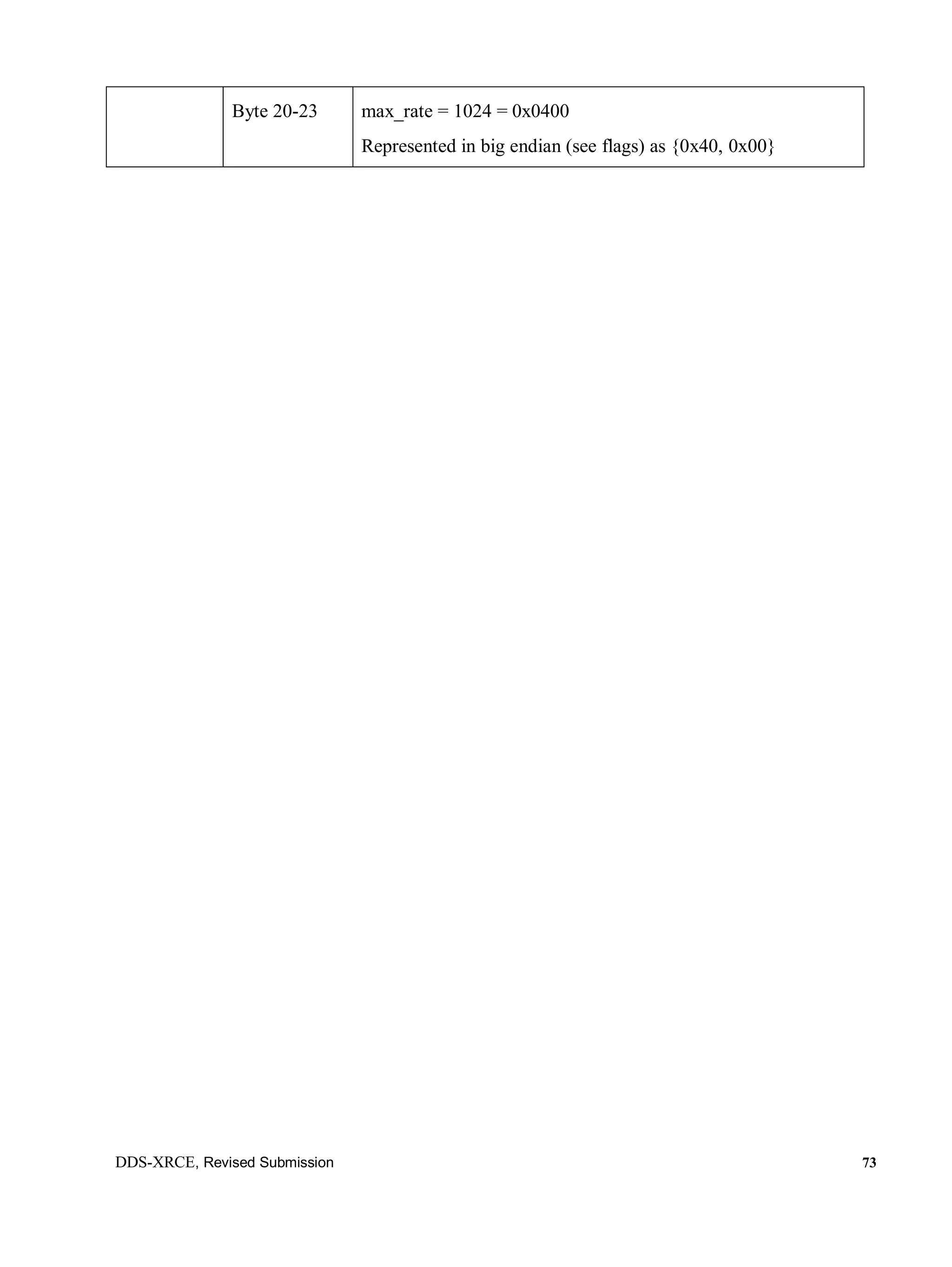
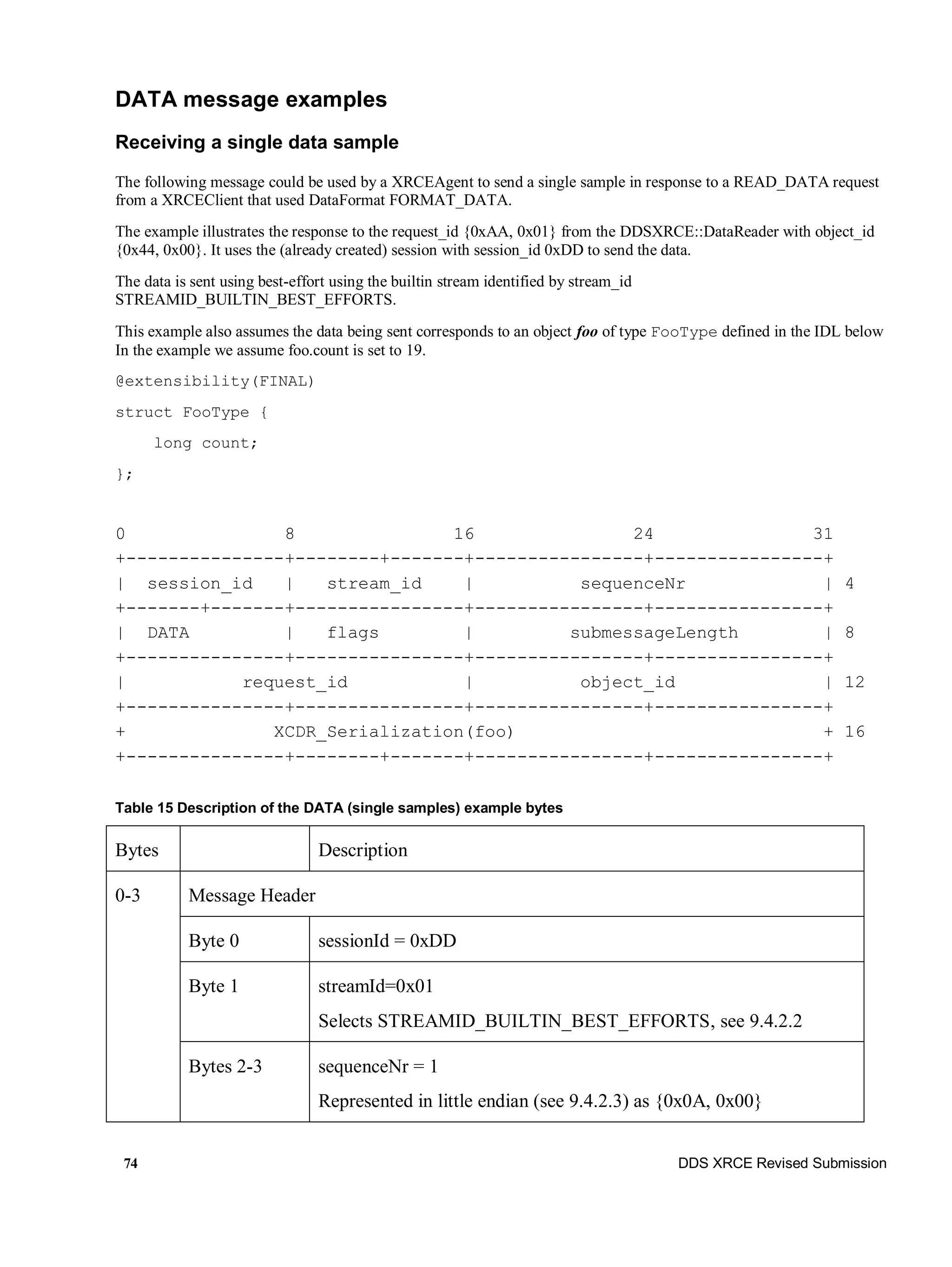
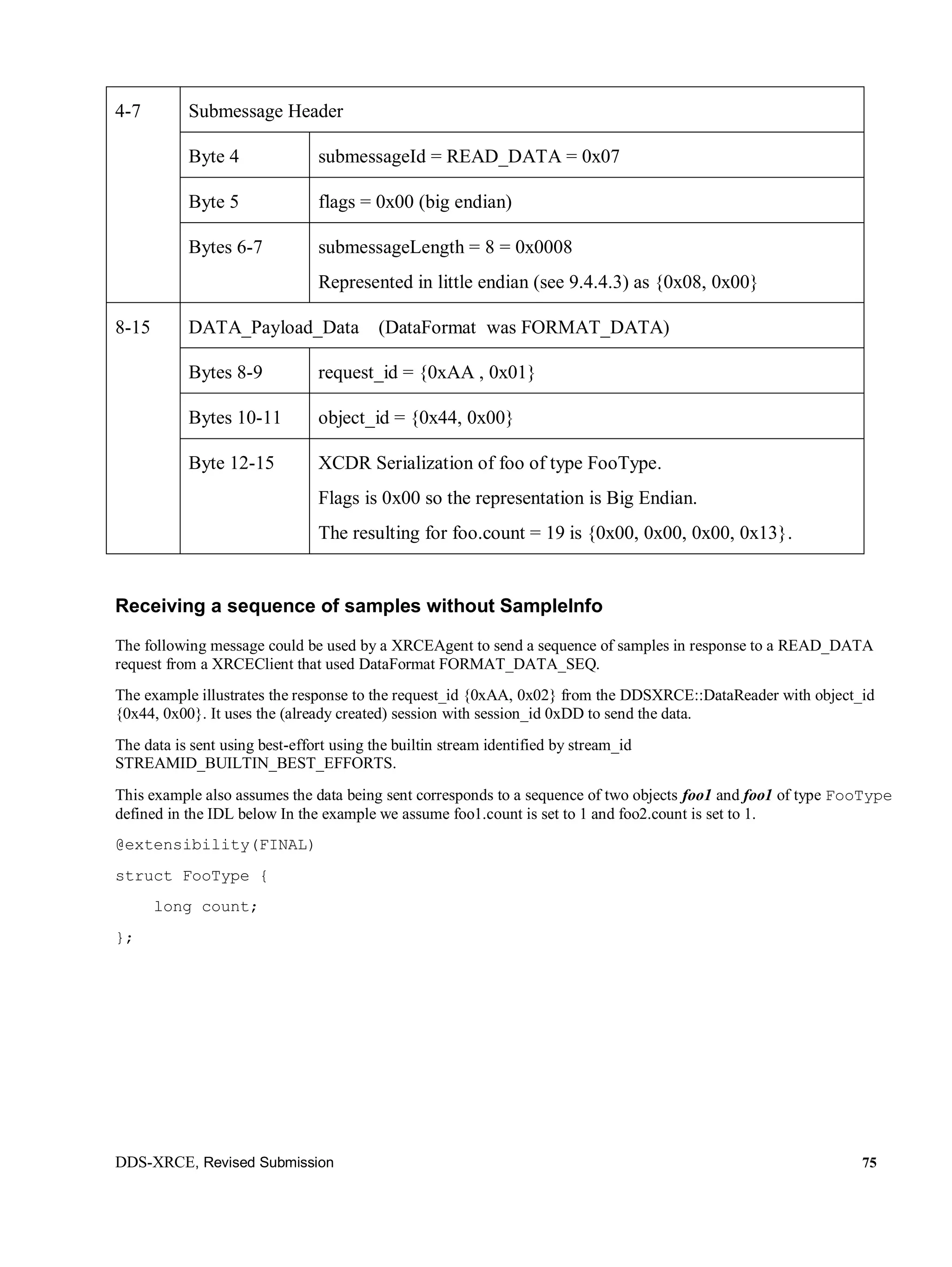
![76 DDS XRCE Revised Submission
0 8 16 24 31
+---------------+--------+-------+----------------+----------------+
| session_id | stream_id | sequenceNr | 4
+-------+-------+----------------+----------------+----------------+
| DATA | flags | submessageLength | 8
+---------------+----------------+----------------+----------------+
| request_id | object_id | 12
+---------------+----------------+----------------+----------------+
~ XDR_Serialization(DATA_Payload_SampleSeq) ~
+-------+-------+----------------+----------------+----------------+
The serialization of DATA_Payload_SampleSeq can be expanded as:
0 8 16 24 31
+---------------+--------+-------+----------------+----------------+
| data_seq.length = 2 | 4
+-------+-------+----------------+----------------+----------------+
| data_seq[0].data (foo1.count = 1) | 8
+---------------+----------------+----------------+----------------+
| data_seq[1].data (foo1.count = 2) | 12
+---------------+----------------+----------------+----------------+
Table 16 Description of the DATA (sample sequence) example bytes
Bytes Description
0-3 Message Header
Byte 0 sessionId = 0xDD
Byte 1 streamId=0x01
Selects STREAMID_BUILTIN_BEST_EFFORTS, see 9.4.2.2
Bytes 2-3 sequenceNr = 1
Represented in little endian (see 9.4.2.3) as {0x0A, 0x00}
4-7 Submessage Header
Byte 4 submessageId = DATA = 0x08
Byte 5 flags = 0x00 (big endian)
Bytes 6-7 submessageLength = 16 = 0x0010](https://image.slidesharecdn.com/ddsxrcemars-17-09-18-171006013244/75/DDS-for-eXtremely-Resource-Constrained-Environments-82-2048.jpg)
![DDS-XRCE, Revised Submission 77
Represented in little endian (see 9.4.4.3) as {0x10, 0x00}
8-23 DATA_Payload_DataSeq (DataFormat was FORMAT_DATA_SEQ)
Bytes 8-9 request_id = {0xAA , 0x01}
Bytes 10-11 object_id = {0x44, 0x00}
Bytes 12-15 data_seq.length = 2
Bytes 16-19 data_seq[0].data
Bytes 20-23 data_seq[1].data
Receiving a sequence of samples that includes SampleInfo
The following message could be used by a XRCEAgent to send a sequence of samples in response to a READ_DATA
request from a XRCEClient that used DataFormat FORMAT_SAMPLE_SEQ.
The example illustrates the response to the request_id {0xAA, 0x02} from the DDSXRCE::DataReader with object_id
{0x44, 0x00}. It uses the (already created) session with session_id 0xDD to send the data.
The data is sent using best-effort using the builtin stream identified by stream_id
STREAMID_BUILTIN_BEST_EFFORTS.
This example also assumes the data being sent corresponds to a sequence of two objects foo1 and foo1 of type FooType
defined in the IDL below In the example we assume foo1.count is set to 1 and foo2.count is set to 1.
@extensibility(FINAL)
struct FooType {
long count;
};
0 8 16 24 31
+---------------+--------+-------+----------------+----------------+
| session_id | stream_id | sequenceNr | 4
+-------+-------+----------------+----------------+----------------+
| DATA | flags | submessageLength | 8
+---------------+----------------+----------------+----------------+
| request_id | object_id | 12
+---------------+----------------+----------------+----------------+
~ XDR_Serialization(DATA_Payload_SampleSeq) ~
+-------+-------+----------------+----------------+----------------+
The serialization of DATA_Payload_SampleSeq can be expanded as:](https://image.slidesharecdn.com/ddsxrcemars-17-09-18-171006013244/75/DDS-for-eXtremely-Resource-Constrained-Environments-83-2048.jpg)
![78 DDS XRCE Revised Submission
0 8 16 24 31
+---------------+--------+-------+----------------+----------------+
| sample_seq.length = 2 | 4
+-------+-------+----------------+----------------+----------------+
| sample_seq[0].info.state | 8
+---------------+----------------+----------------+----------------+
| sample_seq[0].info.sequence_number | 12
+---------------+----------------+----------------+----------------+
| sample_seq[0].info.session_time_offset | 16
+---------------+----------------+----------------+----------------+
| sample_seq[0].data (foo1.count = 1) | 20
+-------+-------+----------------+----------------+----------------+
| sample_seq[1].info.state | 24
+---------------+----------------+----------------+----------------+
| sample_seq[1].info.sequence_number | 28
+---------------+----------------+----------------+----------------+
| sample_seq[1].info.session_time_offset | 32
+---------------+----------------+----------------+----------------+
| sample_seq[1].data (foo1.count = 2) | 36
+---------------+----------------+----------------+----------------+
Table 17 Description of the DATA (sample sequence) example bytes
Bytes Description
0-3 Message Header
Byte 0 sessionId = 0xDD
Byte 1 streamId=0x01
Selects STREAMID_BUILTIN_BEST_EFFORTS, see 9.4.2.2
Bytes 2-3 sequenceNr = 1
Represented in little endian (see 9.4.2.3) as {0x0A, 0x00}
4-7 Submessage Header
Byte 4 submessageId = DATA = 0x08
Byte 5 flags = 0x00 (big endian)
Bytes 6-7 submessageLength = 40 = 0x0028](https://image.slidesharecdn.com/ddsxrcemars-17-09-18-171006013244/75/DDS-for-eXtremely-Resource-Constrained-Environments-84-2048.jpg)
![DDS-XRCE, Revised Submission 79
Represented in little endian (see 9.4.4.3) as {0x28, 0x00}
8-47 DATA_Payload_SampleSeq (DataFormat was FORMAT_SAMPLE_SEQ)
Bytes 8-9 request_id = {0xAA , 0x01}
Bytes 10-11 object_id = {0x44, 0x00}
Bytes 12-15 sample_seq.length = 2
Bytes 16-27 sample_seq[0].info
Bytes 28-31 sample_seq[0].data
Bytes 32-43 sample_seq[1].info
Bytes 44-47 sample_seq[1].data
Receiving a sequence of packed samples
The following message could be used by a XRCEAgent to send a sequence of samples in response to a READ_DATA
request from a XRCEClient that used DataFormat FORMAT_PACKED_SAMPLES.
The example illustrates the response to the request_id {0xAA, 0x03} from the DDSXRCE::DataReader with object_id
{0x44, 0x00}. It uses the (already created) session with session_id 0xDD to send the data.
The data is sent using a reliable protocol using the builtin stream identified by stream_id
STREAMID_BUILTIN_RELIABLE.
This example also assumes the data being sent corresponds to a sequence of two objects foo1 and foo1 of type FooType
defined in the IDL below In the example we assume foo1.count is set to 1 and foo2.count is set to 1.
@extensibility(FINAL)
struct FooType {
long count;
};](https://image.slidesharecdn.com/ddsxrcemars-17-09-18-171006013244/75/DDS-for-eXtremely-Resource-Constrained-Environments-85-2048.jpg)
![80 DDS XRCE Revised Submission
0 8 16 24 31
+---------------+--------+-------+----------------+----------------+
| session_id | stream_id | sequenceNr | 4
+-------+-------+----------------+----------------+----------------+
| DATA | flags | submessageLength | 8
+---------------+----------------+----------------+----------------+
| request_id | object_id | 12
+---------------+----------------+----------------+----------------+
~ XDR_Serialization(DATA_Payload_PackedSamples) ~
+-------+-------+----------------+----------------+----------------+
The serialization of DATA_Payload_SamplePackedSeq can be expanded as:
0 8 16 24 31
+---------------+--------+-------+----------------+----------------+
| info_base.state | 4
+---------------+----------------+----------------+----------------+
| info_base.sequence_number | 8
+---------------+----------------+----------------+----------------+
| info_base.session_time_offset | 12
+-------+-------+----------------+----------------+----------------+
| sample_delta_seq.length = 2 | 16
+-------+-------+----------------+----------------+----------------+
| sample_delta_seq[0].info_delta | 20
+---------------+----------------+----------------+----------------+
| sample_delta_seq[0].data (foo1.count = 1) | 24
+-------+-------+----------------+----------------+----------------+
| sample_delta_seq[1].info_delta | 28
+---------------+----------------+----------------+----------------+
| sample_delta_seq[1].data (foo1.count = 2) | 32
+---------------+----------------+----------------+----------------+
Table 18 Description of the DATA (packed samples) example bytes
Bytes Description
0-3 Message Header
Byte 0 sessionId = 0xDD
Byte 1 streamId=0x80
Selects STREAMID_BUILTIN_RELIABLE, see 9.4.2.2](https://image.slidesharecdn.com/ddsxrcemars-17-09-18-171006013244/75/DDS-for-eXtremely-Resource-Constrained-Environments-86-2048.jpg)
![DDS-XRCE, Revised Submission 81
Bytes 2-3 sequenceNr = 1
Represented in little endian (see 9.4.2.3) as {0x0A, 0x00}
4-7 Submessage Header
Byte 4 submessageId = DATA = 0x08
Byte 5 flags = 0x00 (big endian)
Bytes 6-7 submessageLength = 36 = 0x0024
Represented in little endian (see 9.4.4.3) as {0x24, 0x00}
8-47 DATA_Payload_PackedSample (DataFormat FORMAT_PACKED_SAMPLES)
Byte 8-19 info_base
Bytes 20-23 sample_delta_seq.length = 2
Bytes 24-27 sample_delta_seq[0].info_delta
Bytes 28-31 sample_delta_seq [0].data
Bytes 32-35 sample_delta_seq [1].info_delta
Bytes 36-39 sample_delta_seq [1].data](https://image.slidesharecdn.com/ddsxrcemars-17-09-18-171006013244/75/DDS-for-eXtremely-Resource-Constrained-Environments-87-2048.jpg)